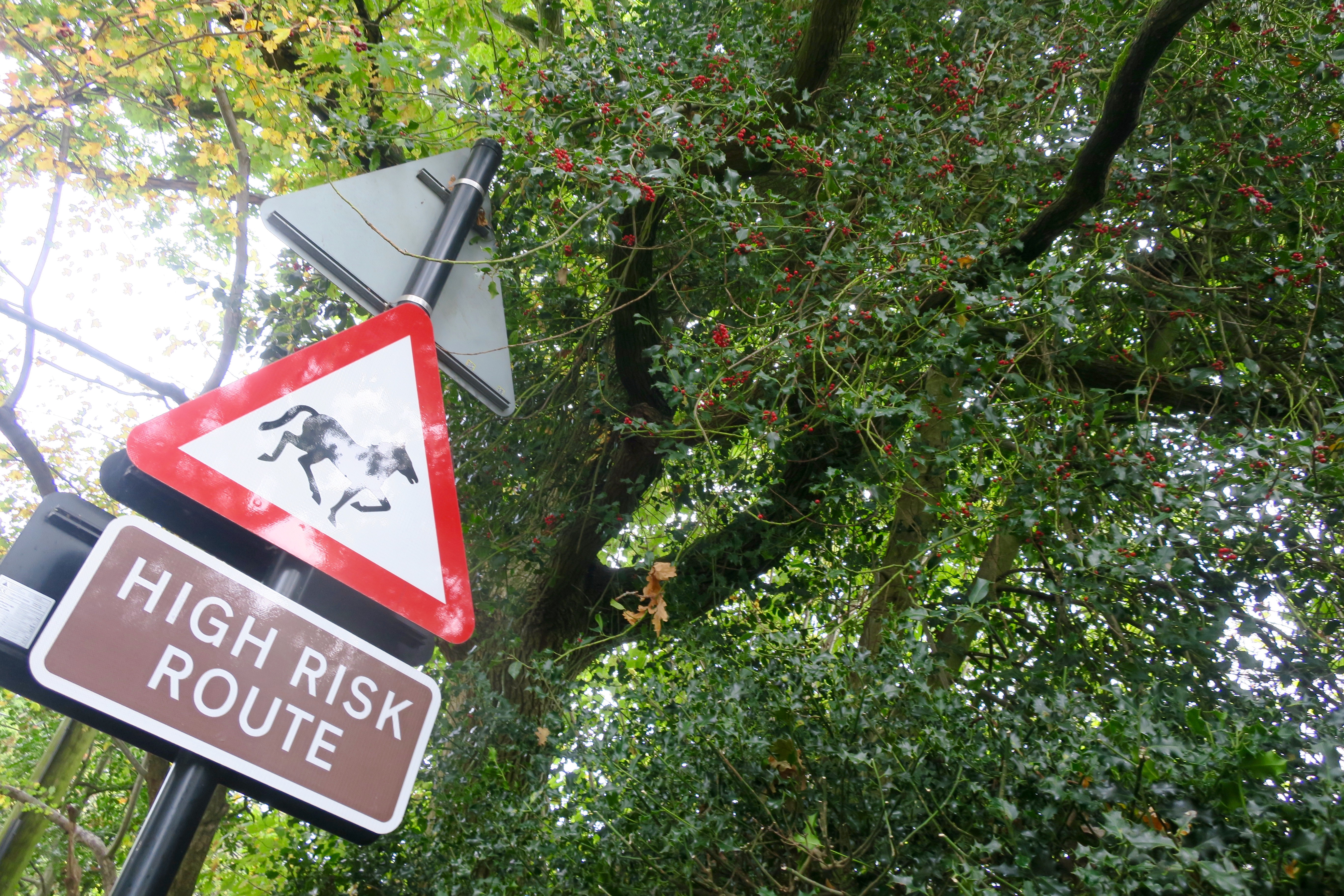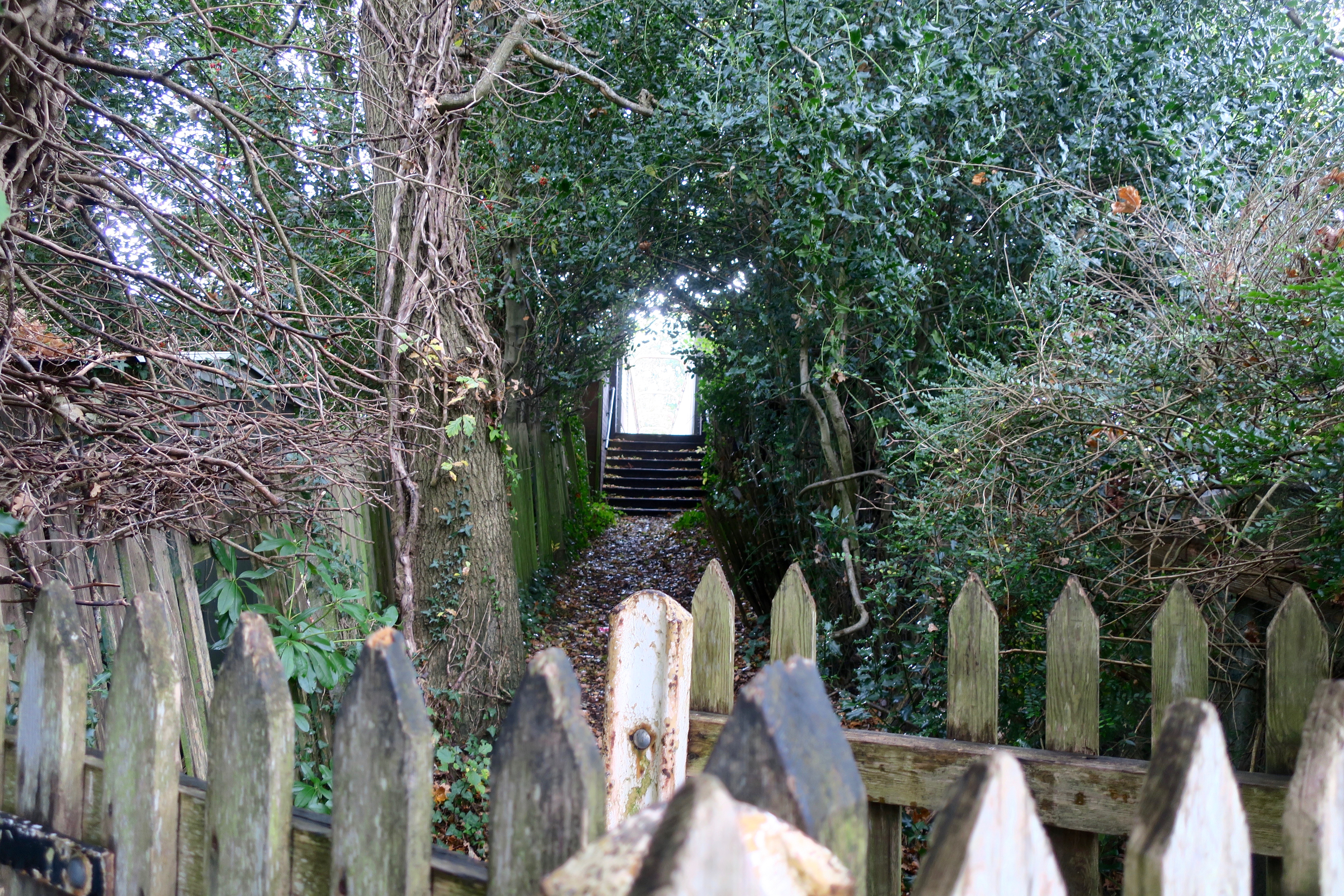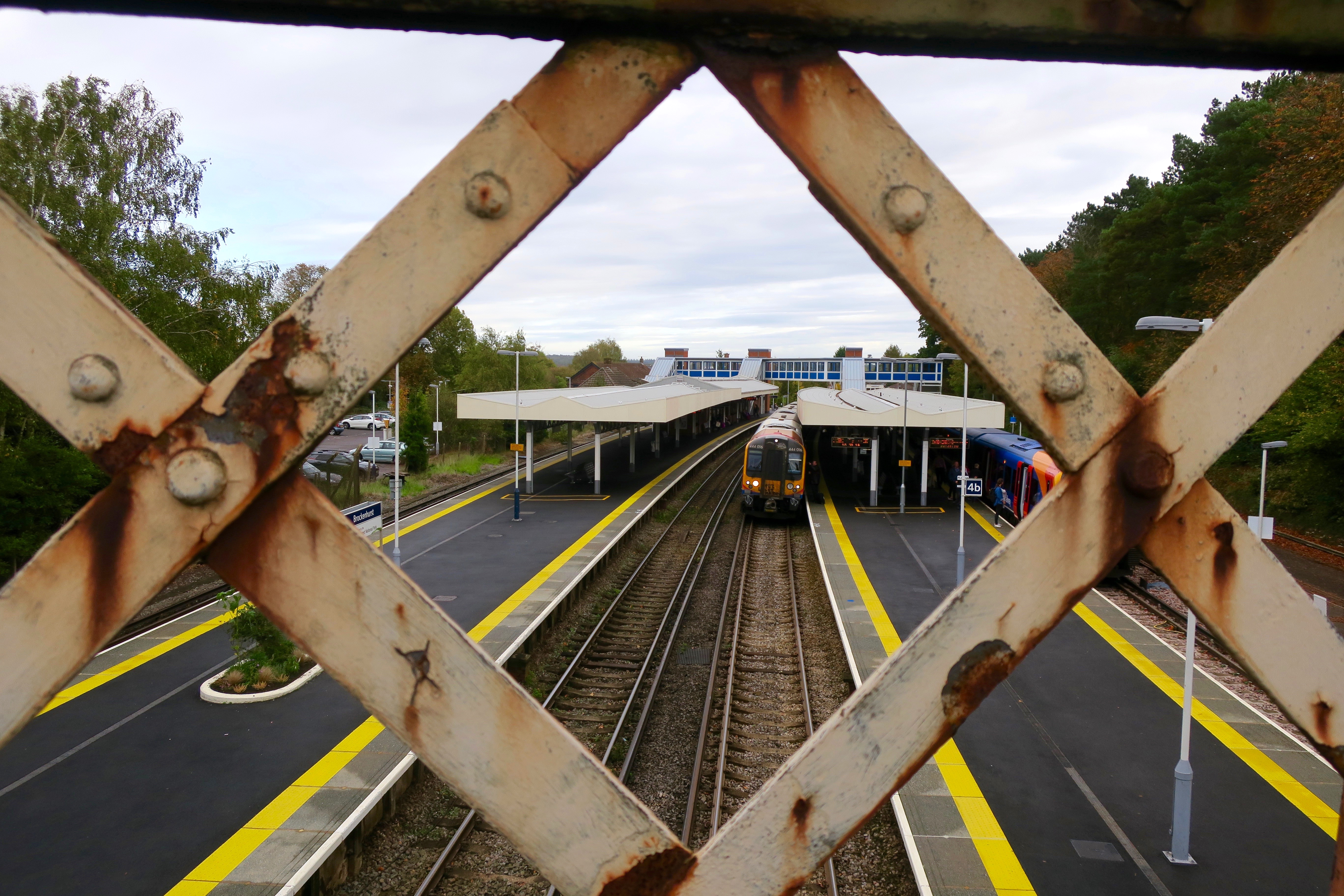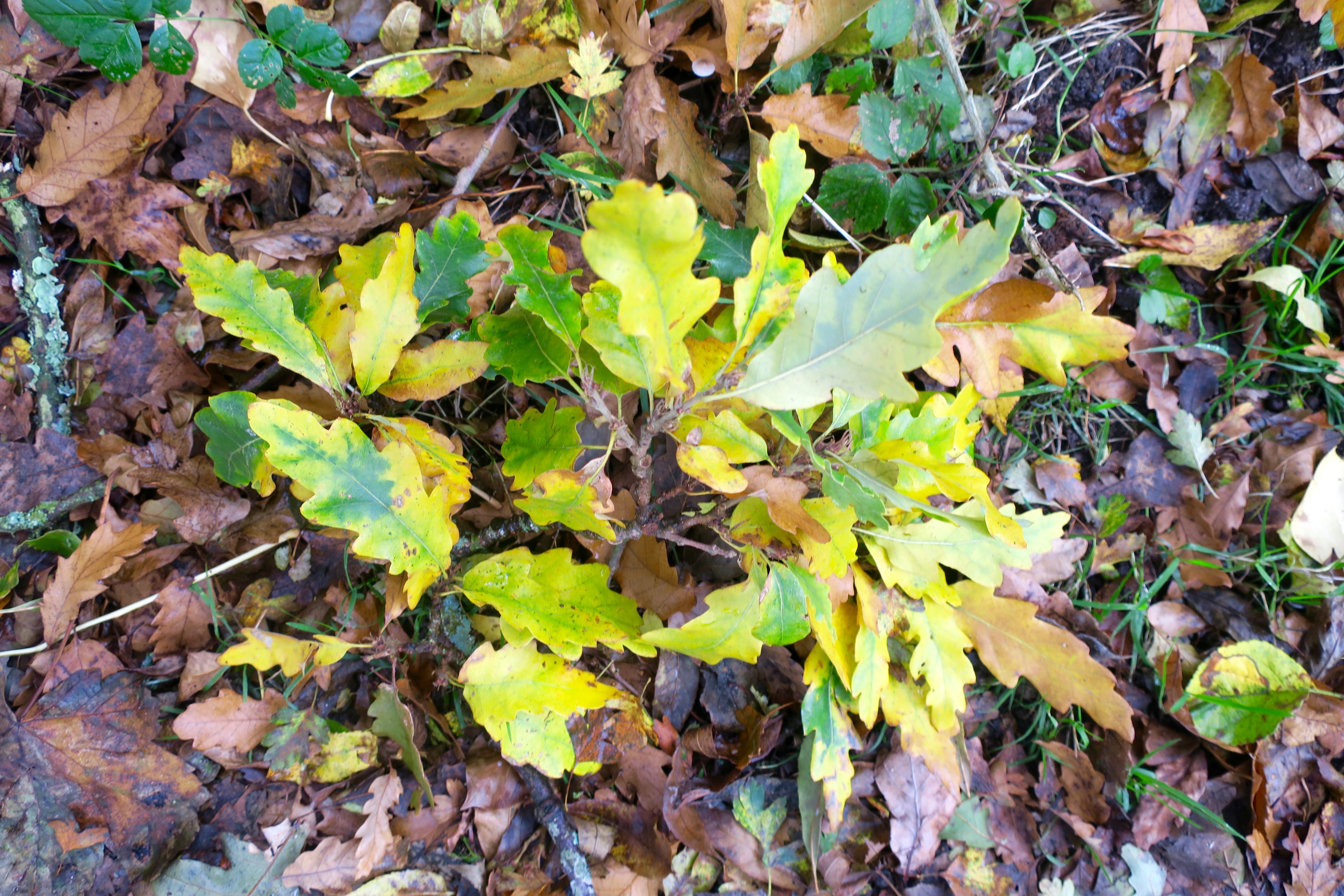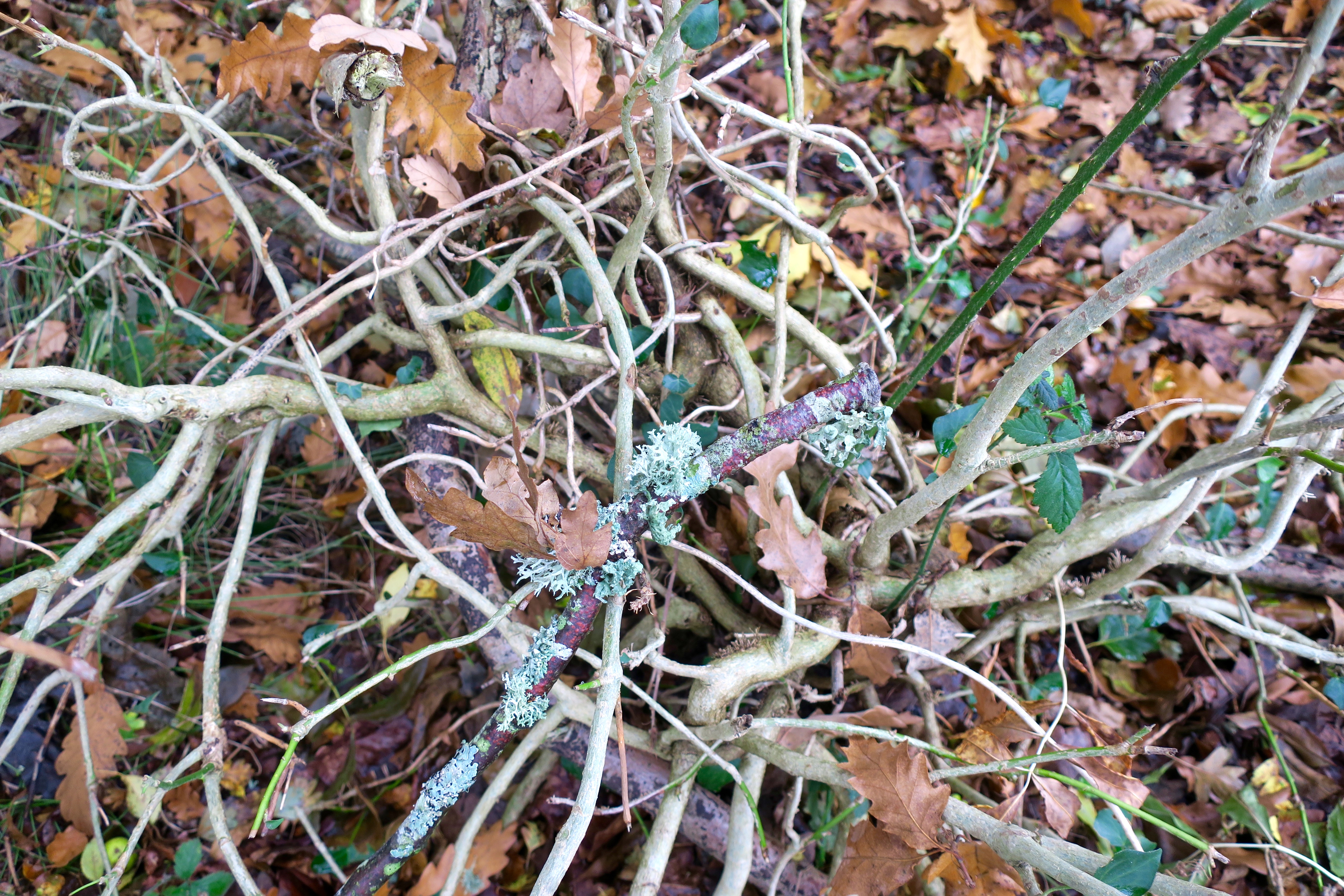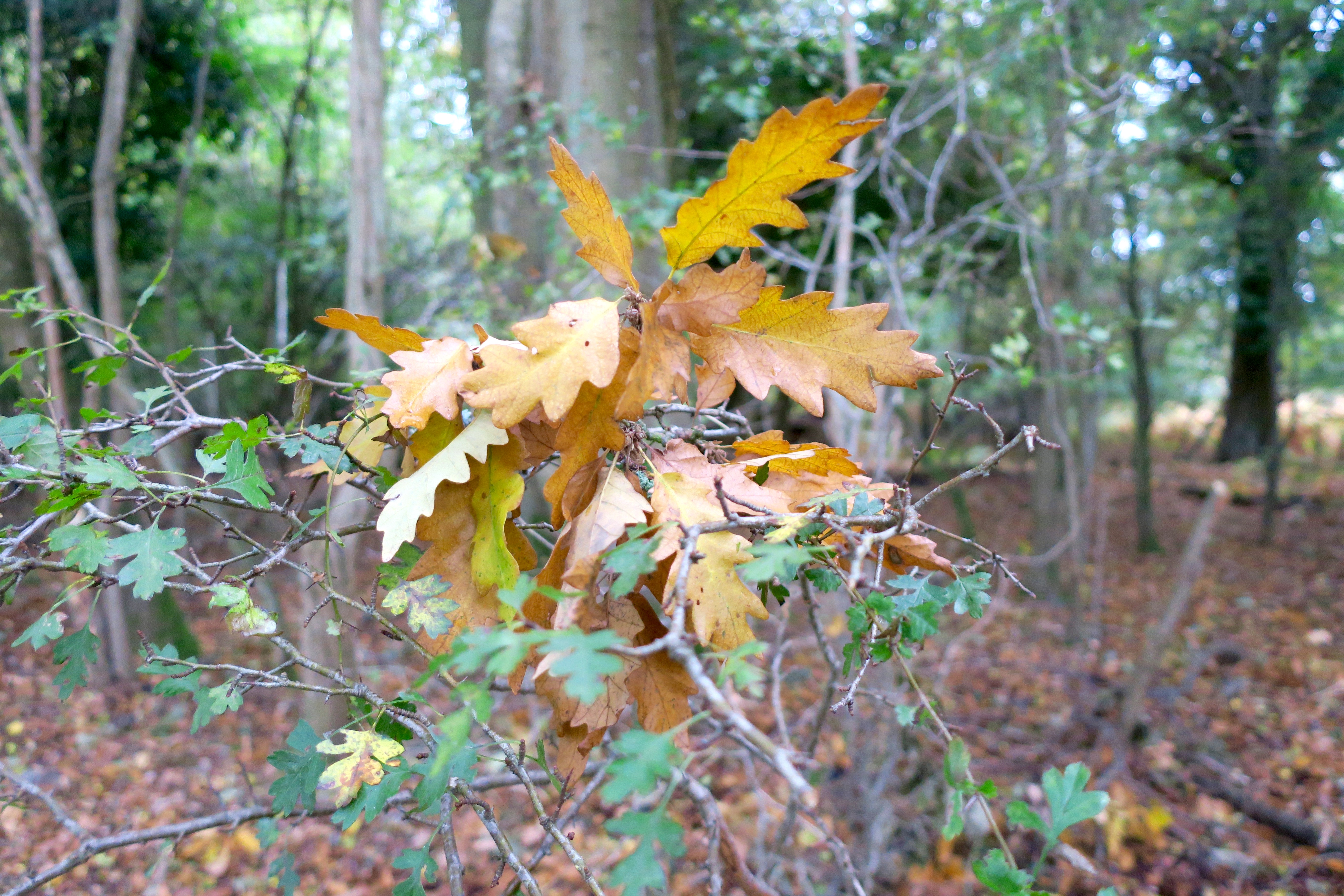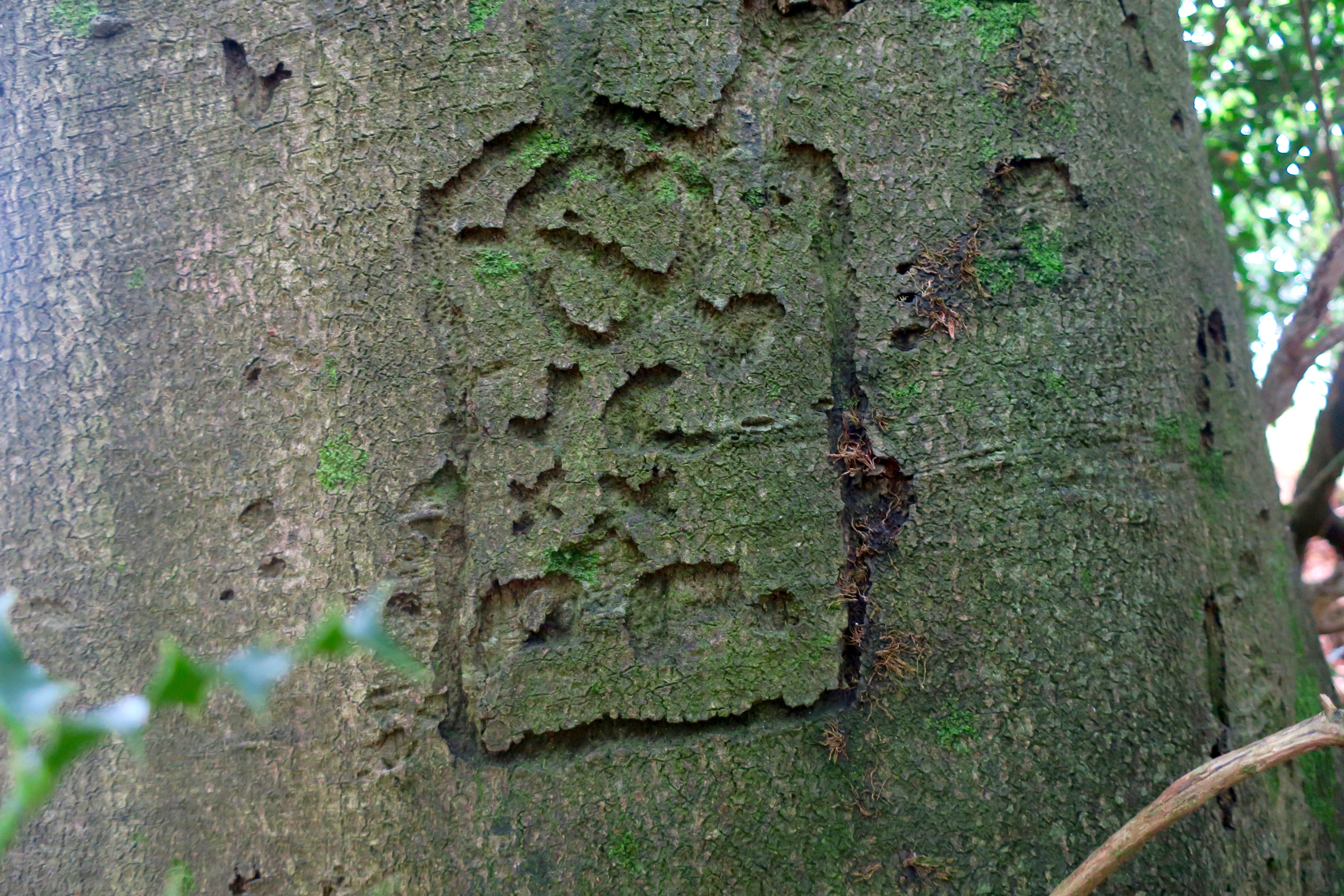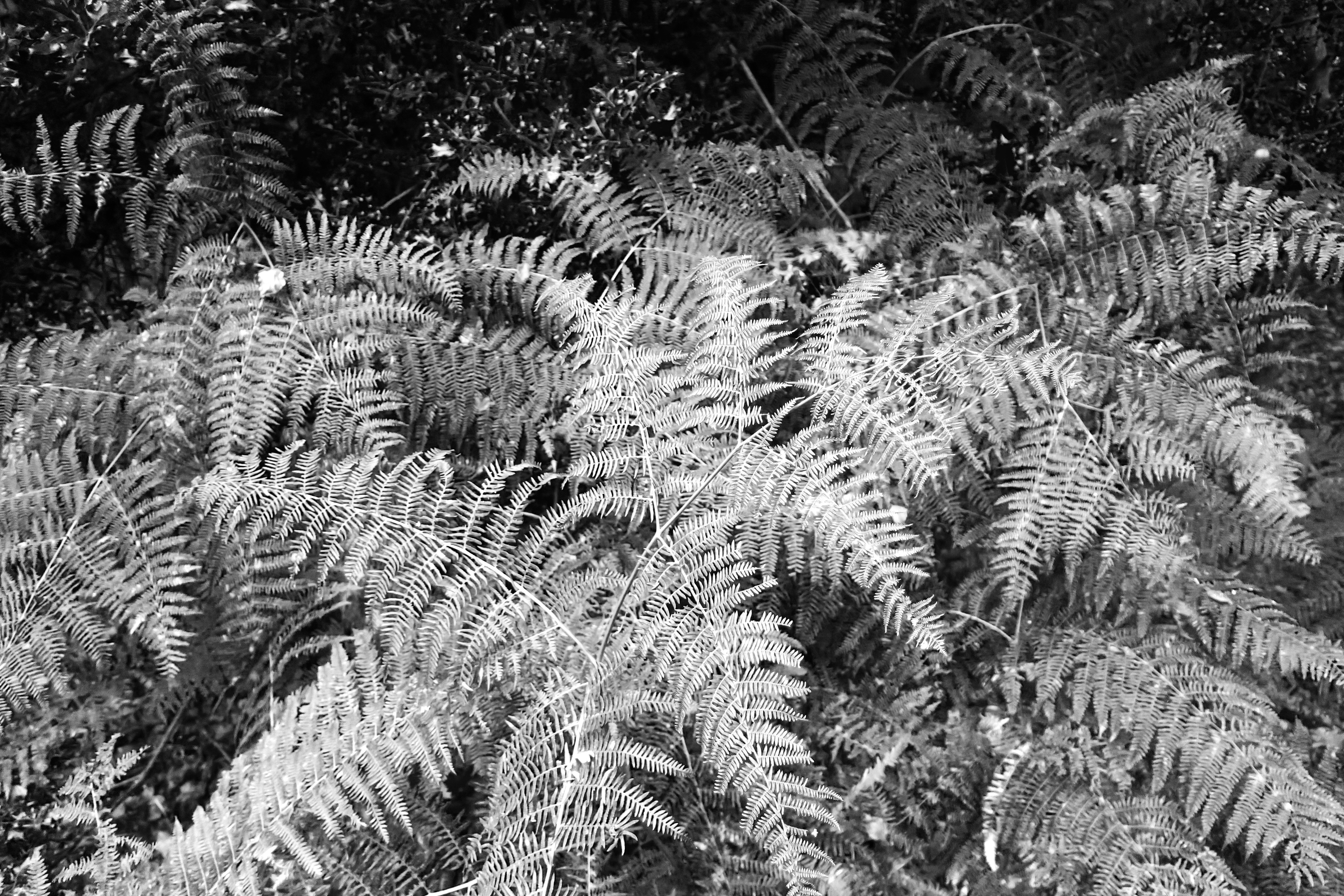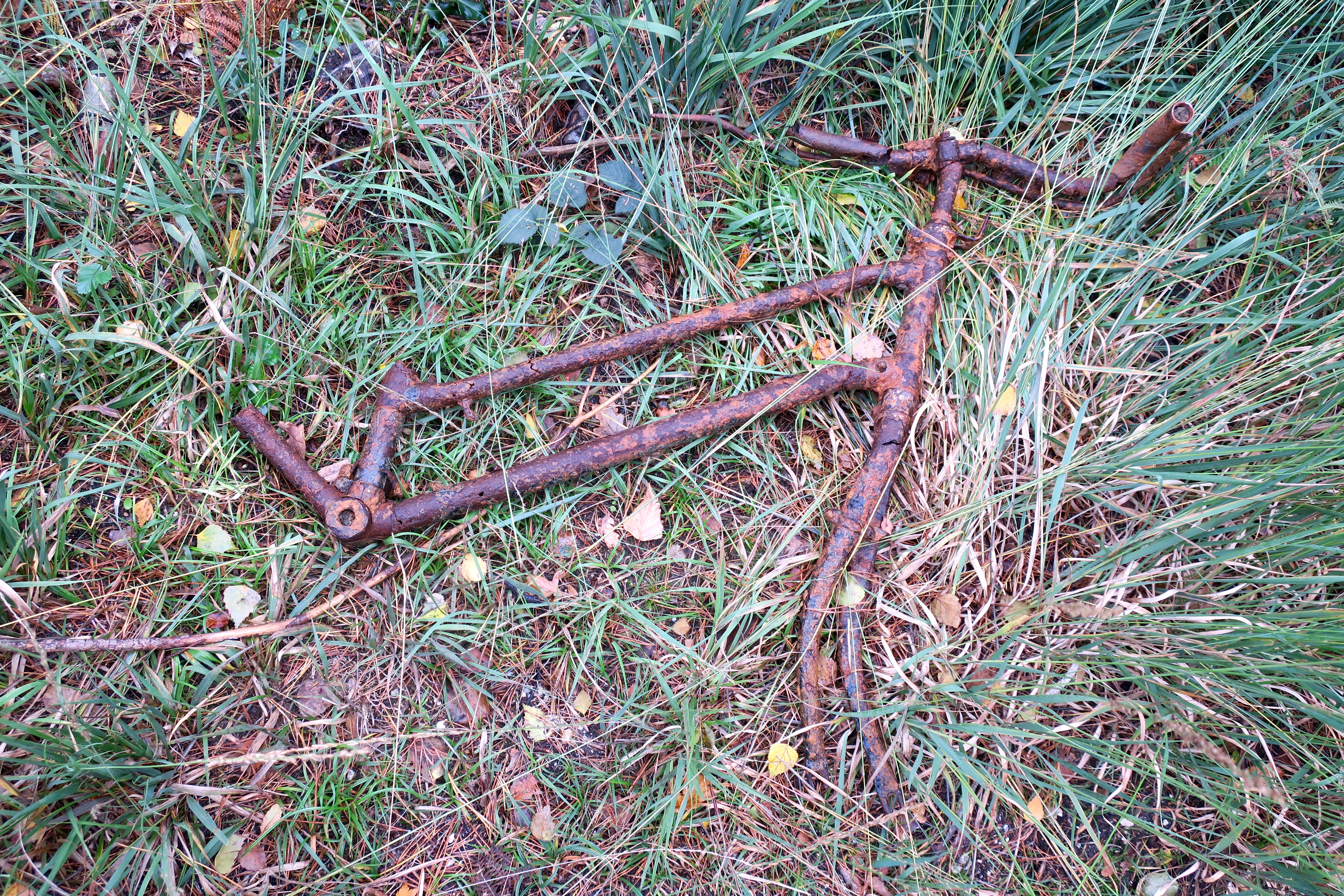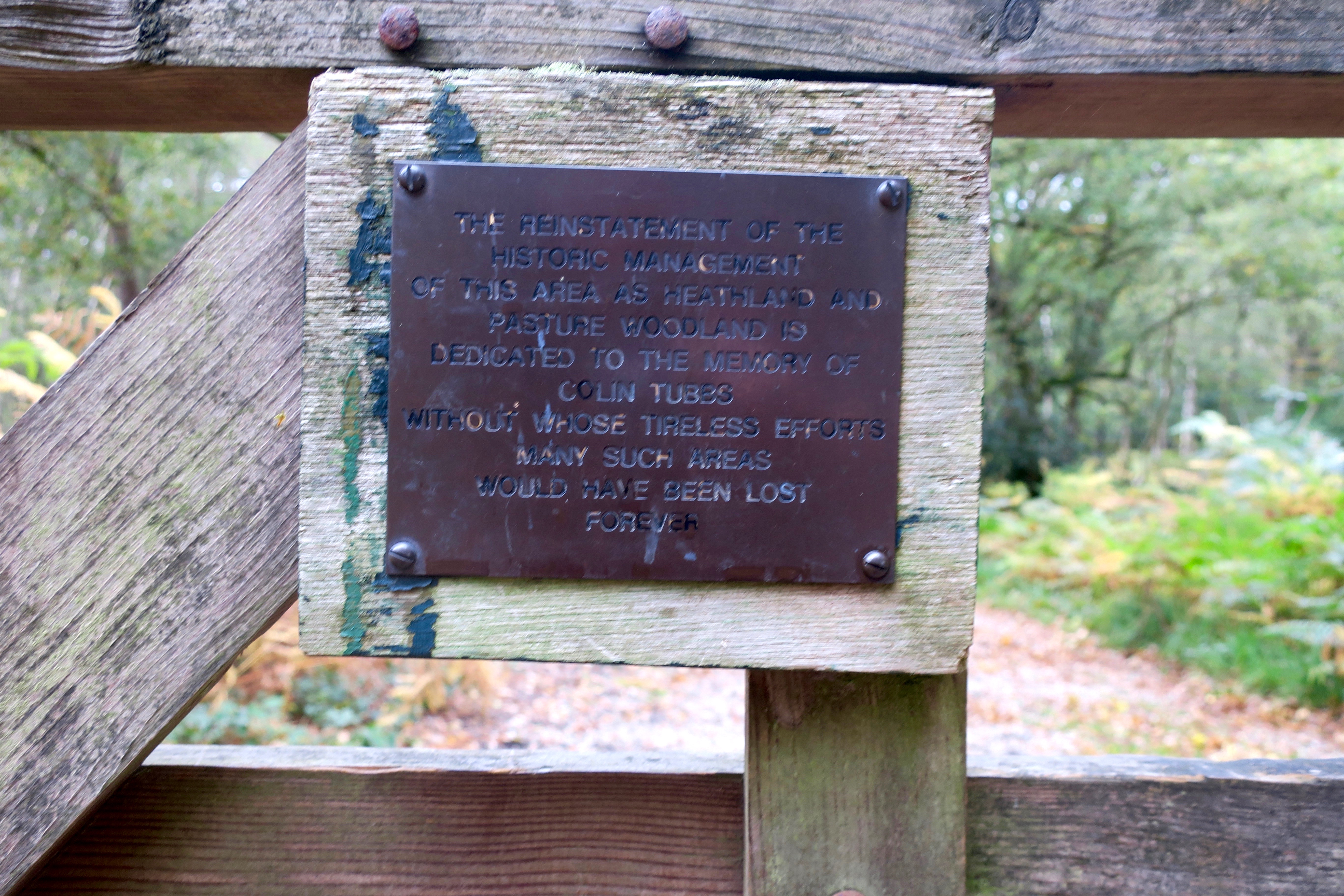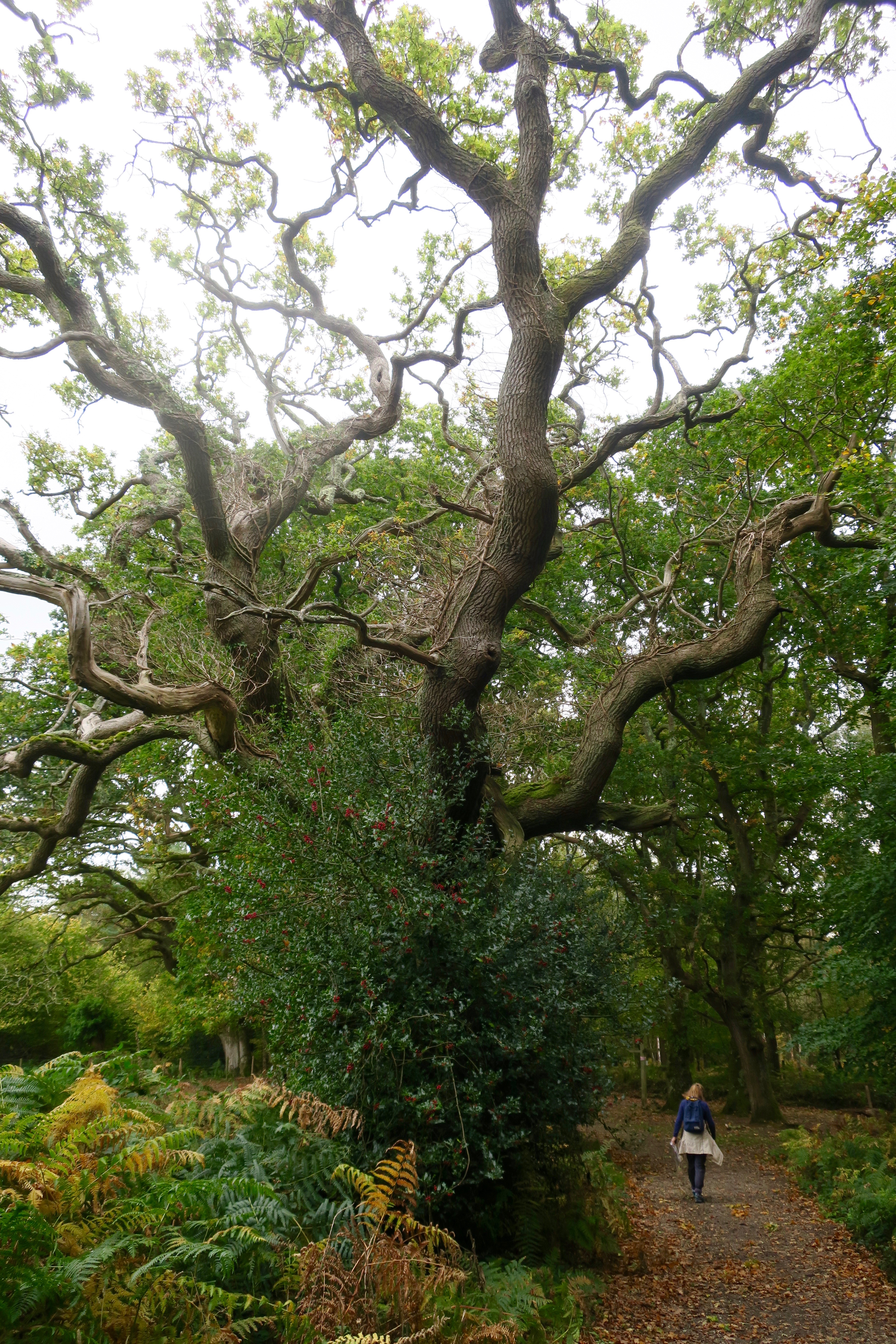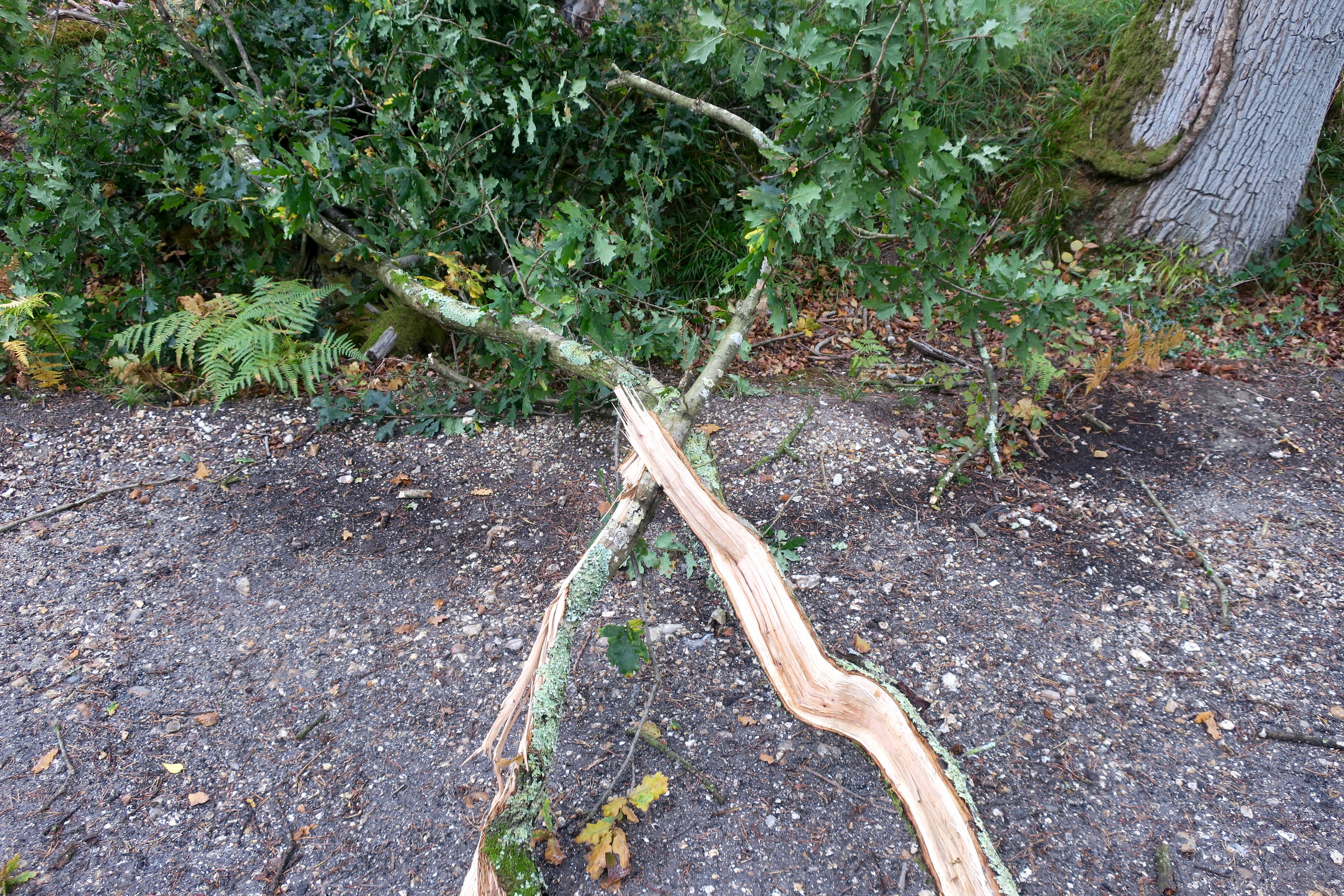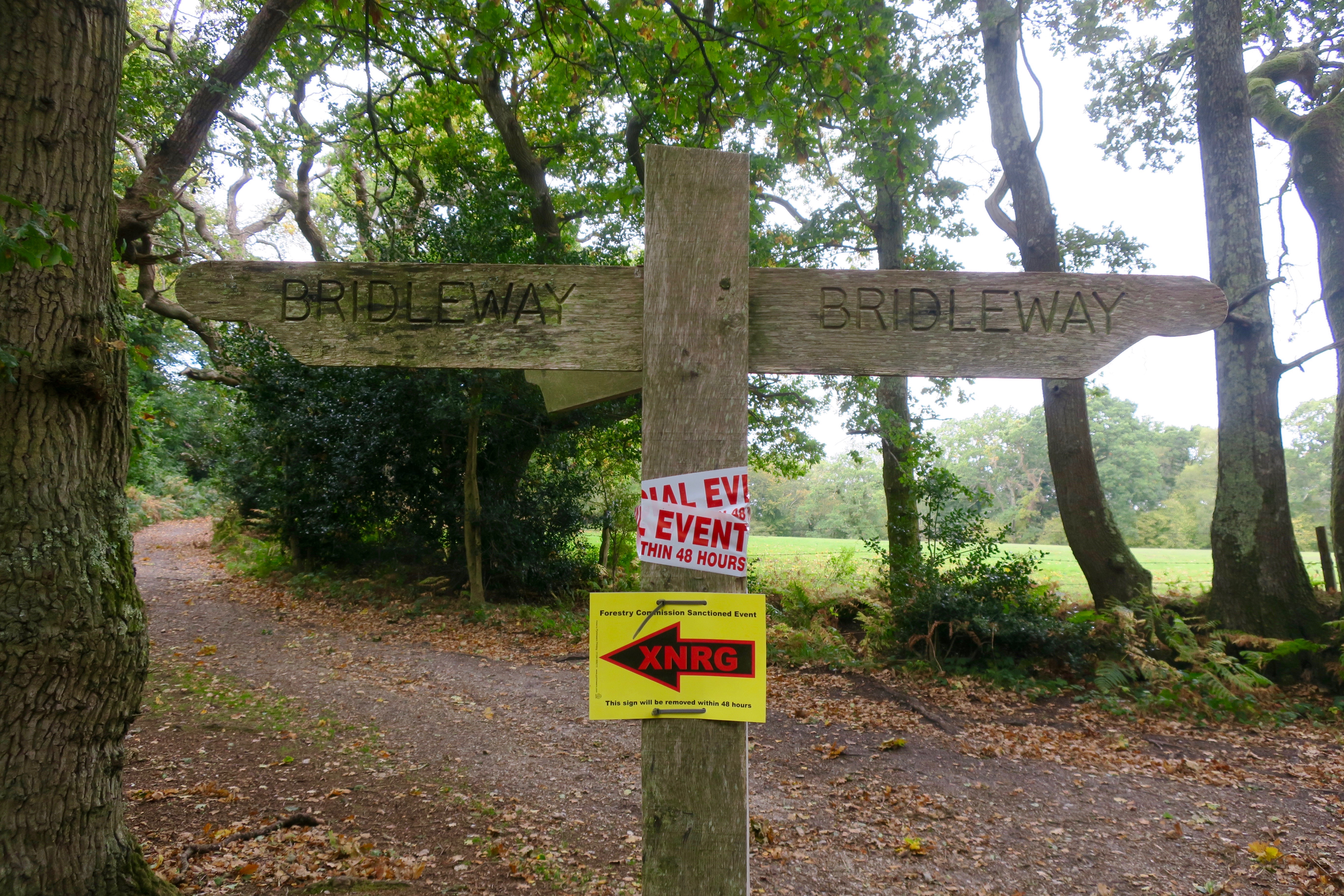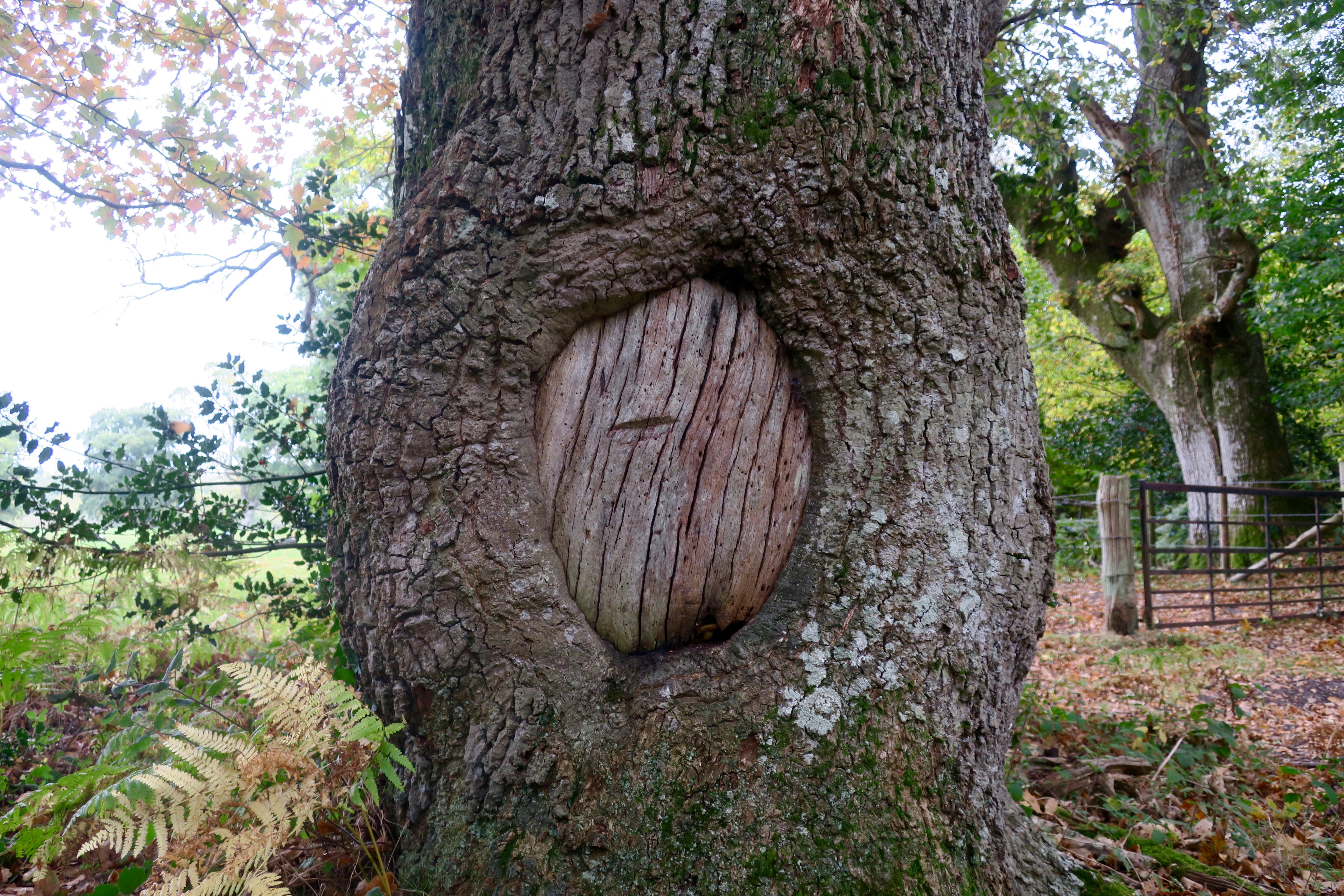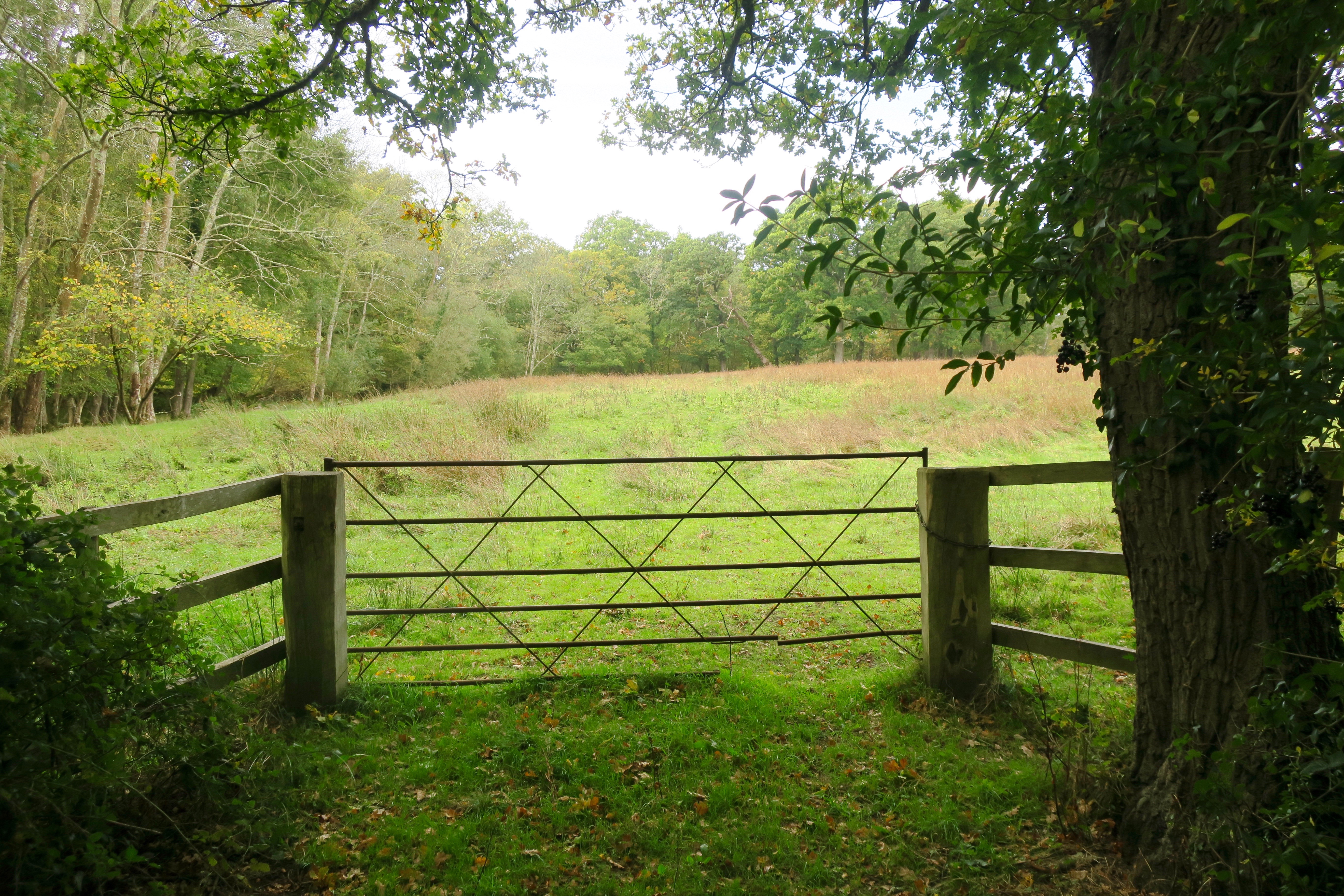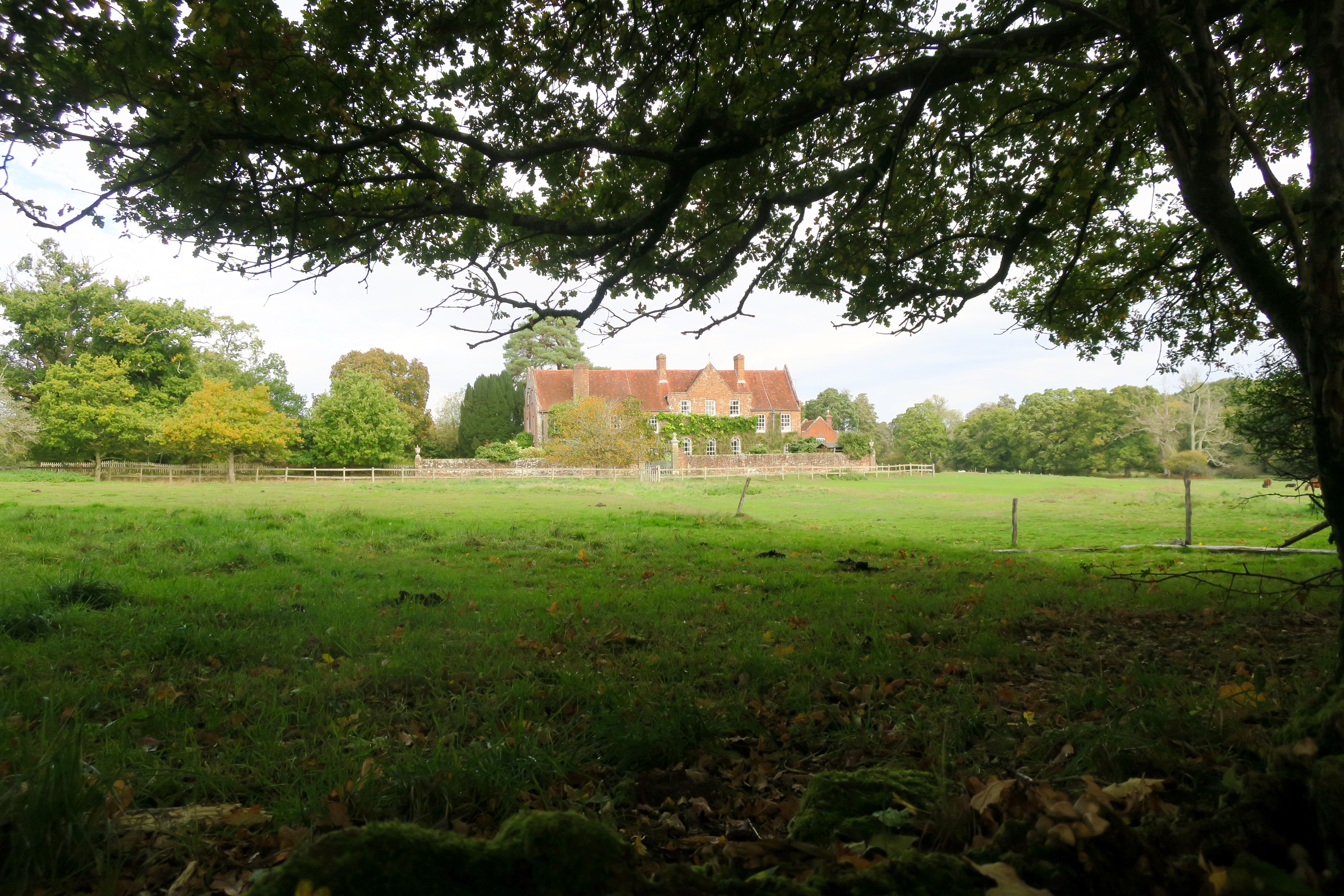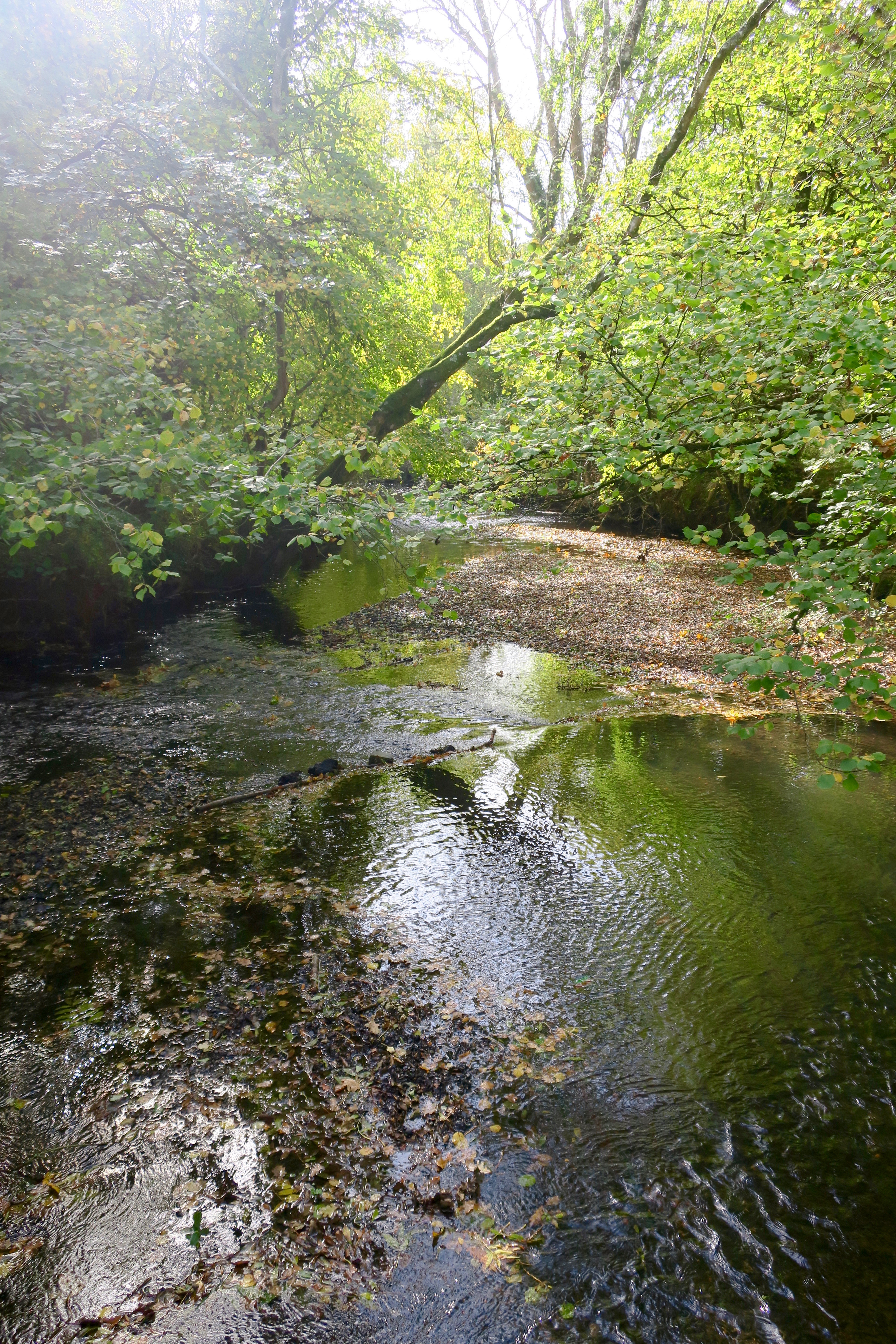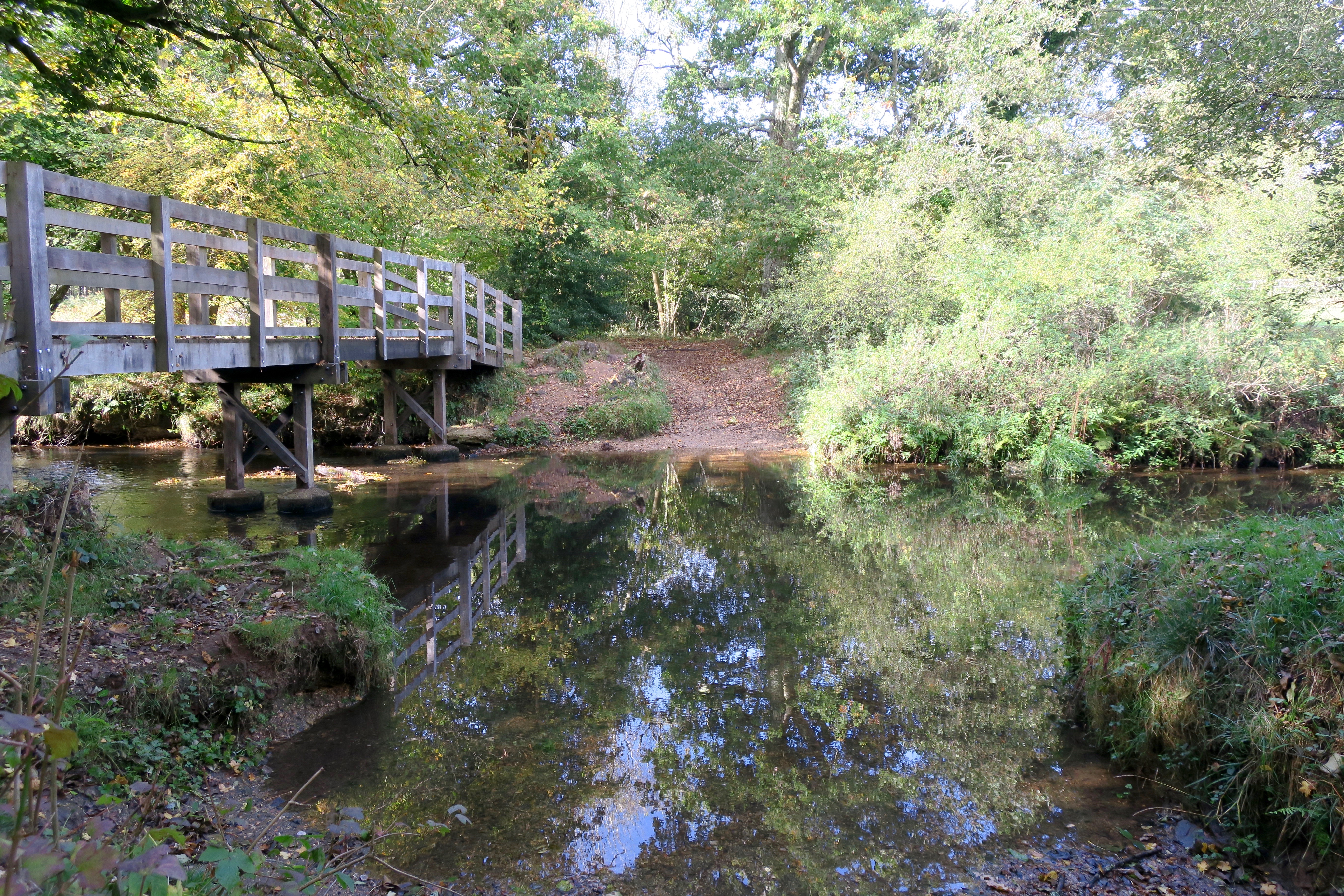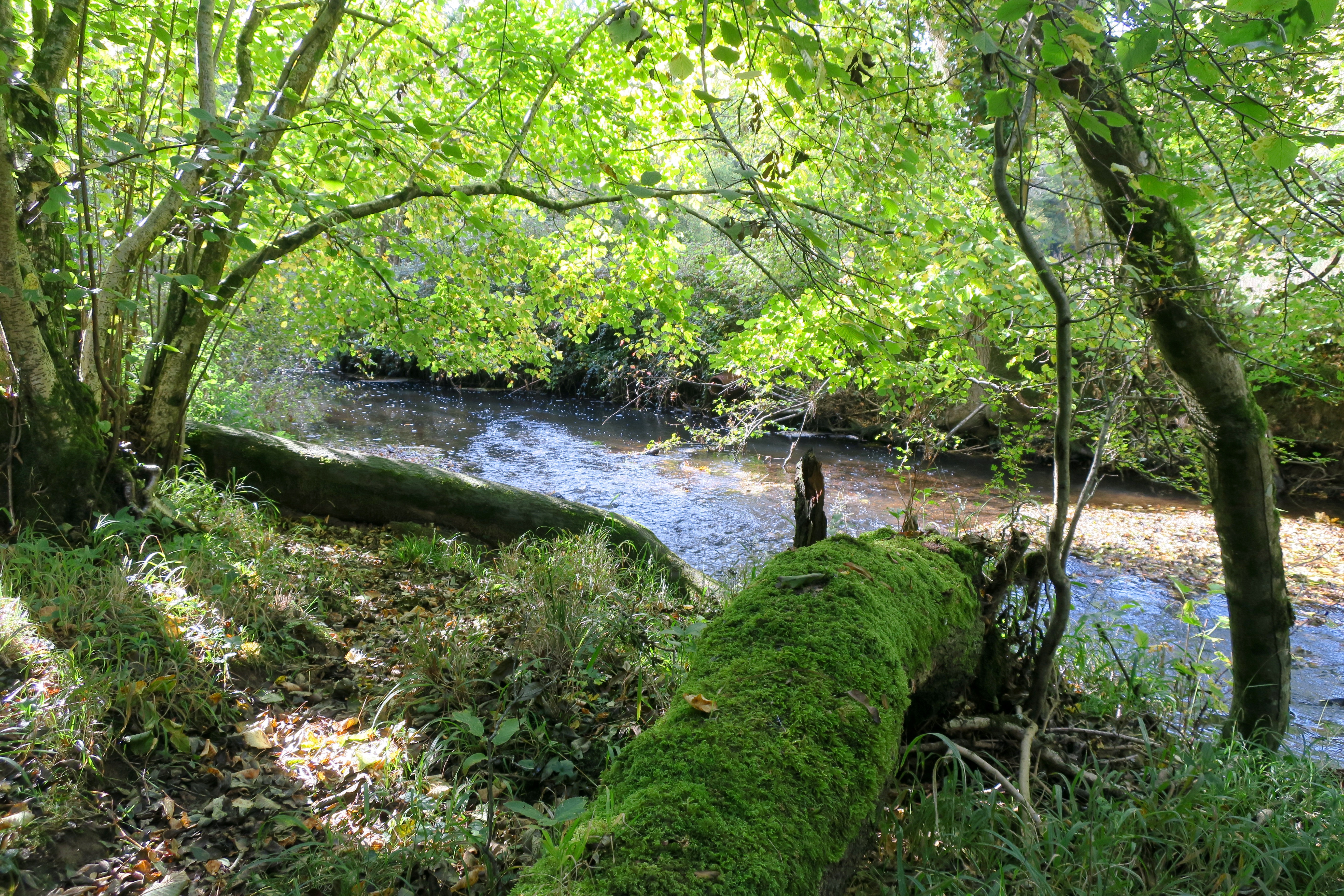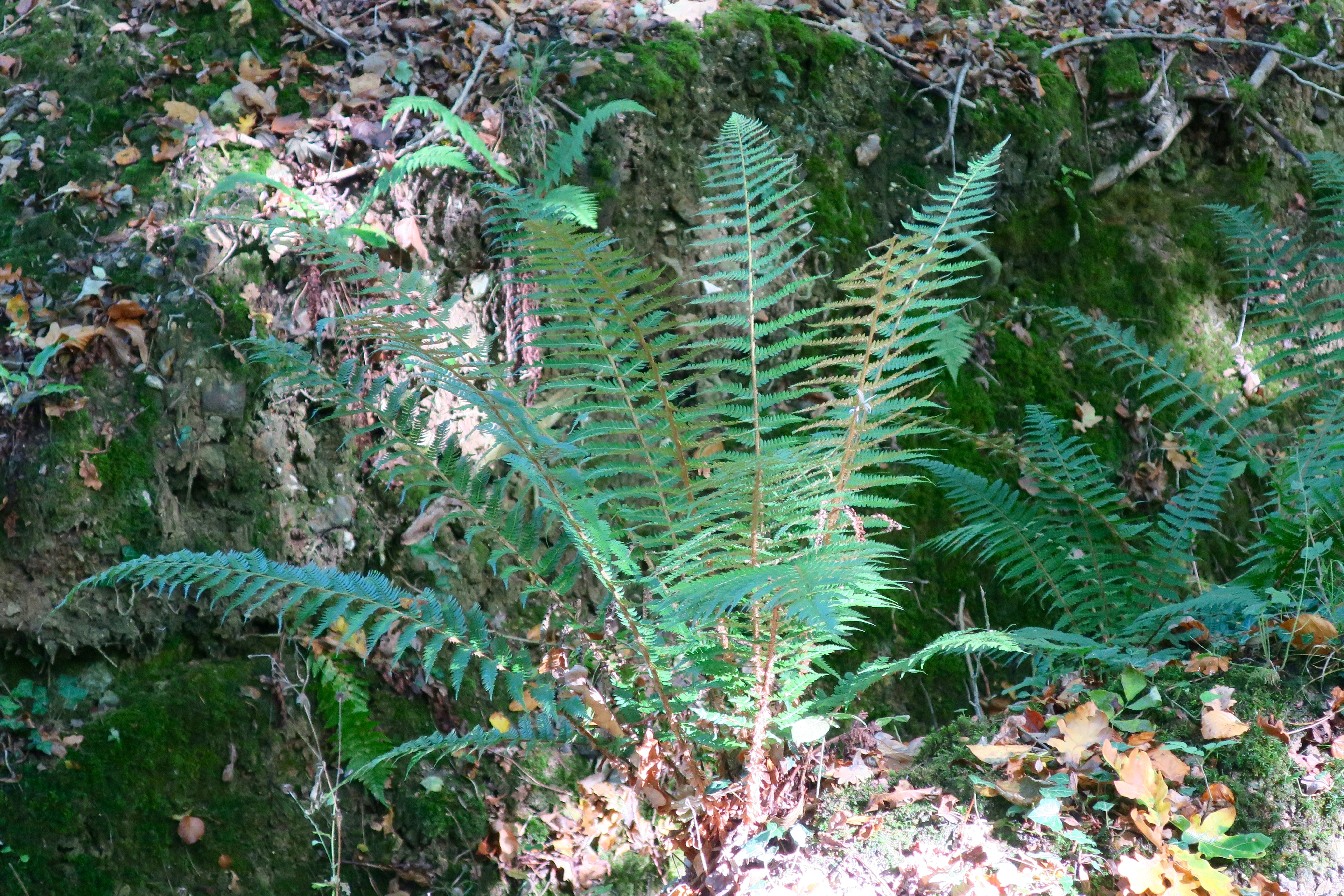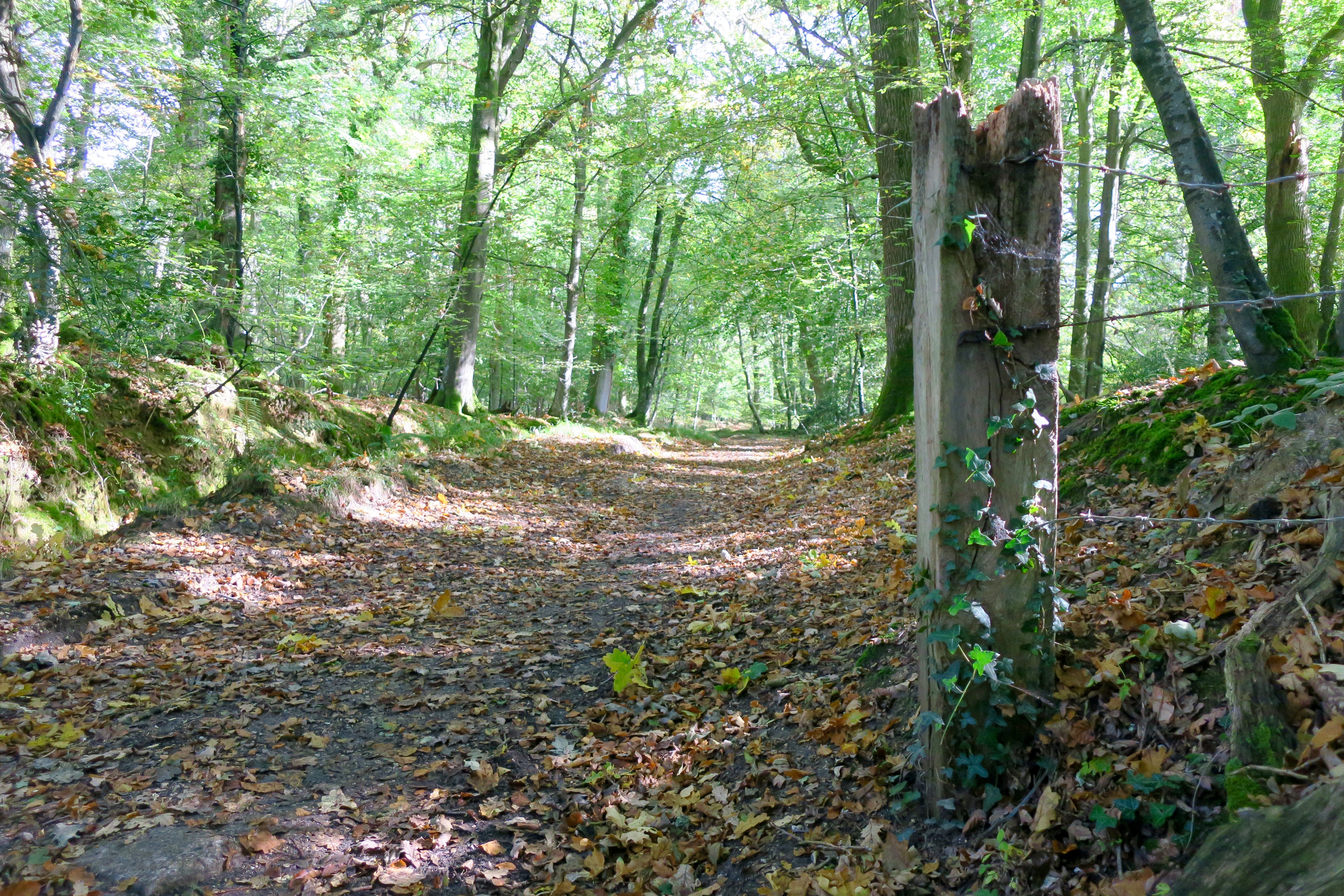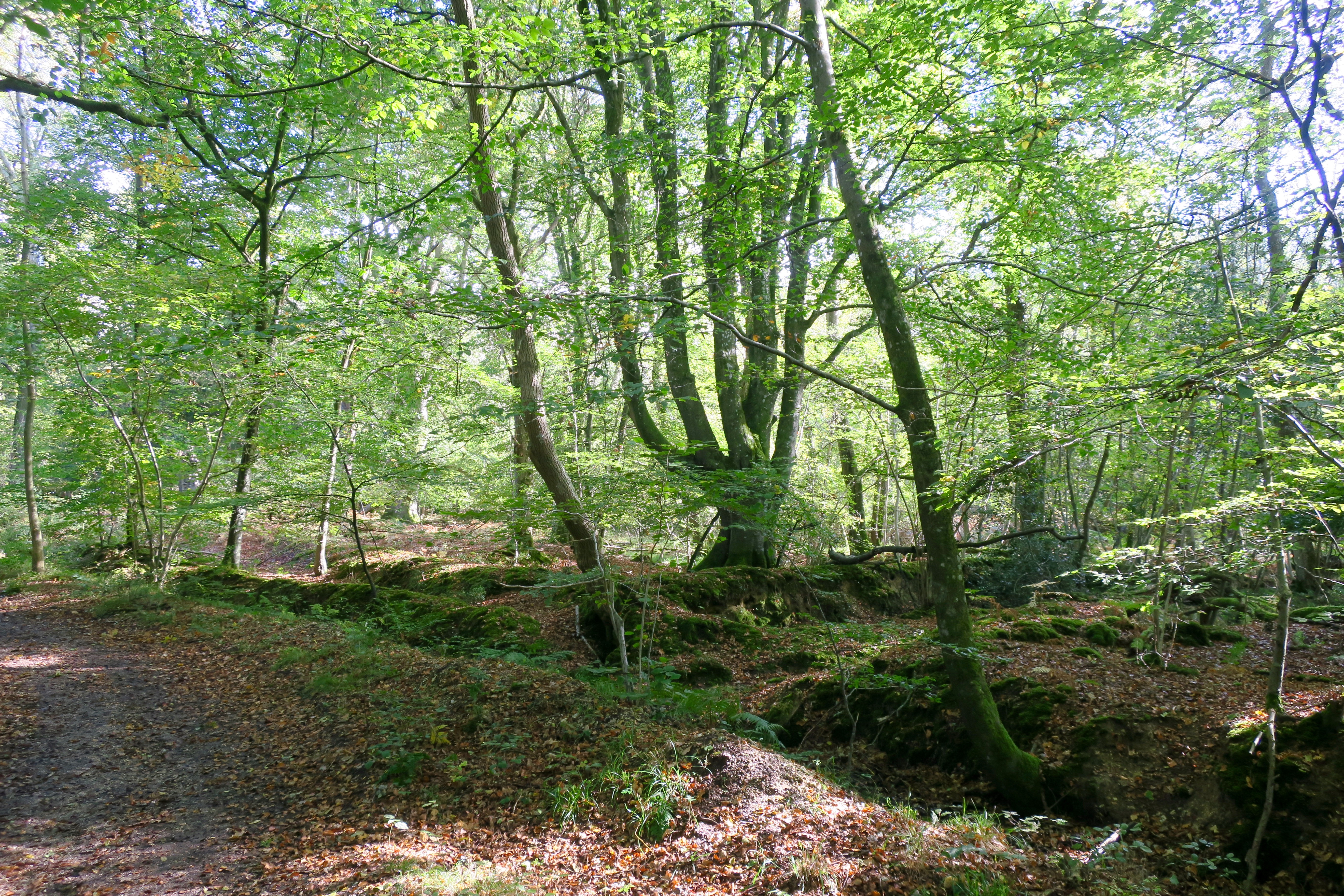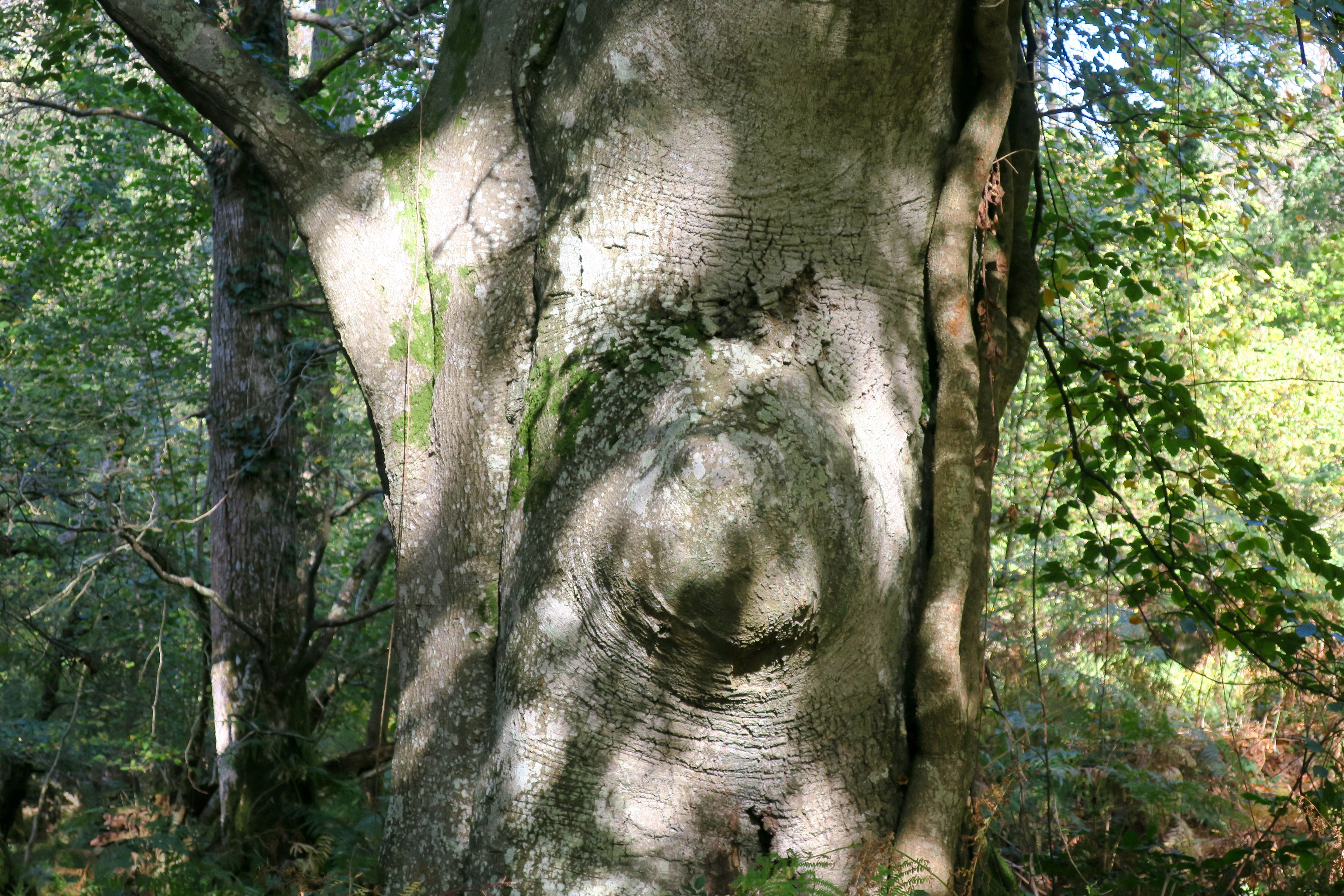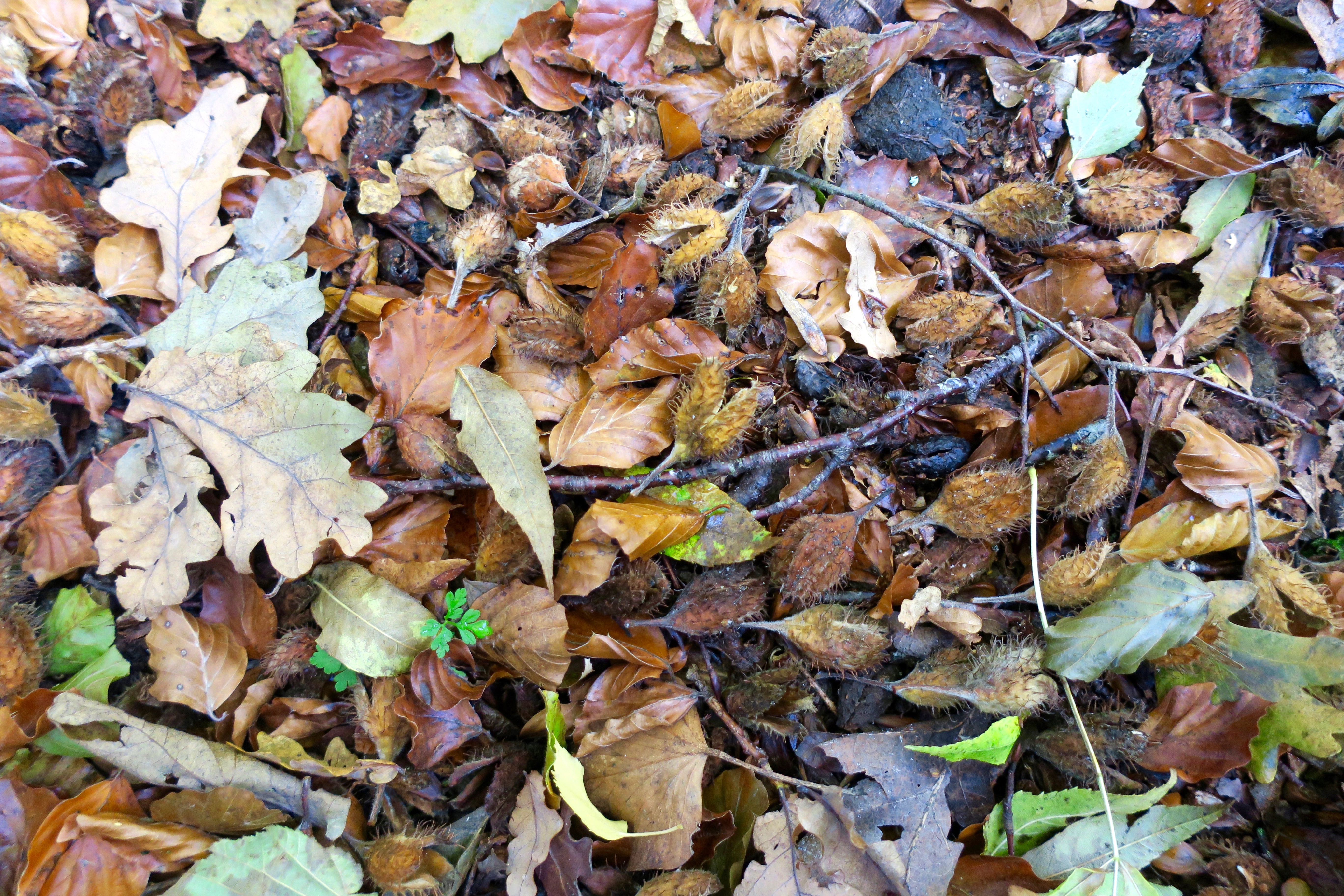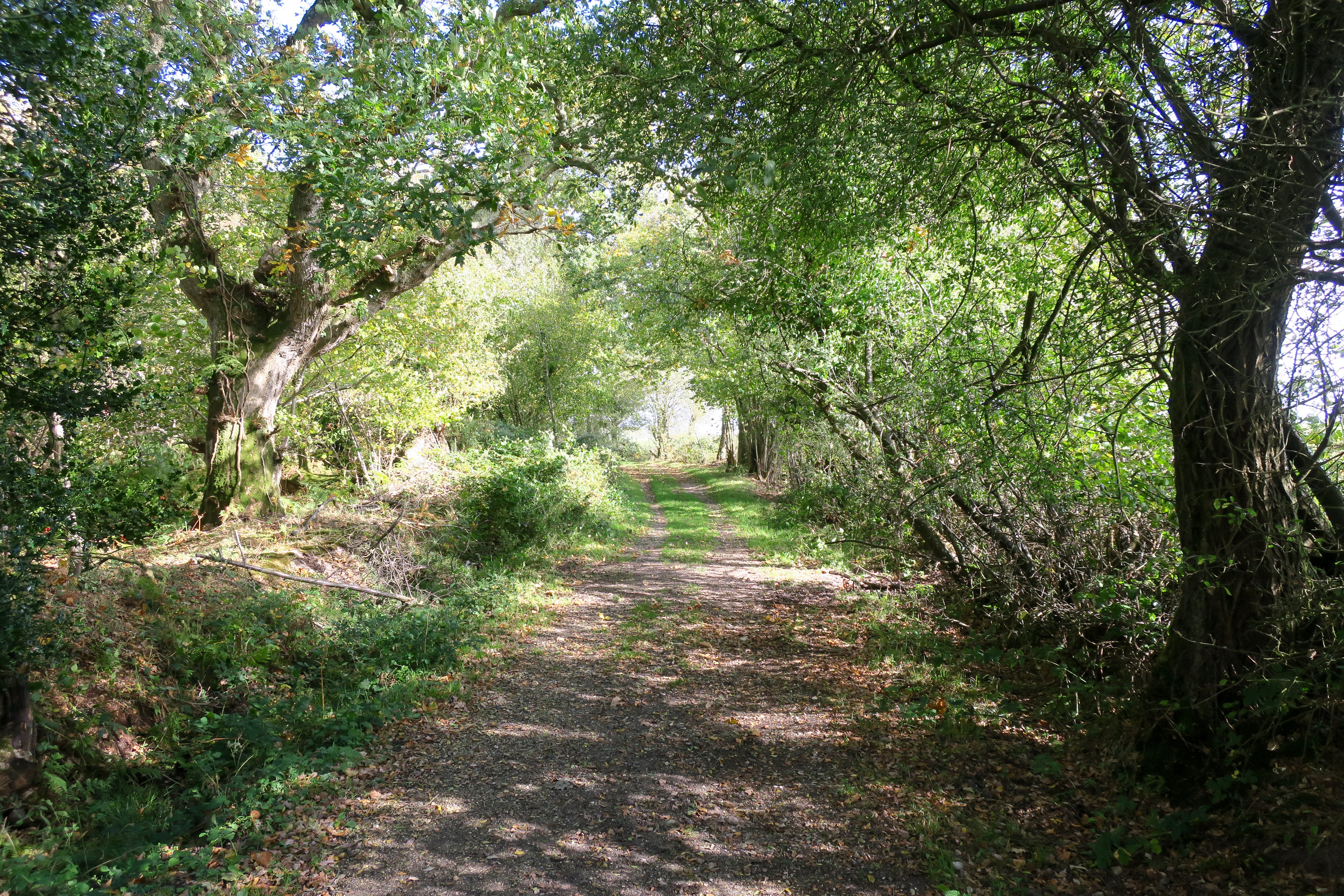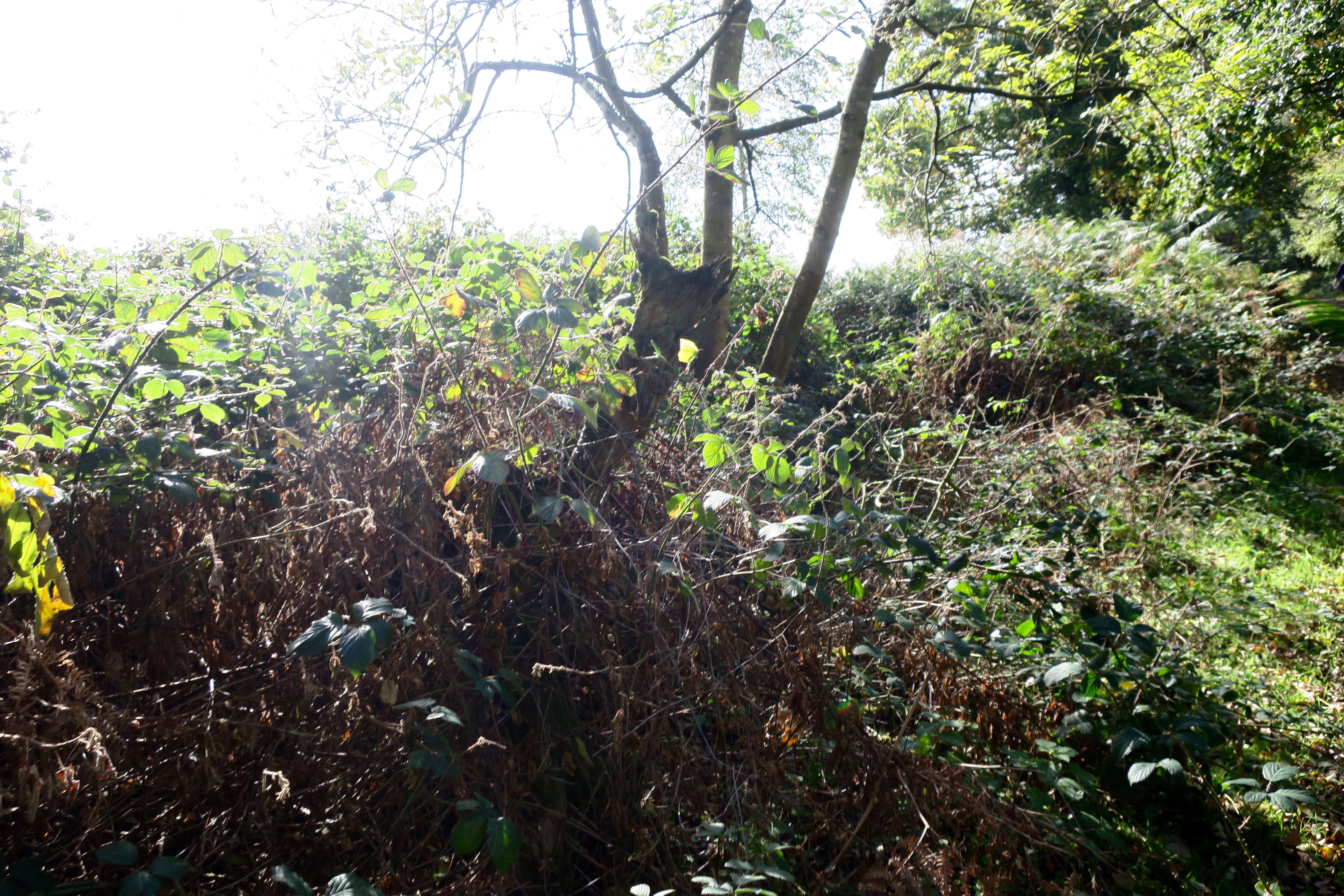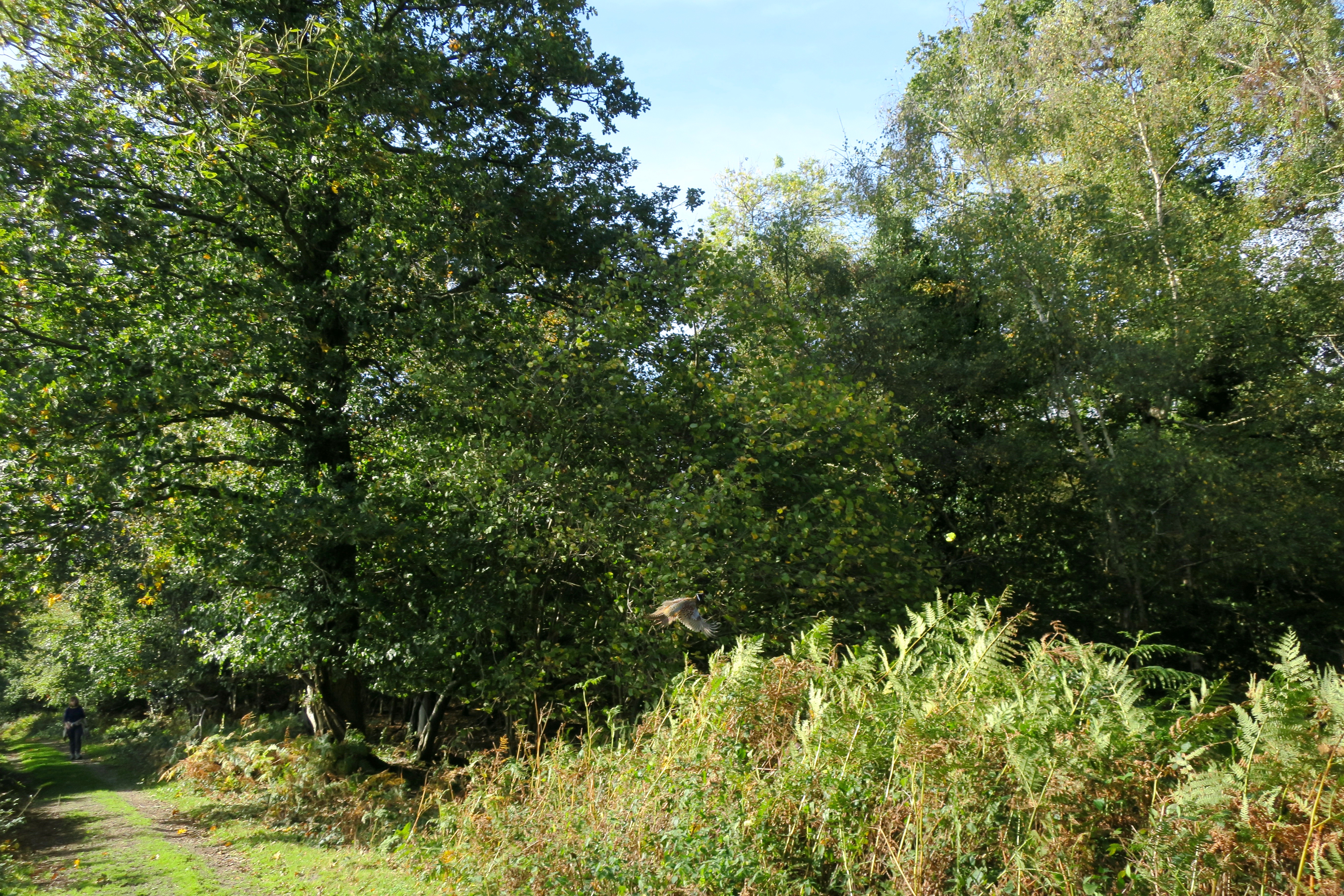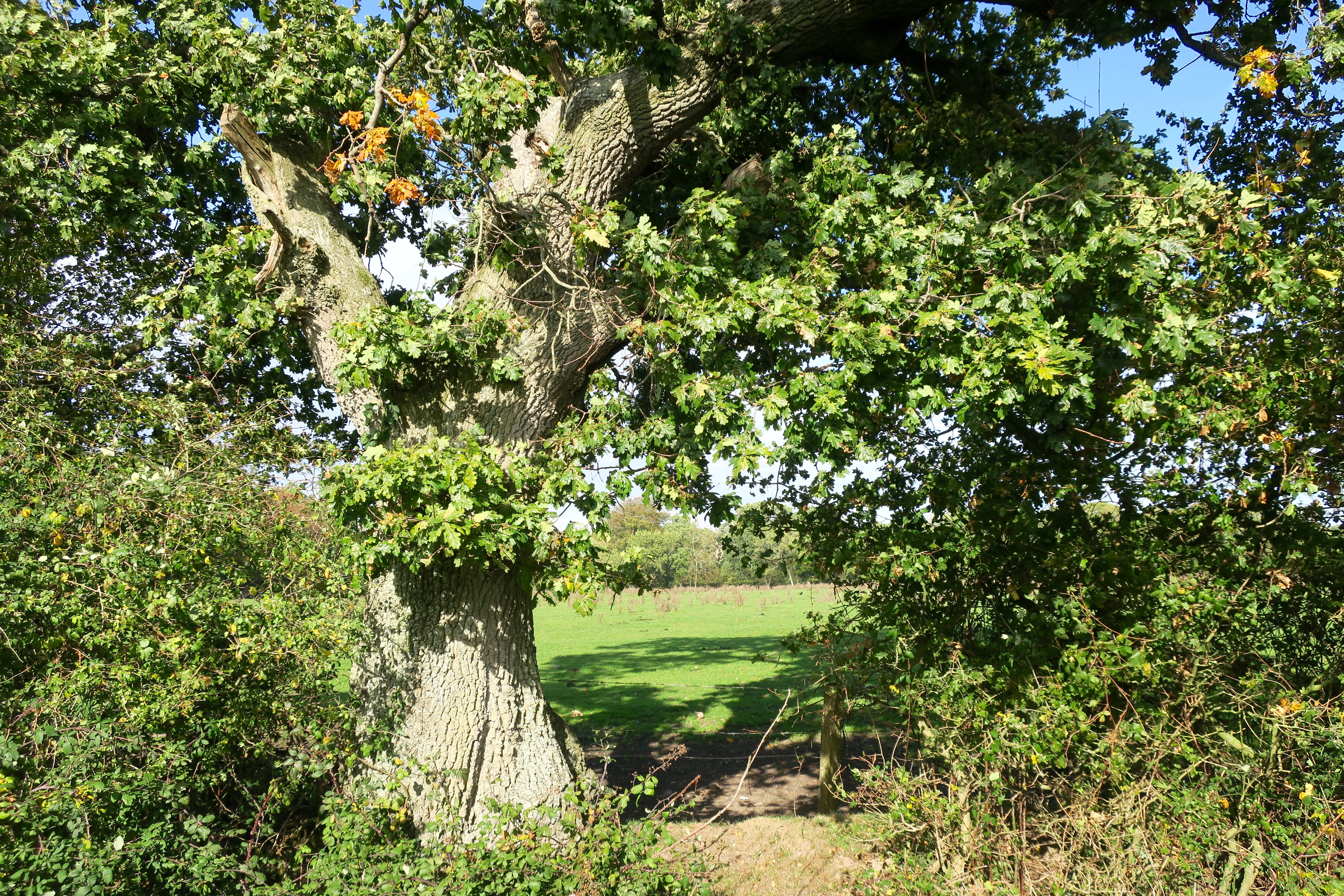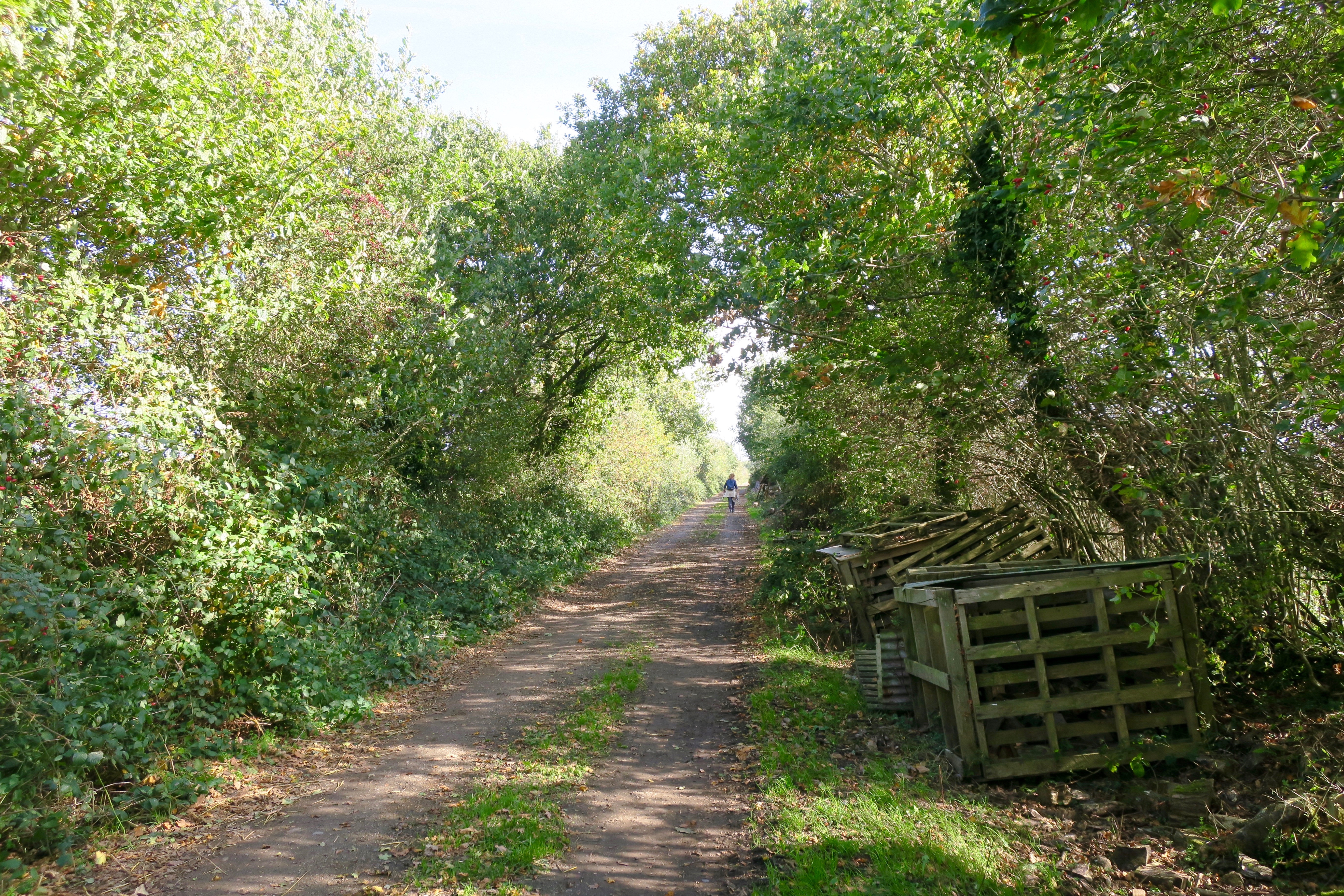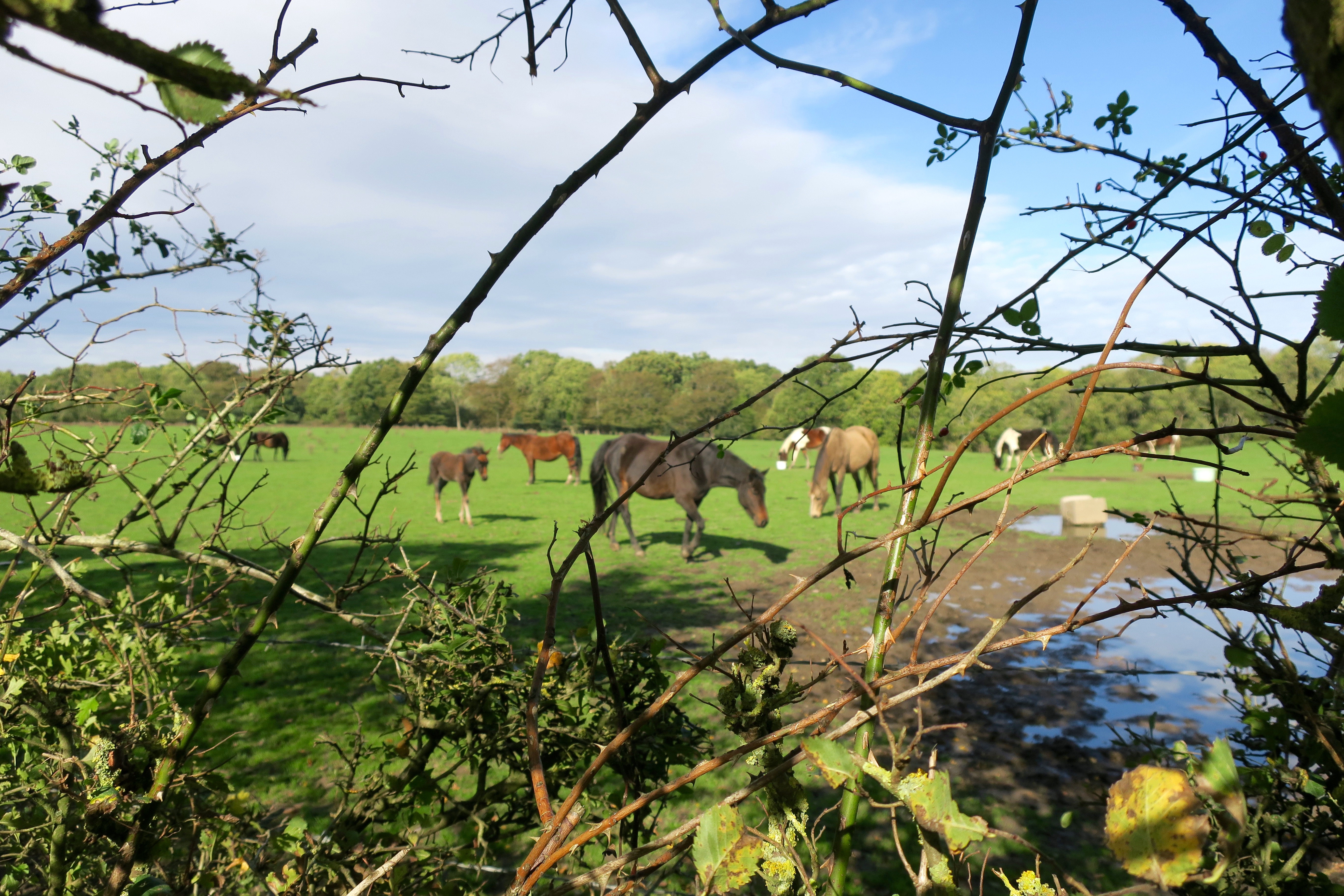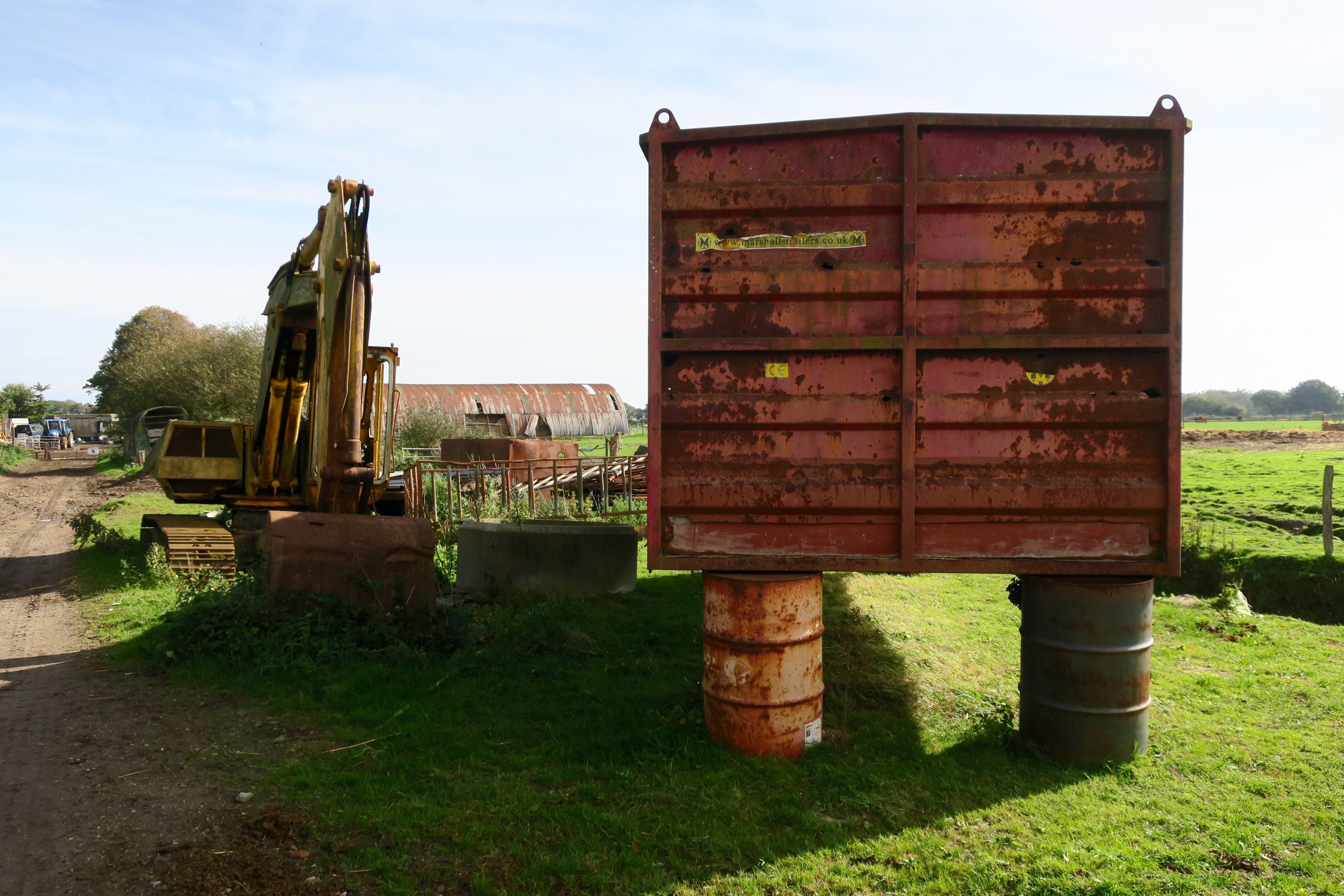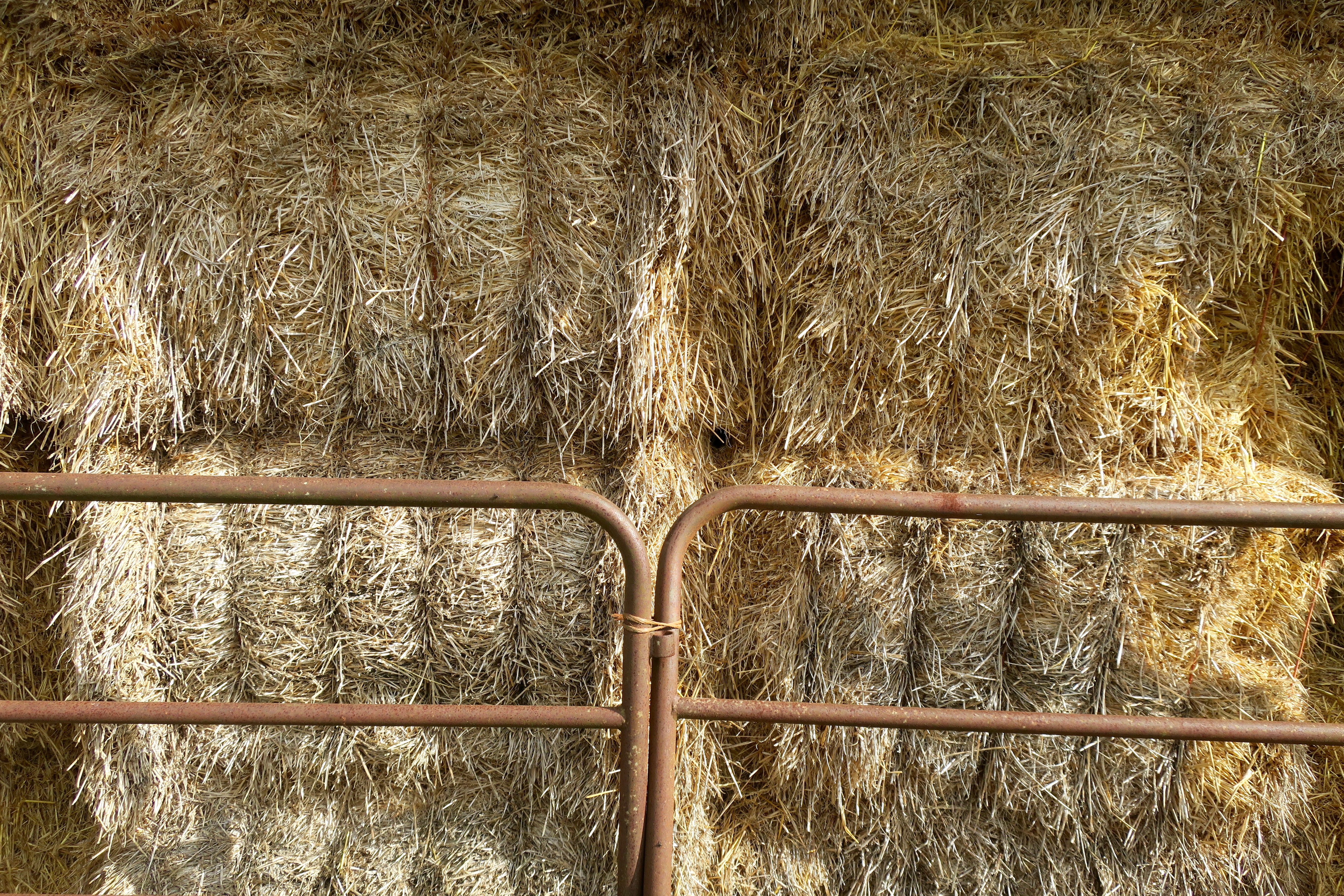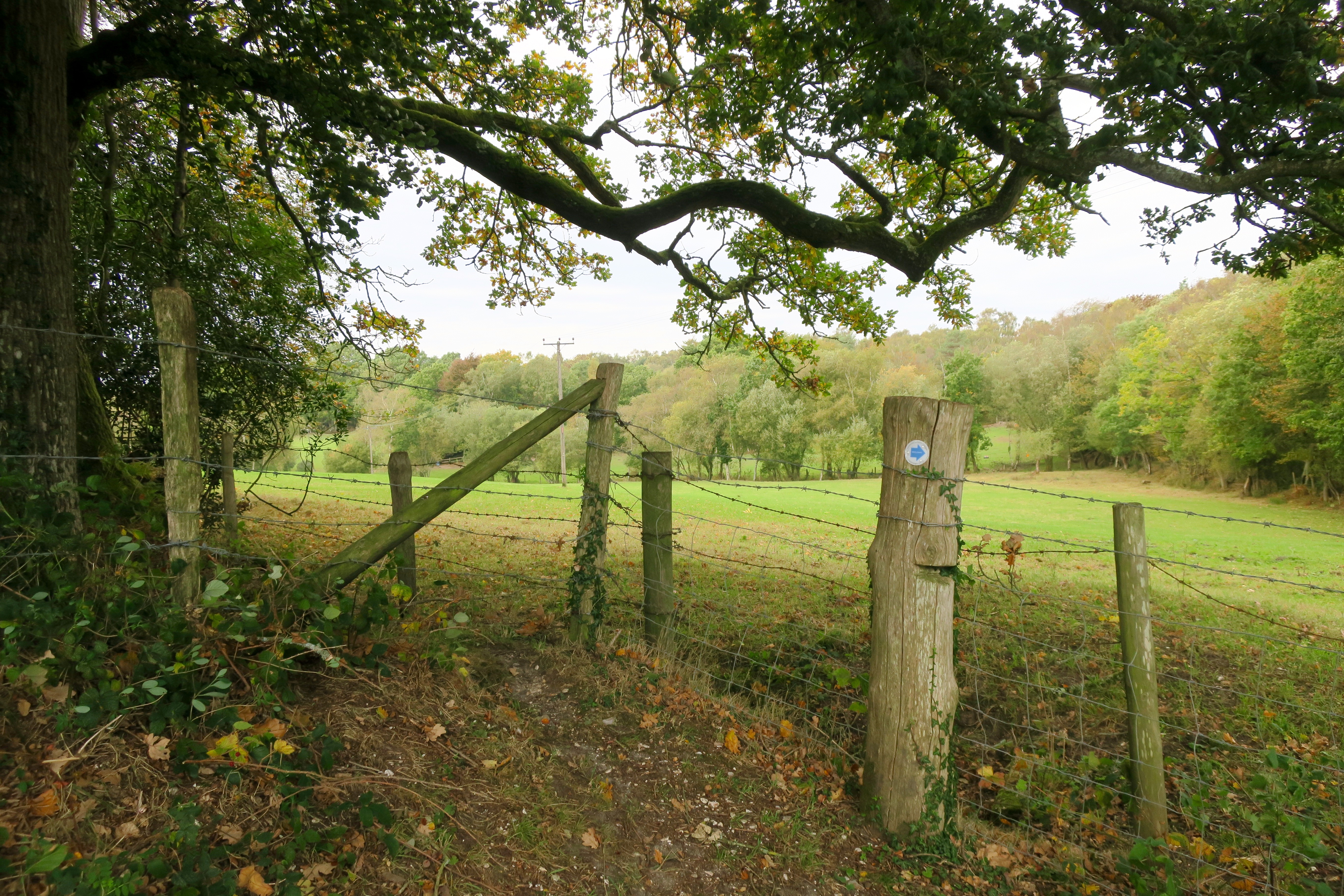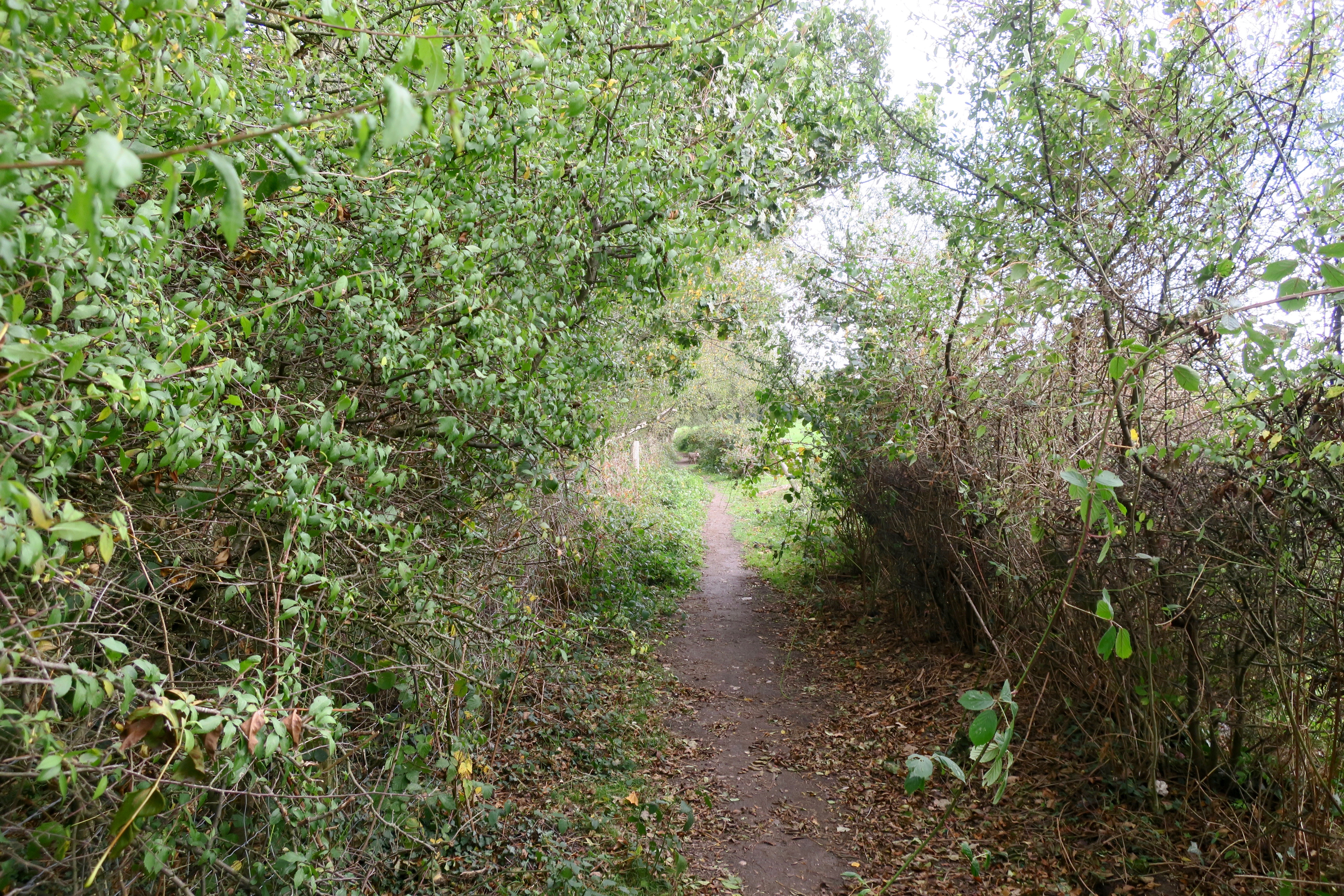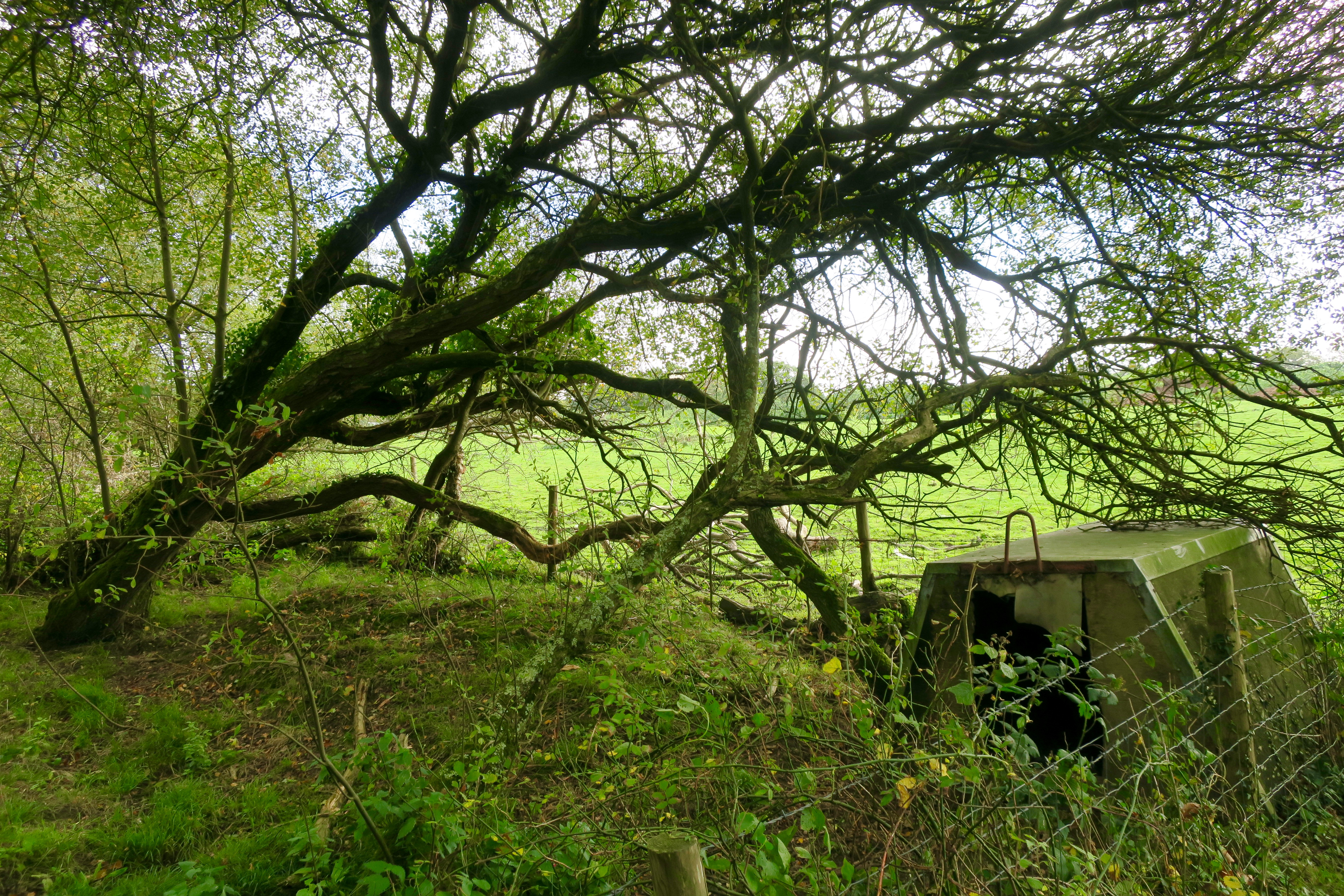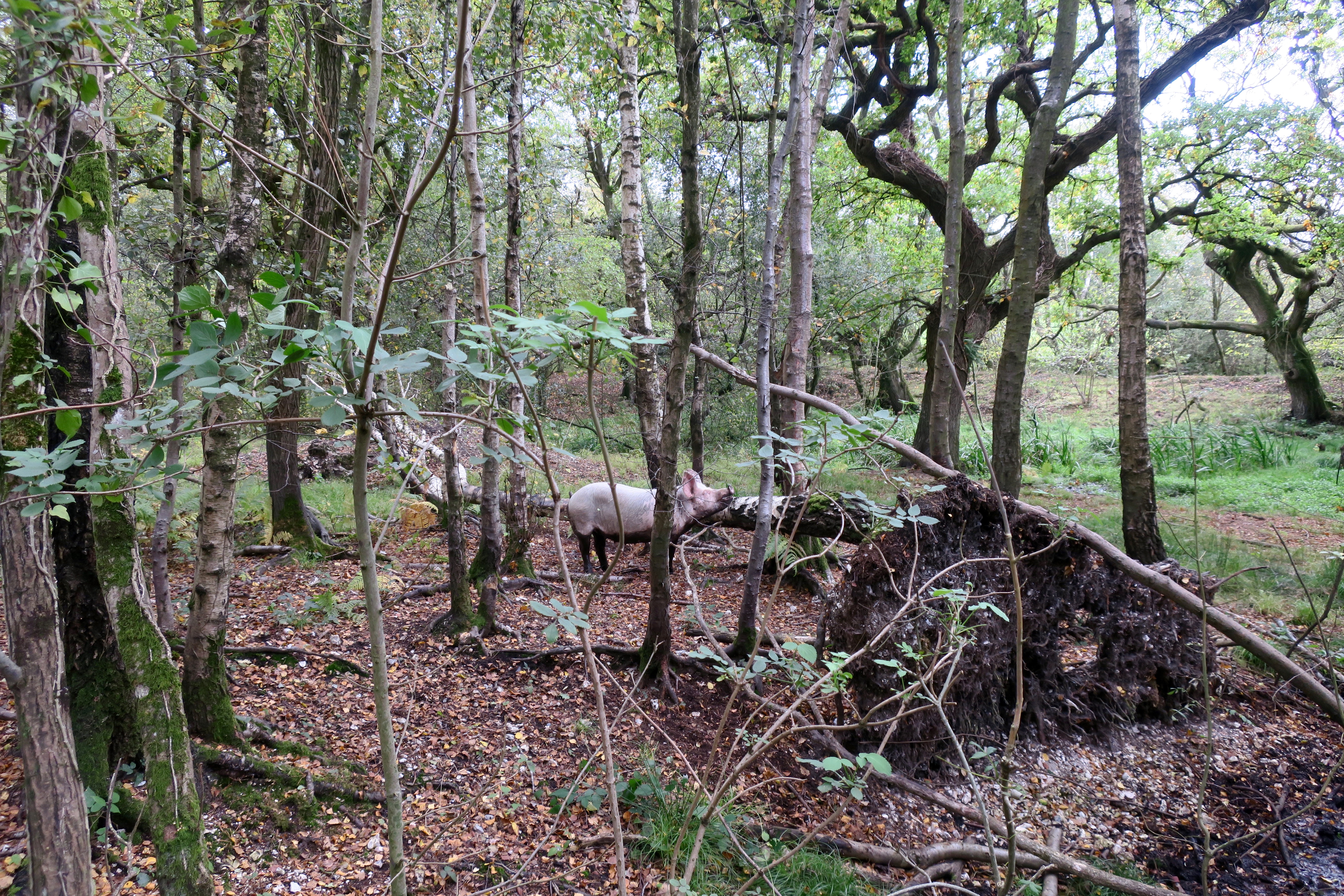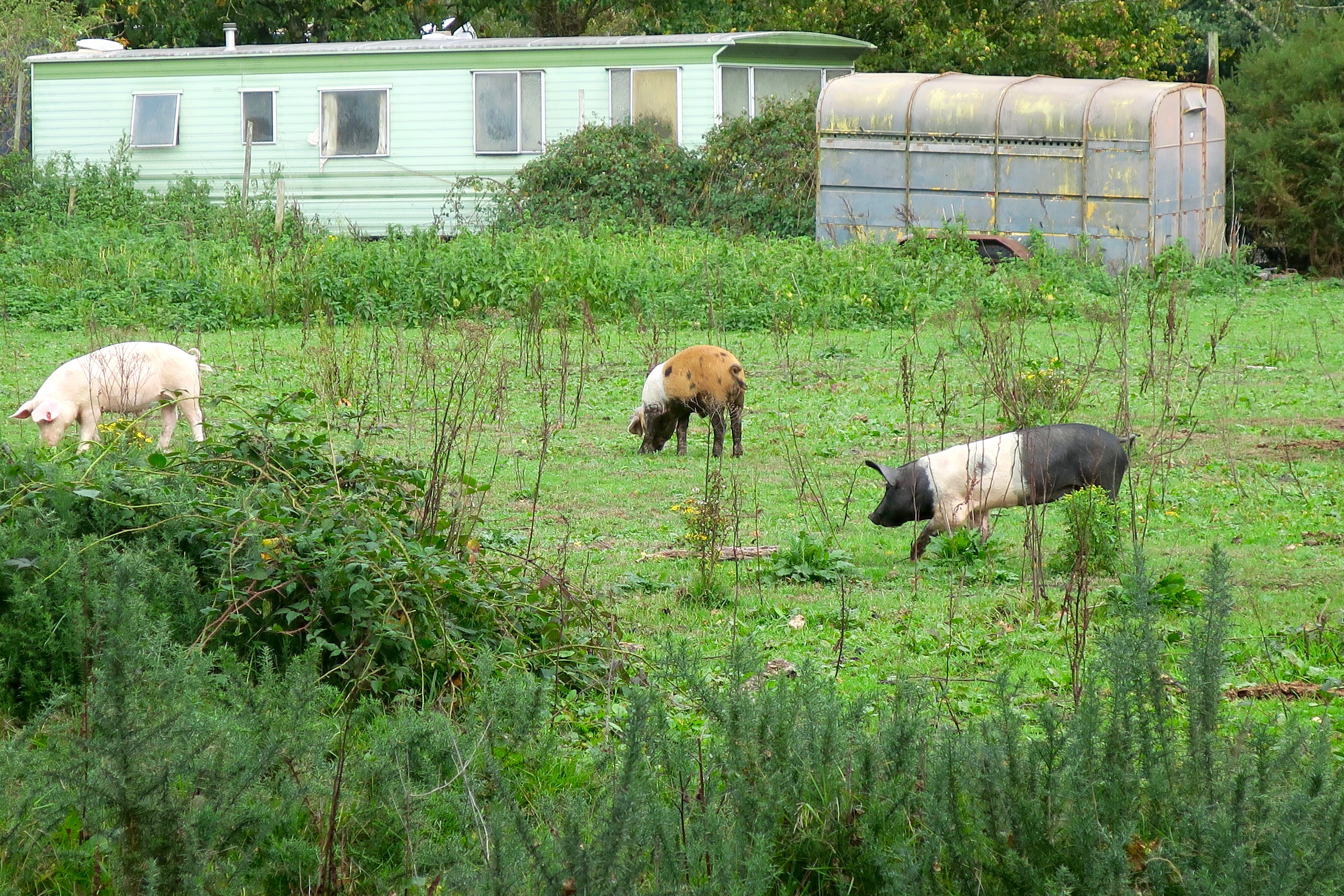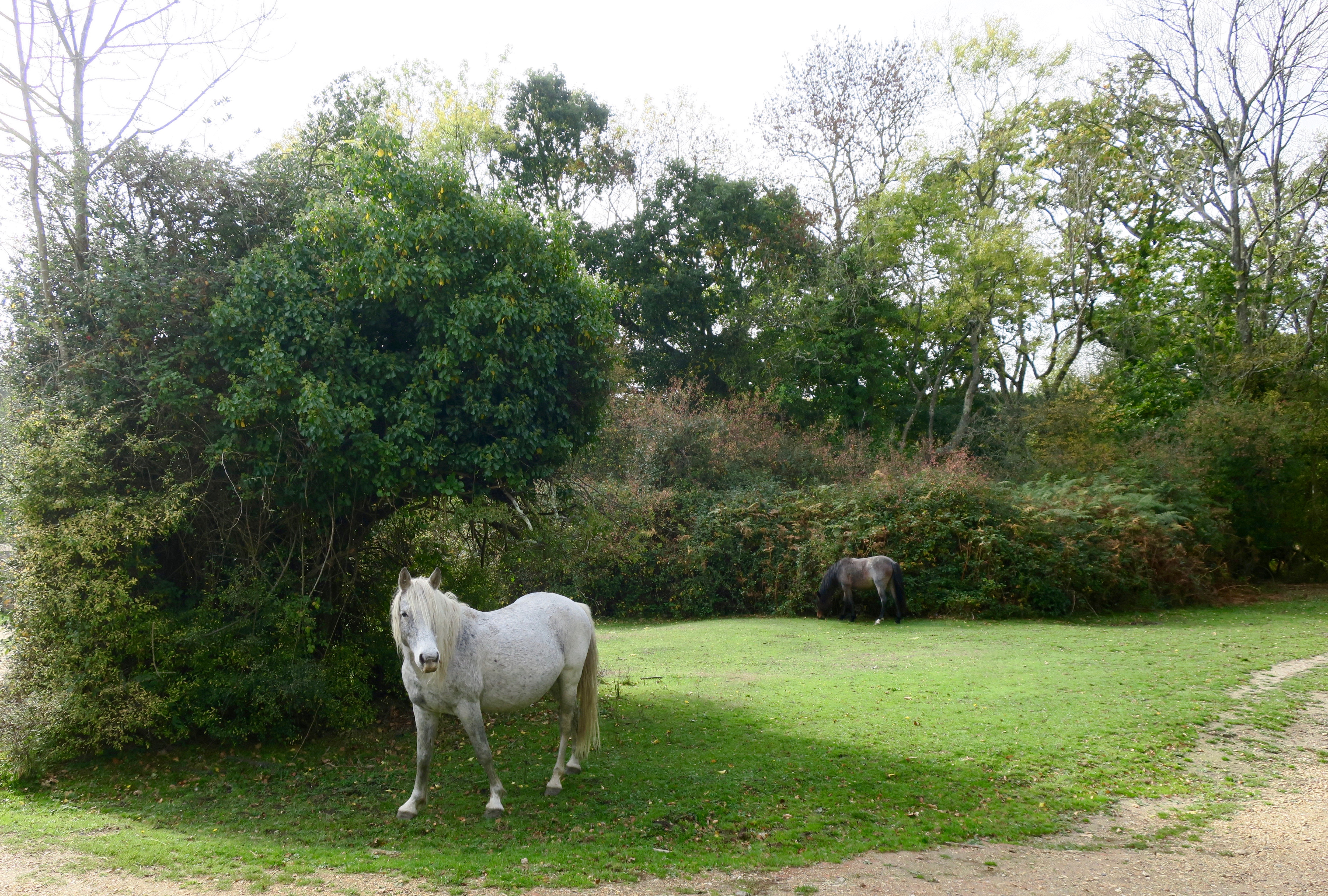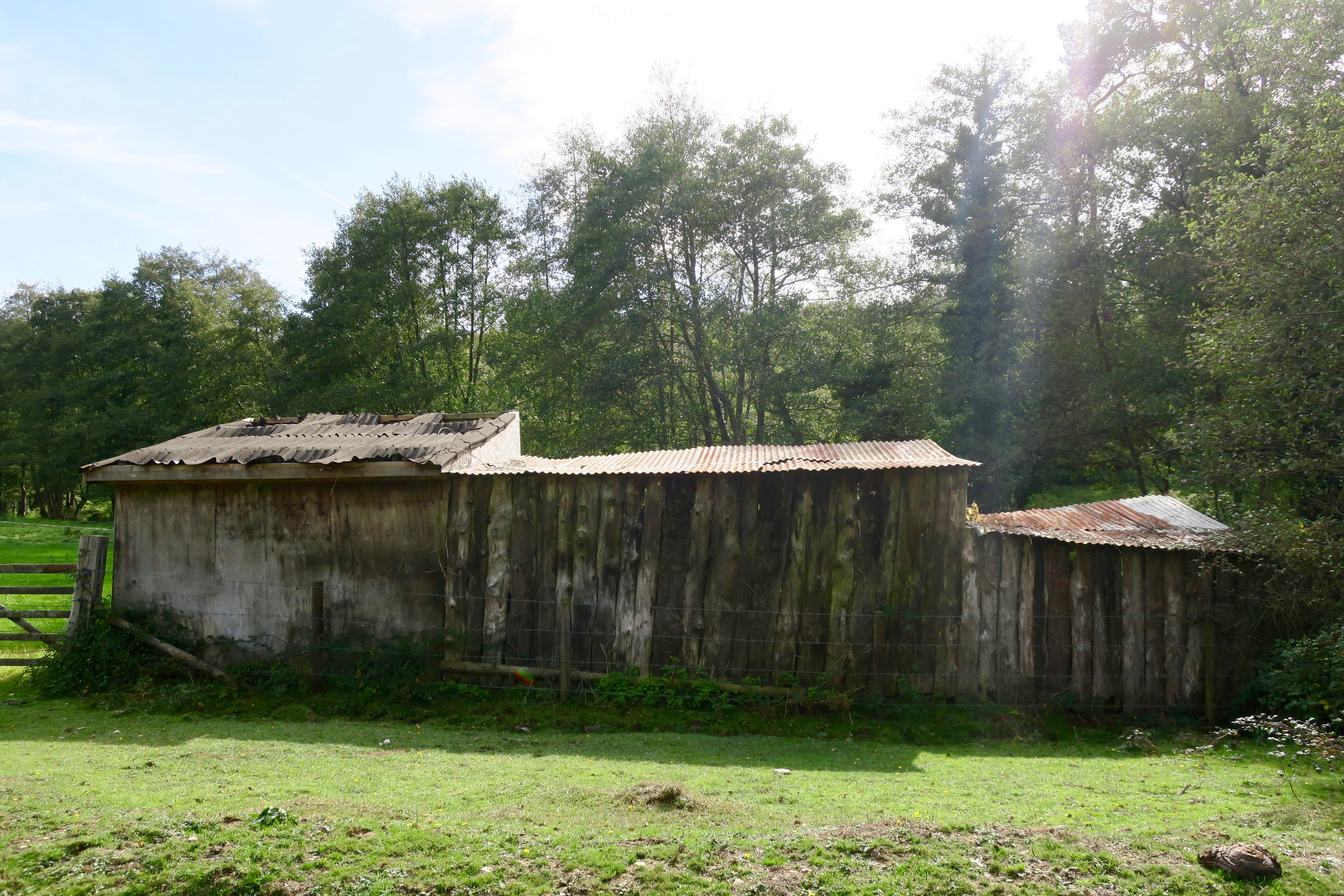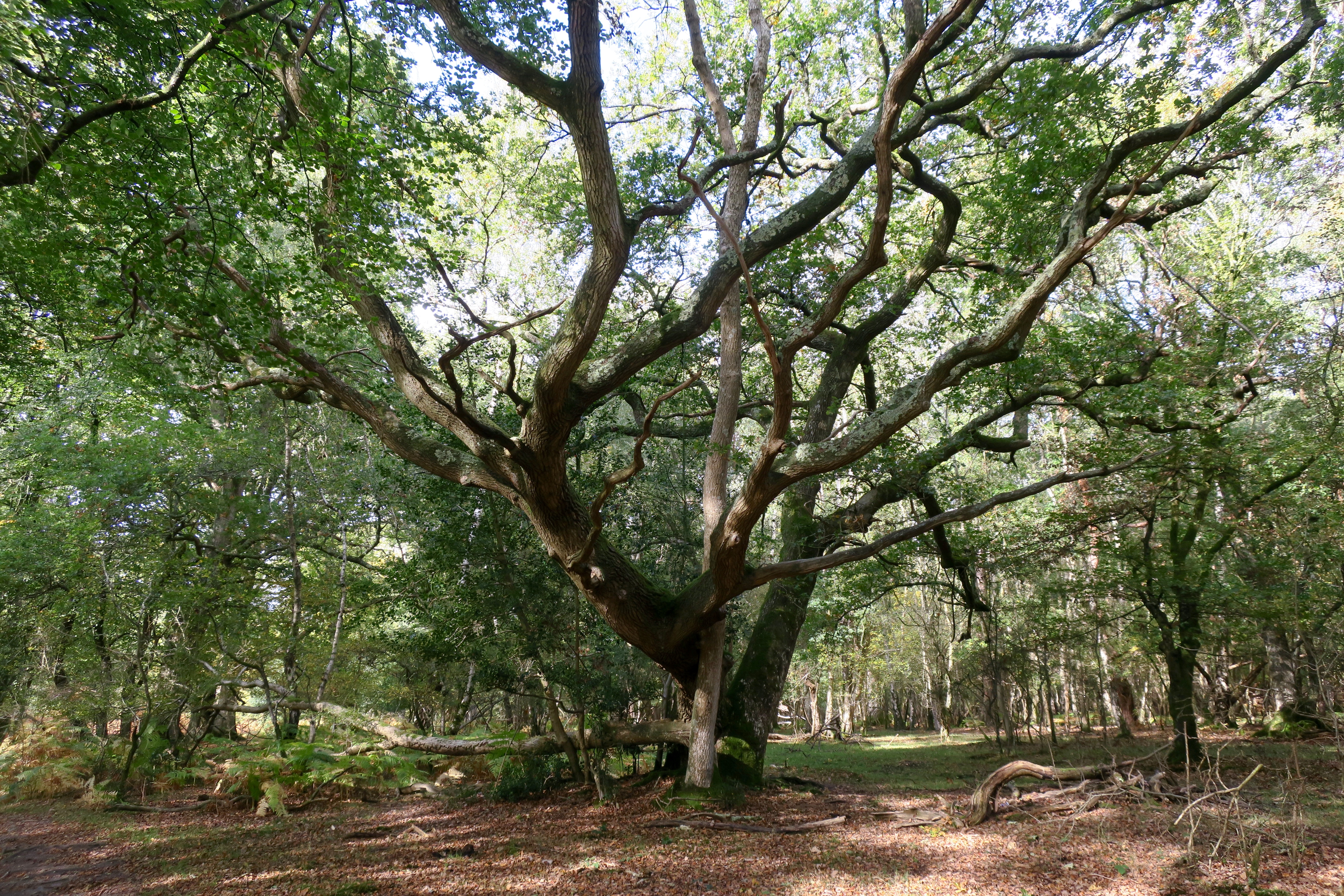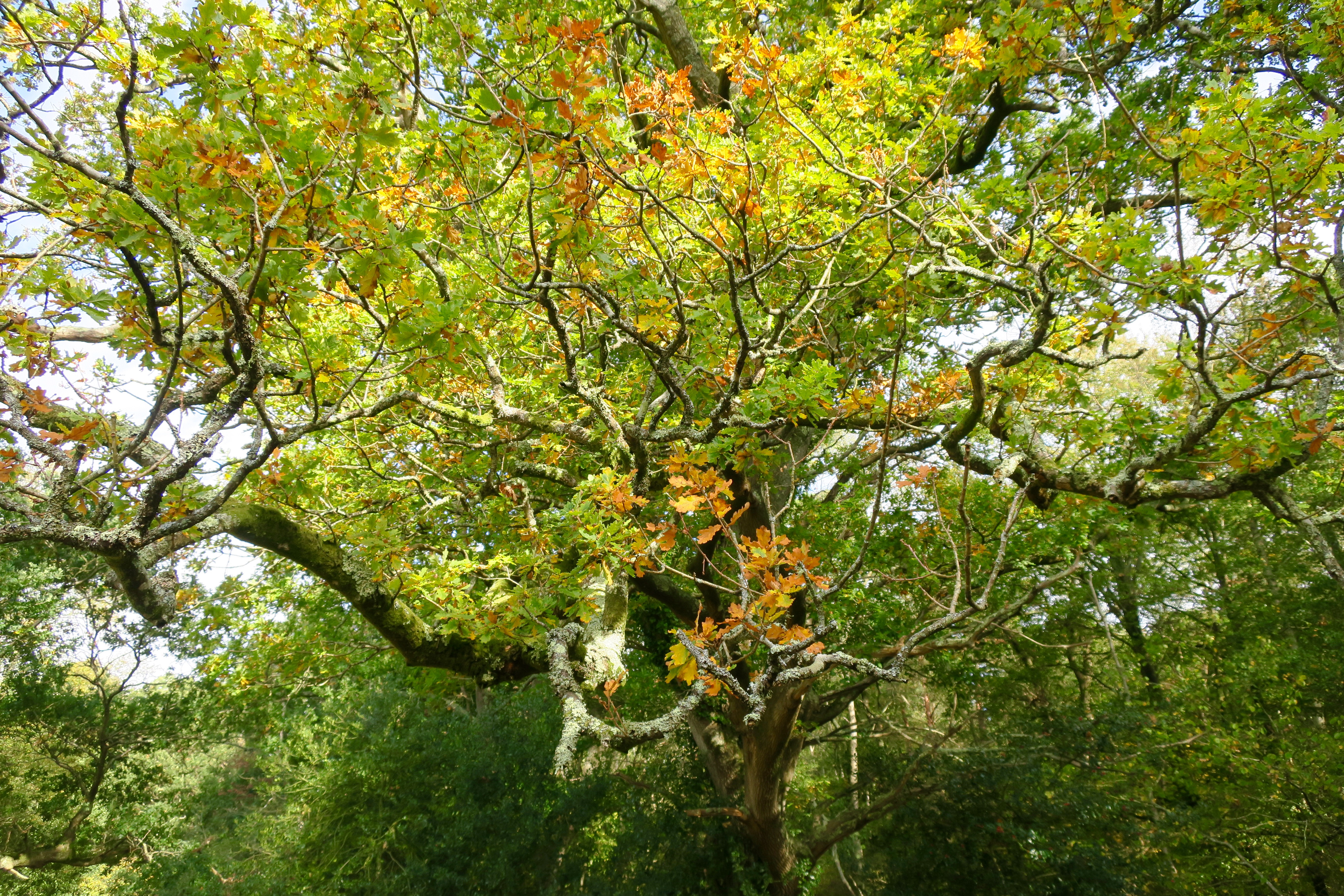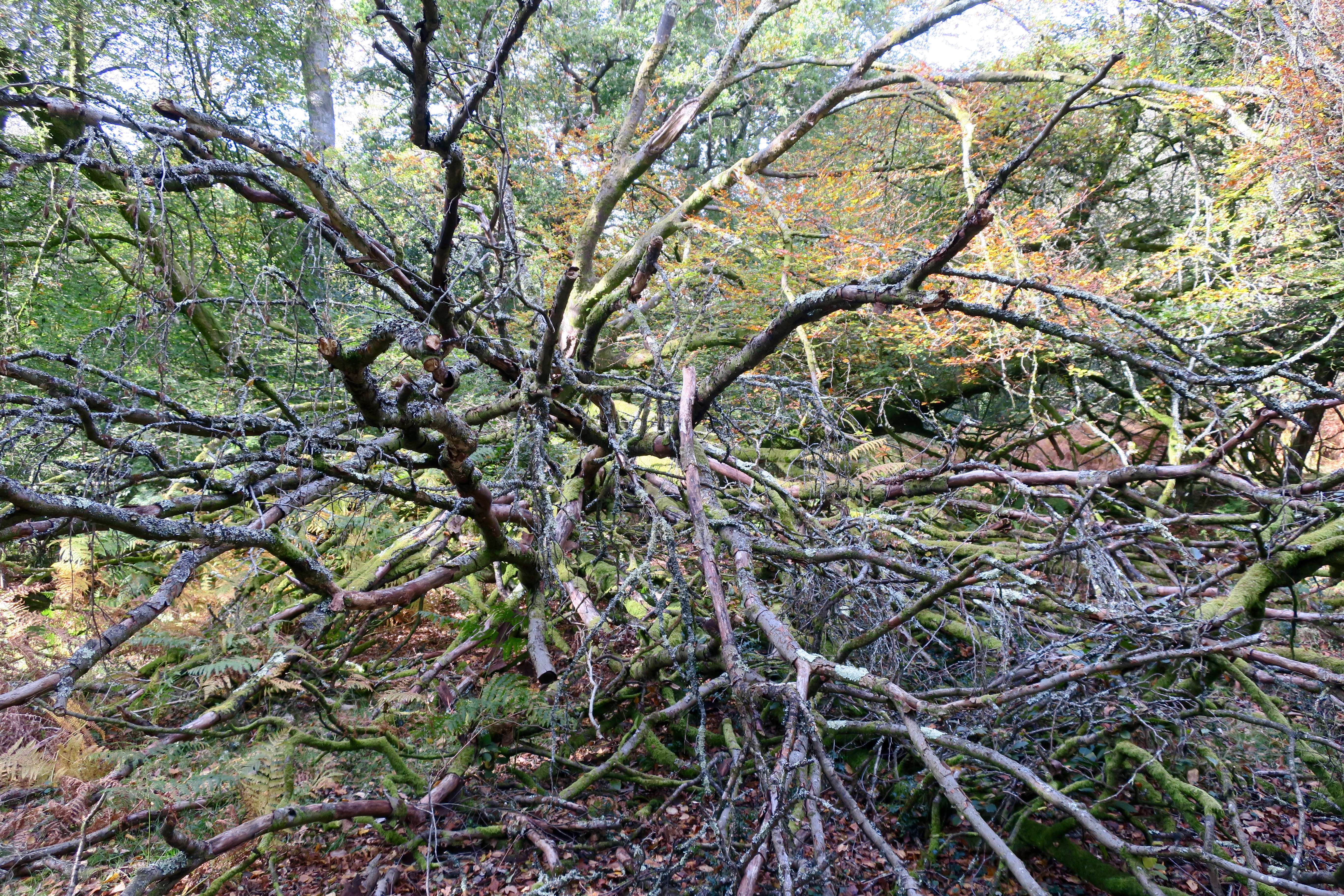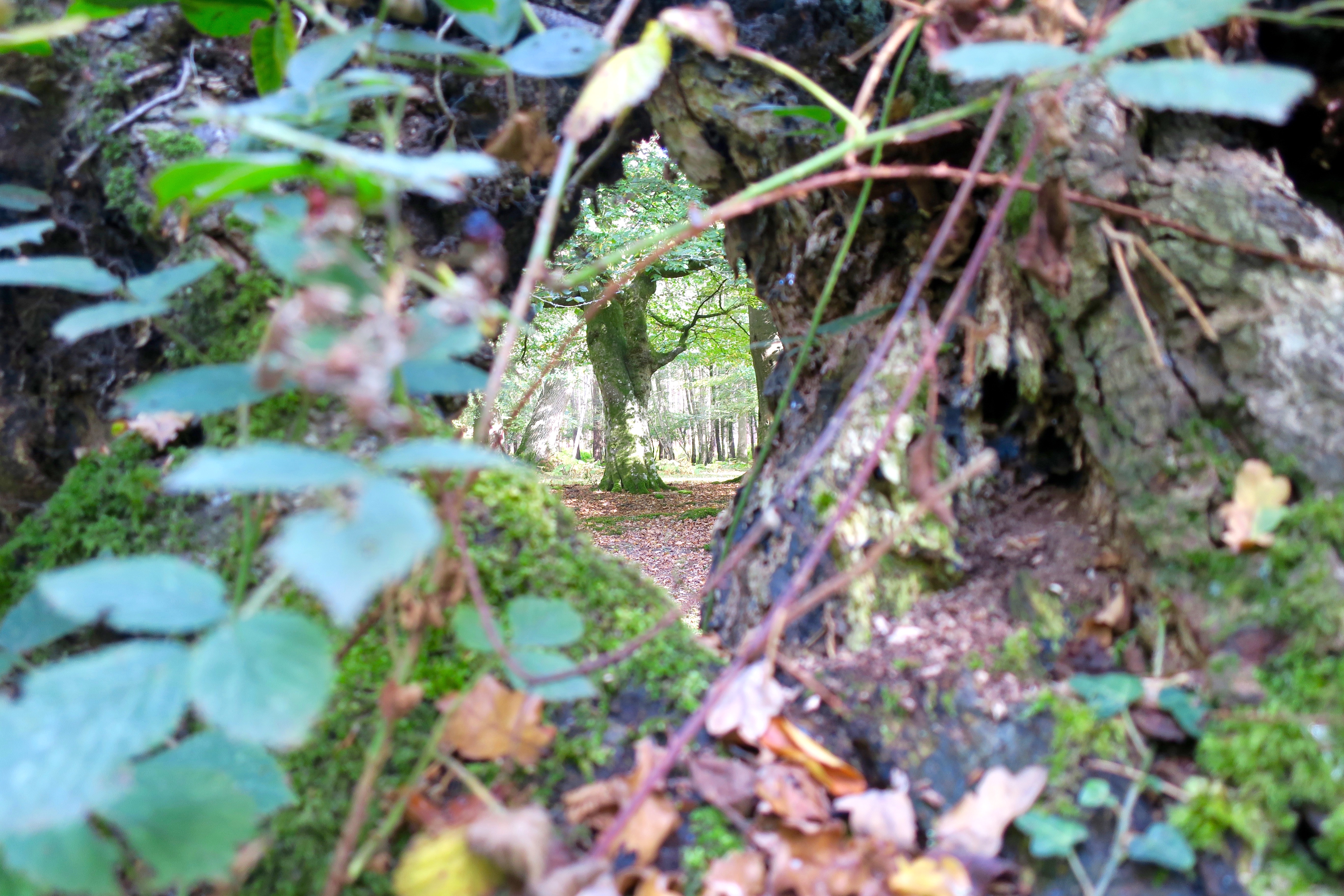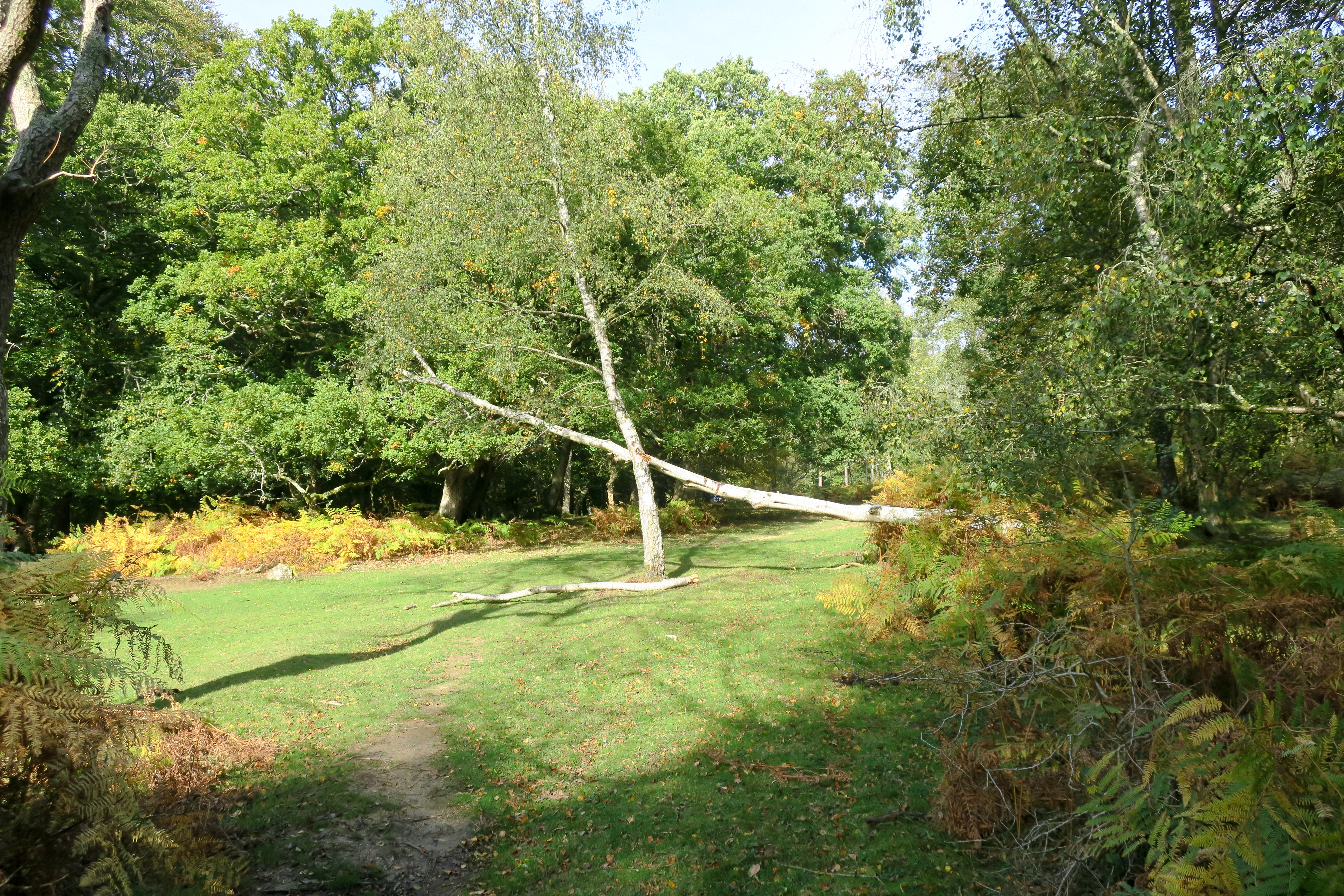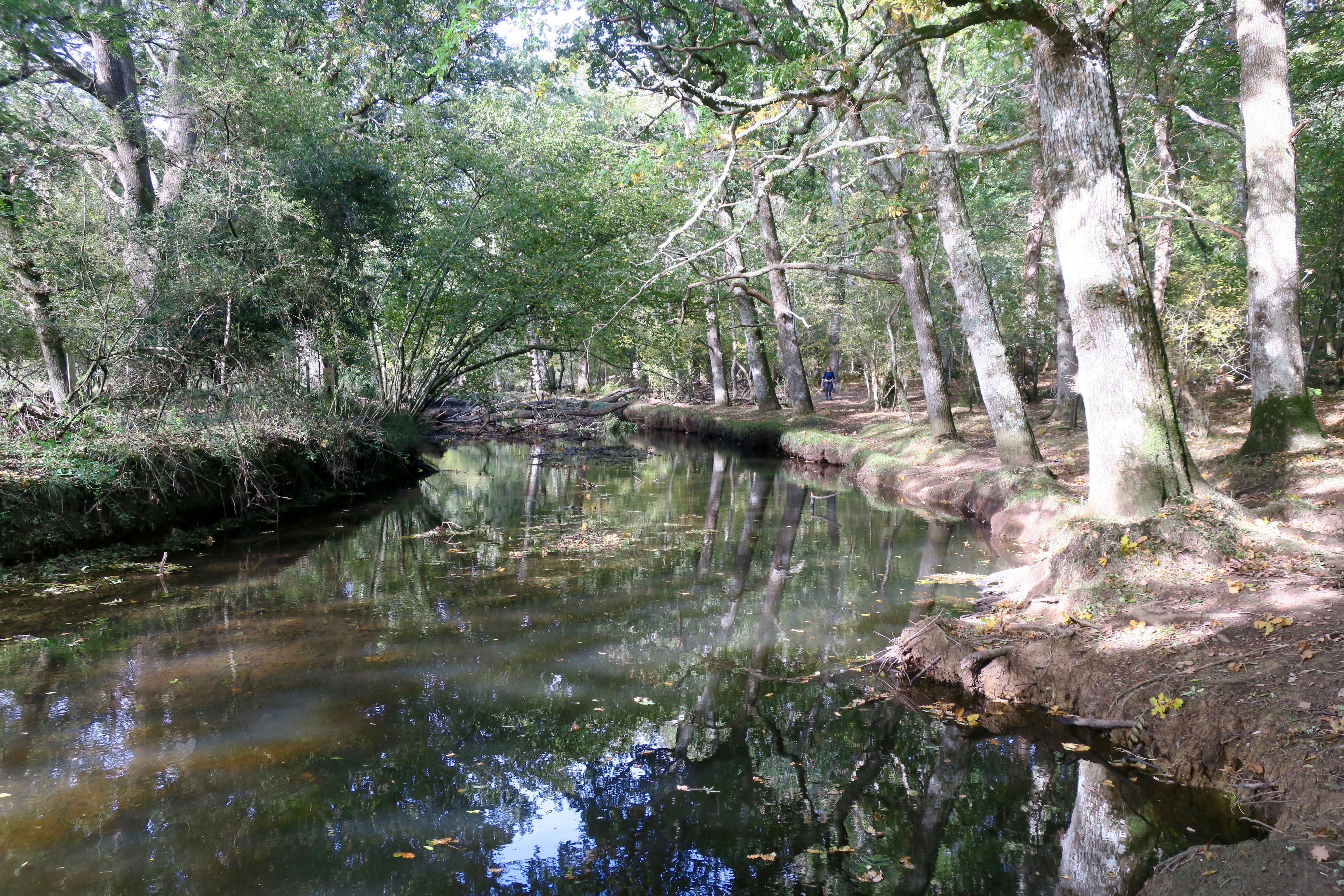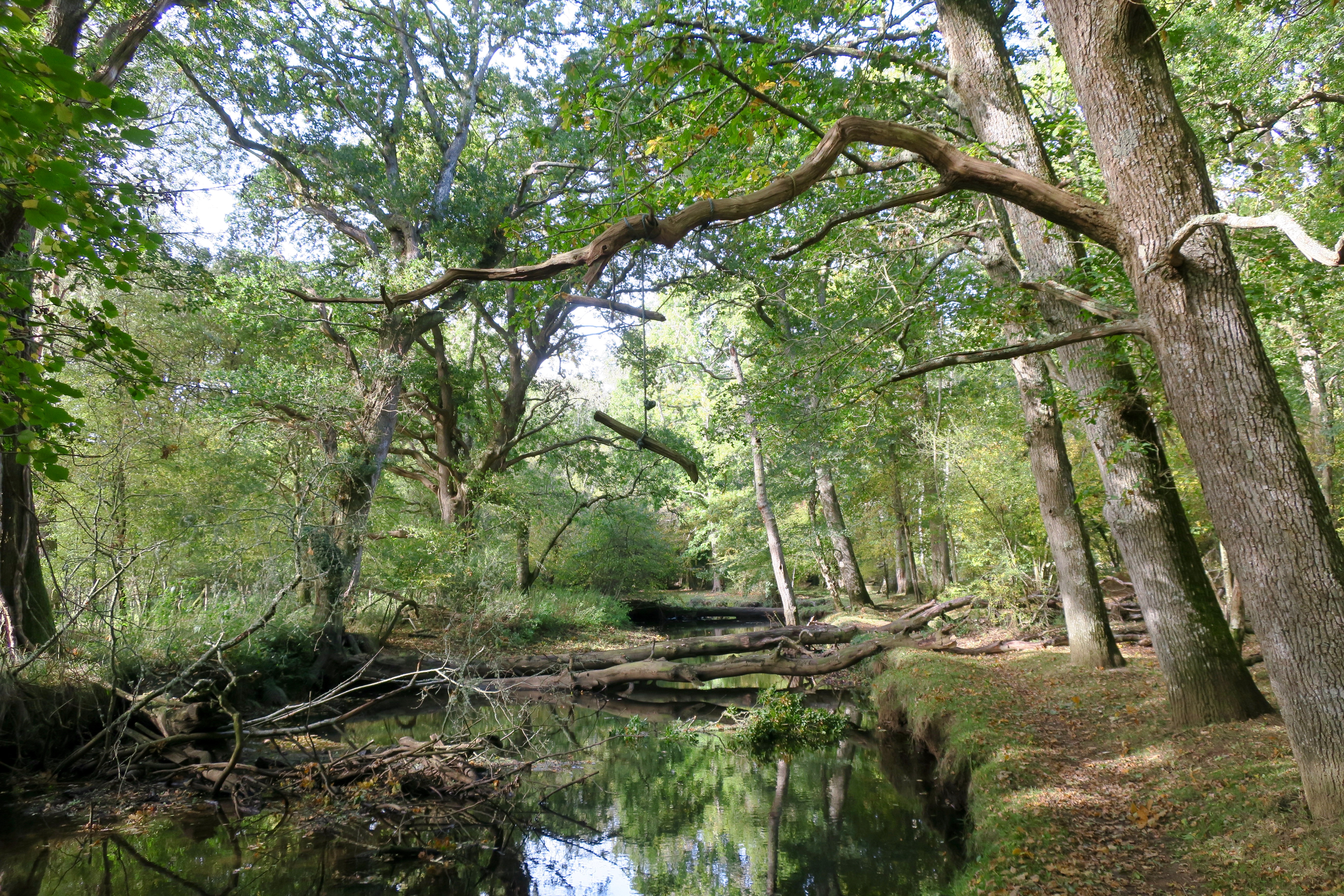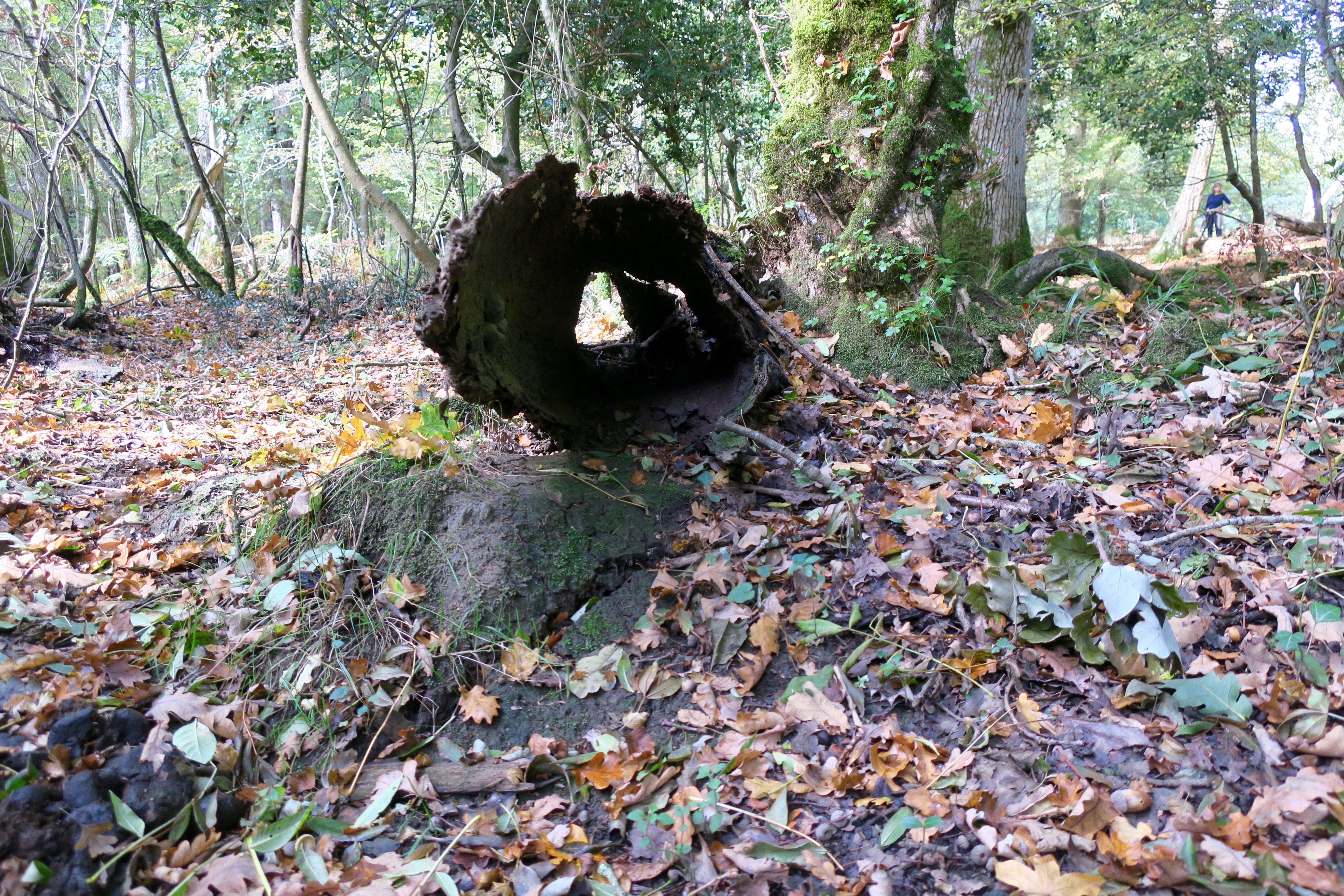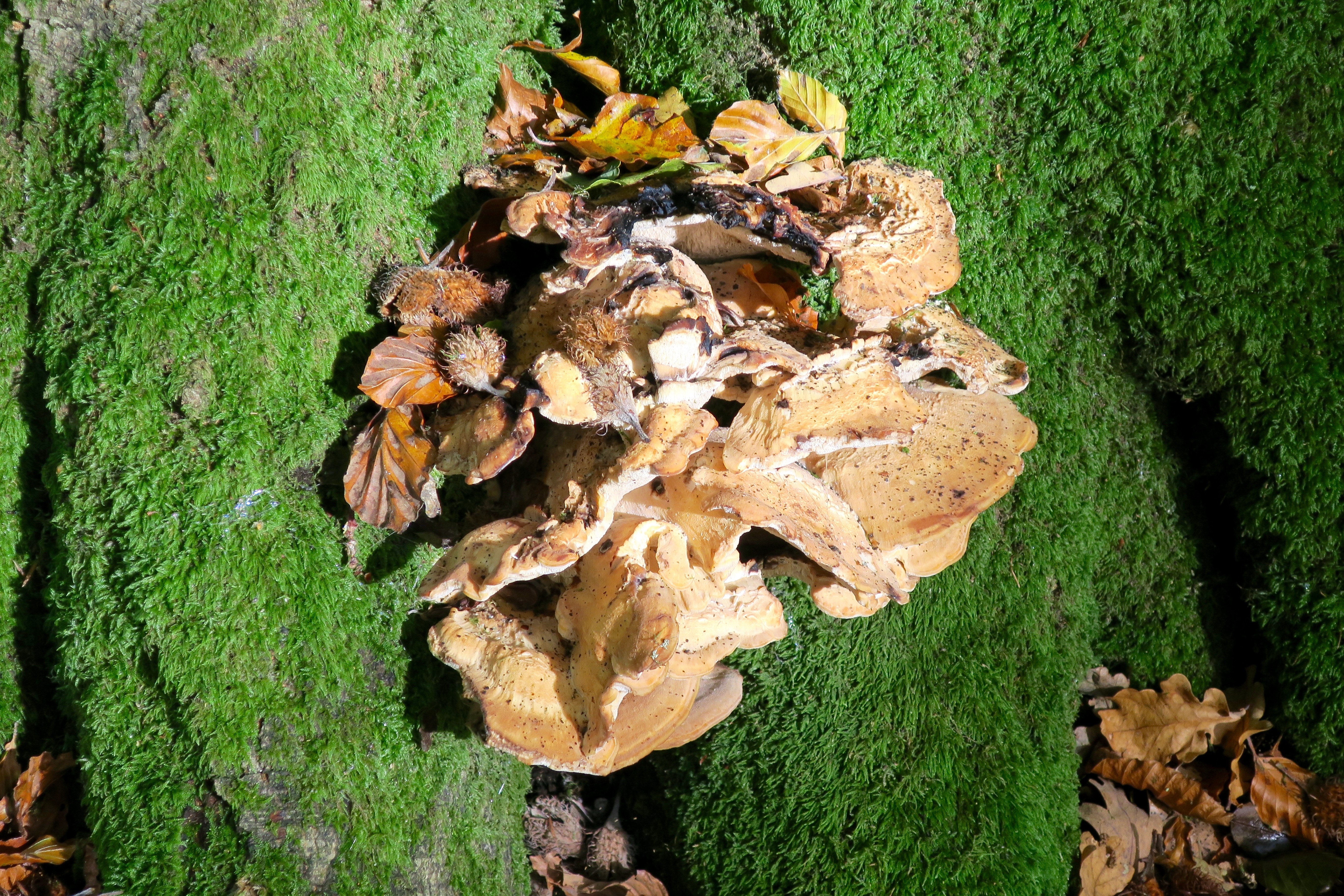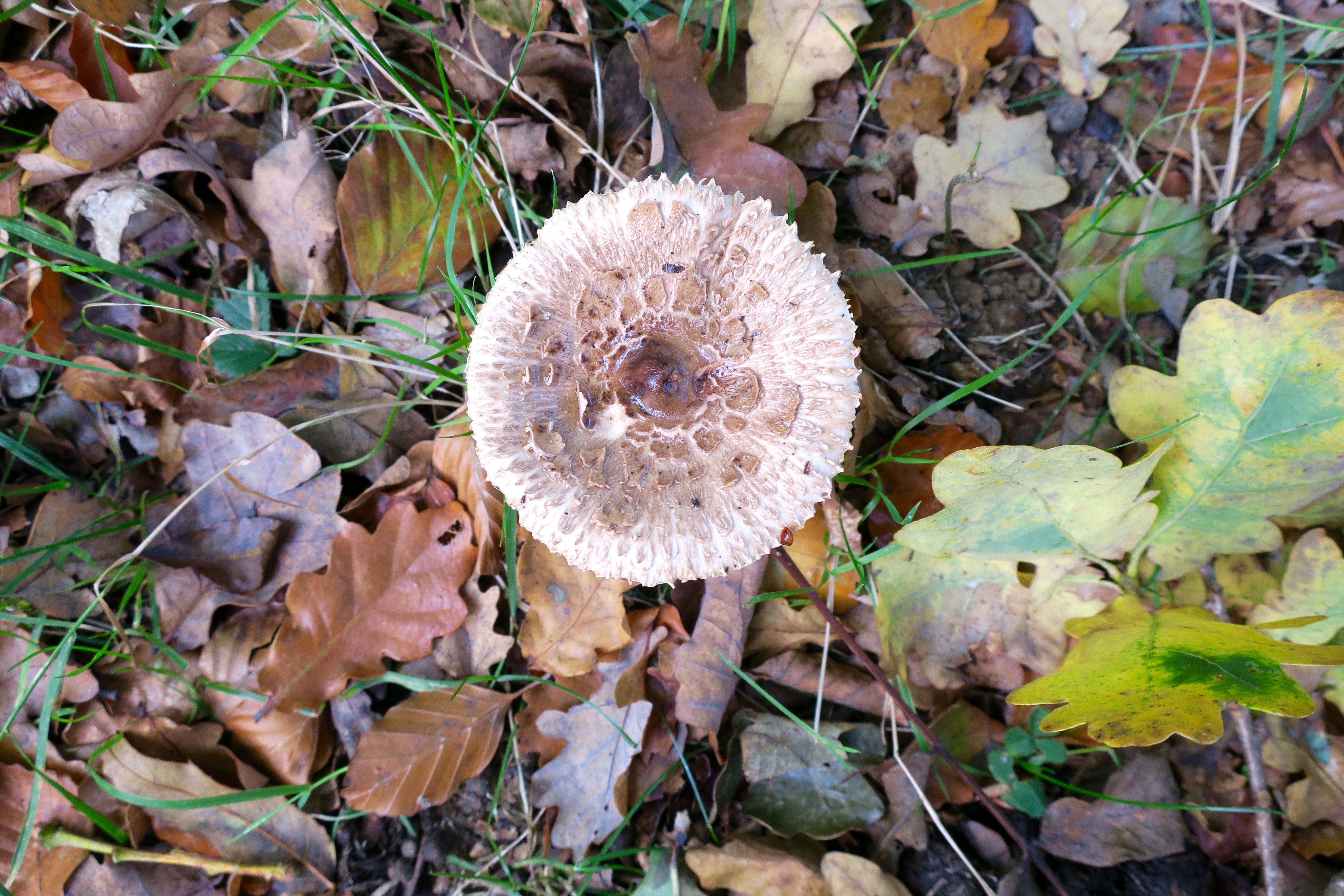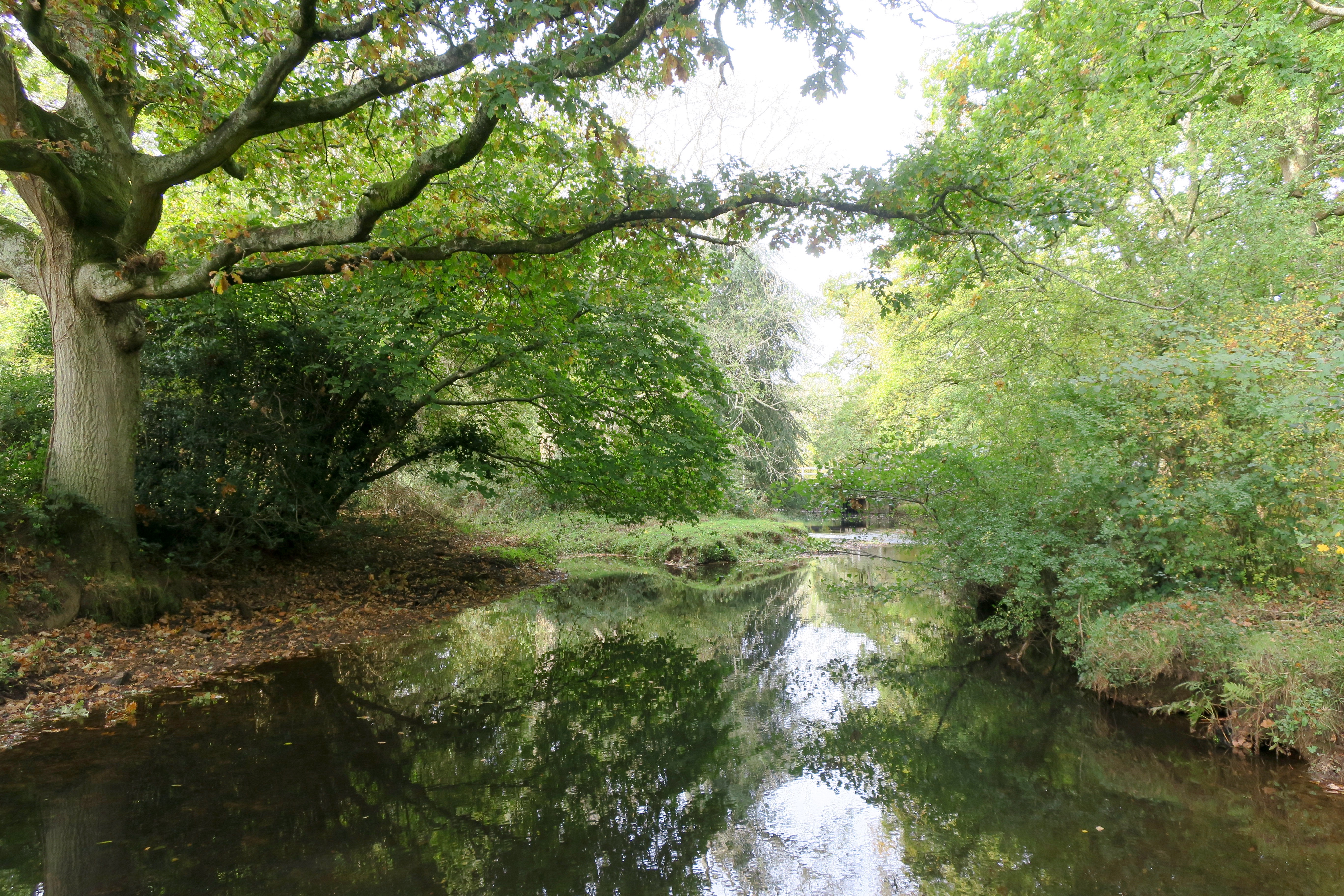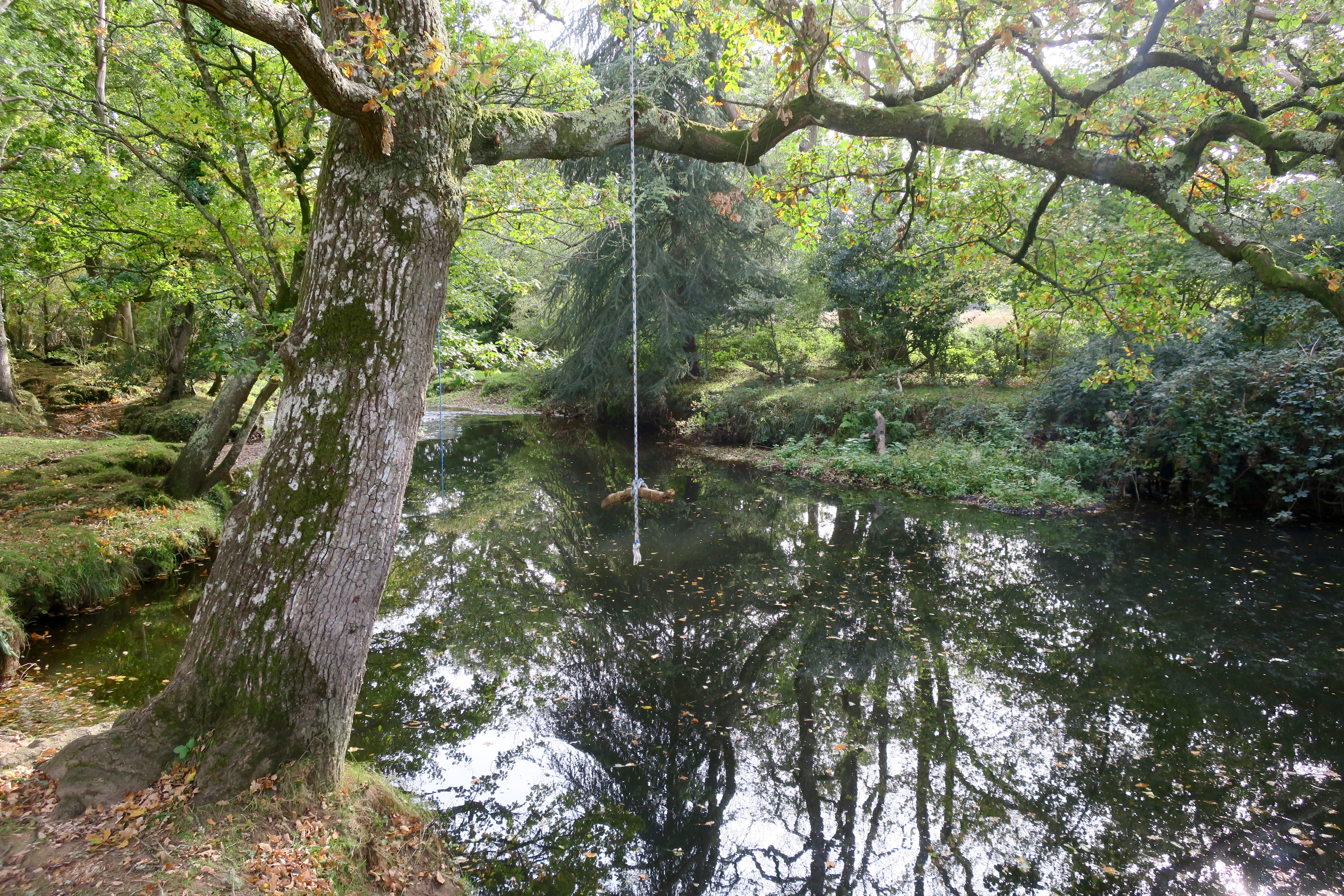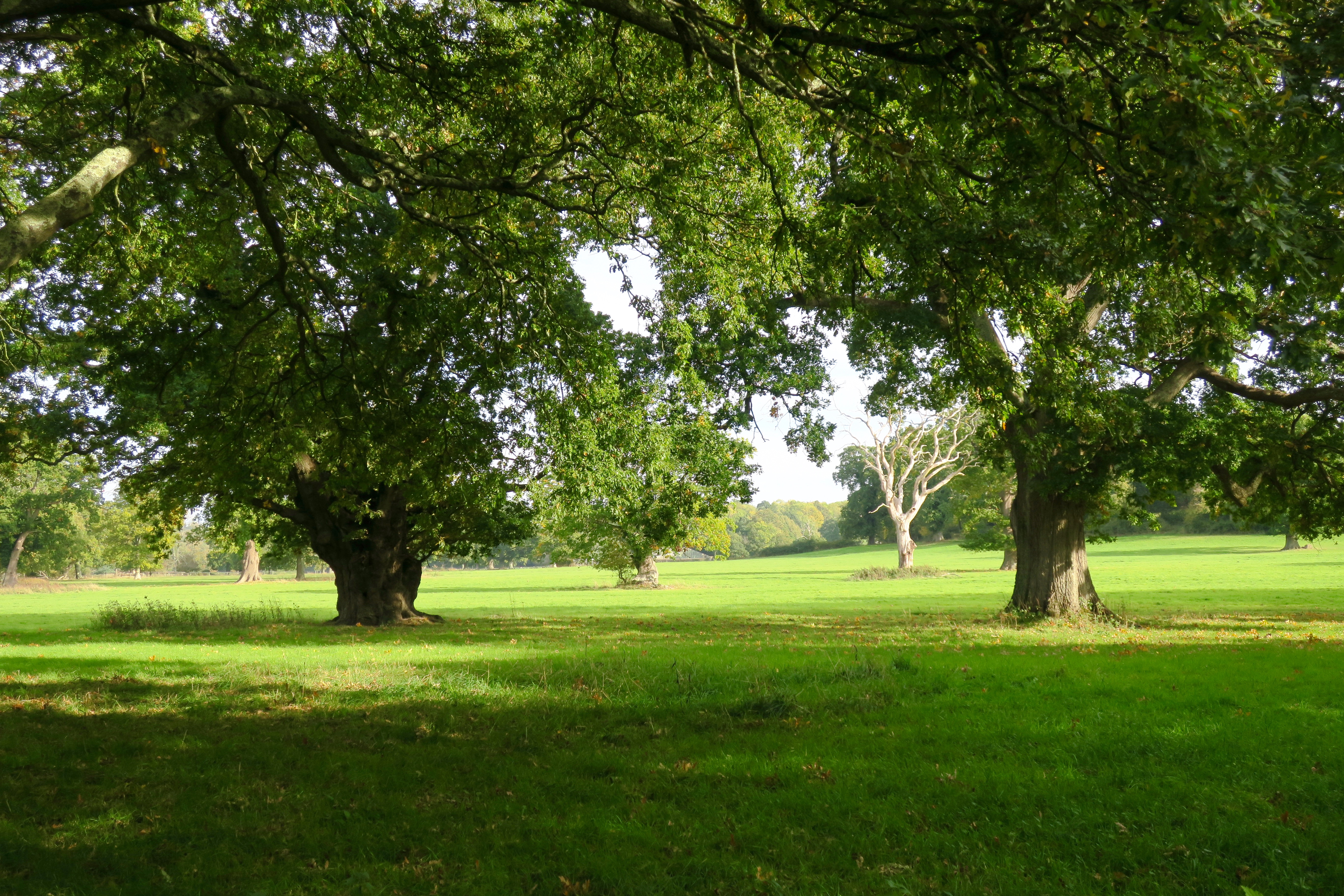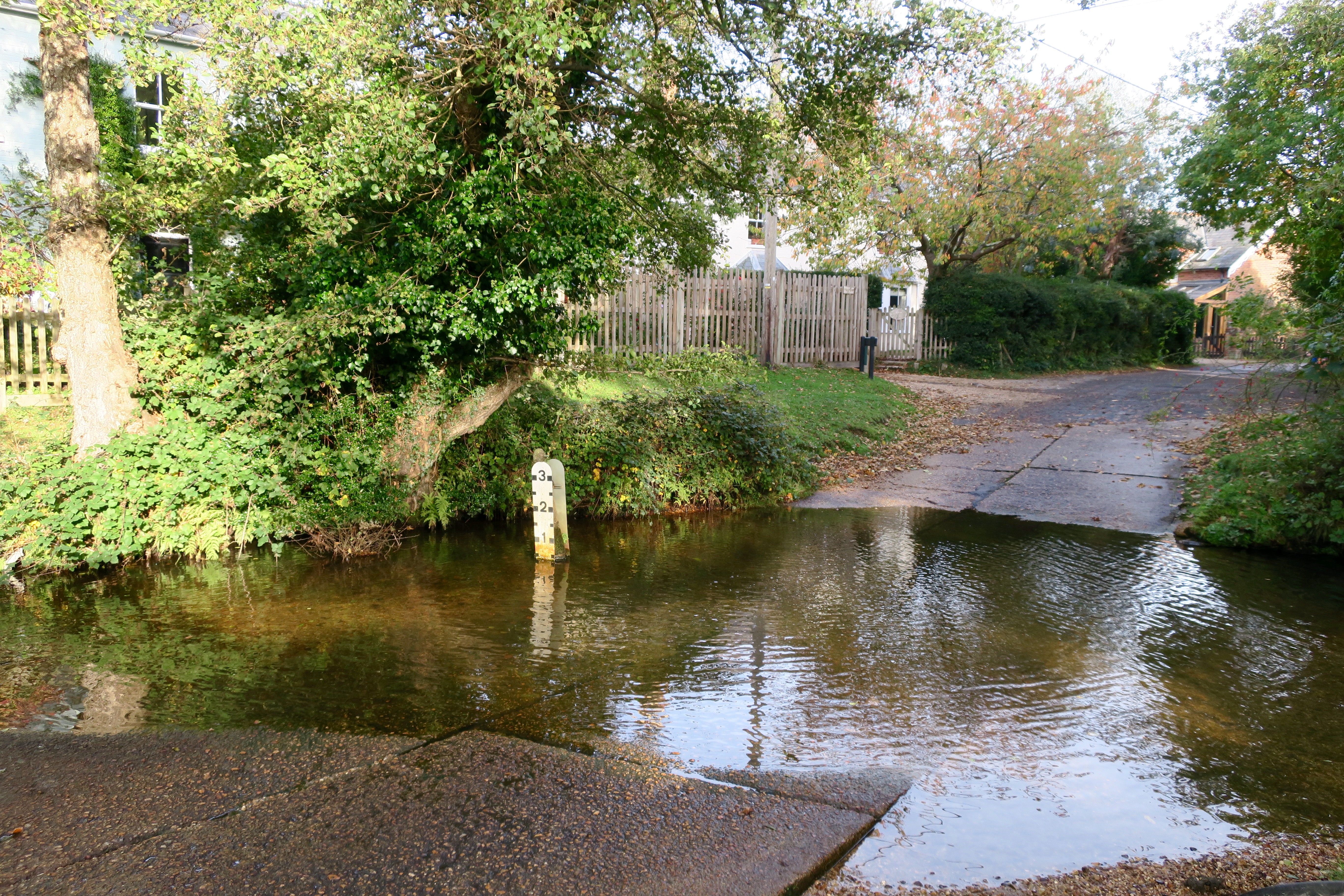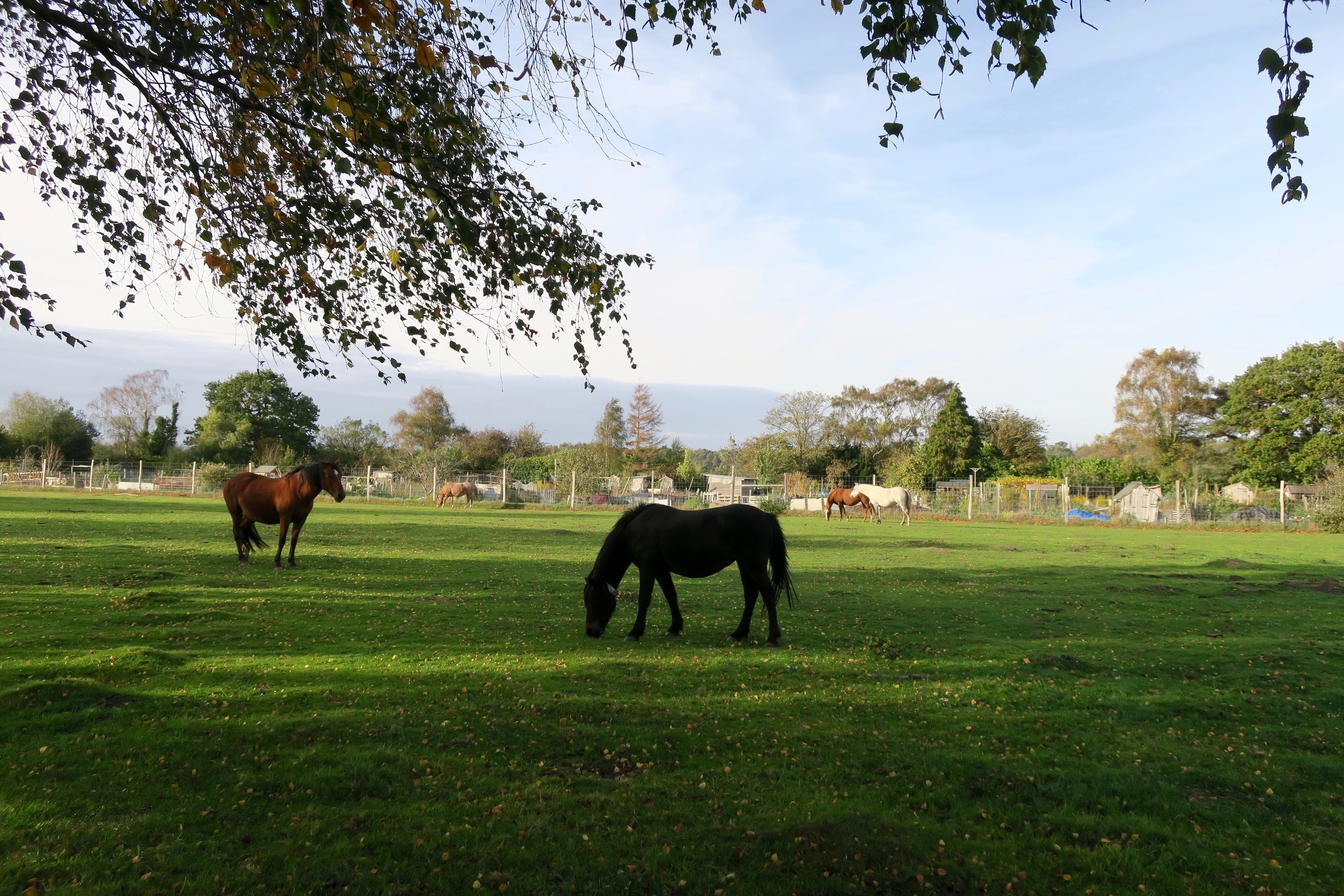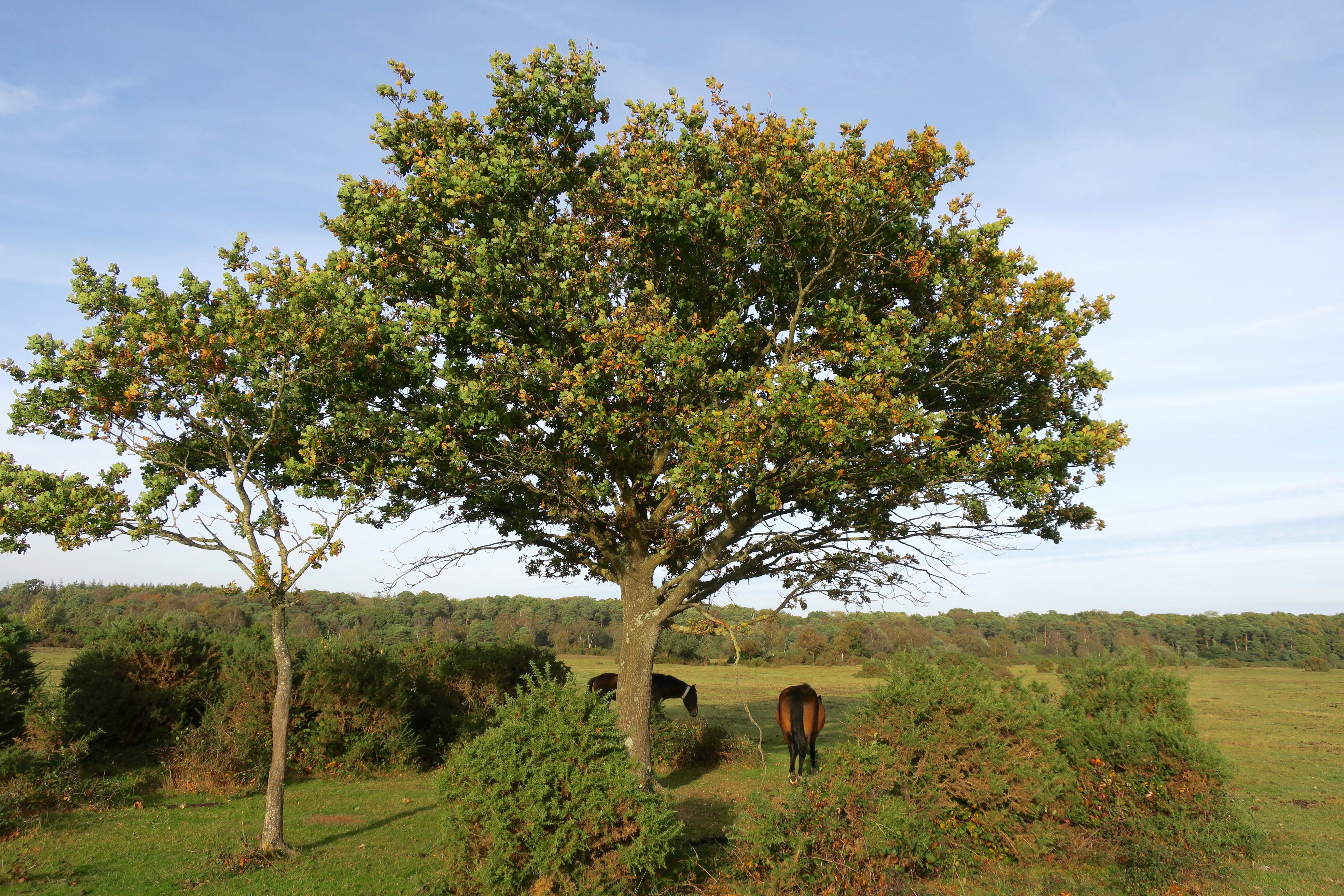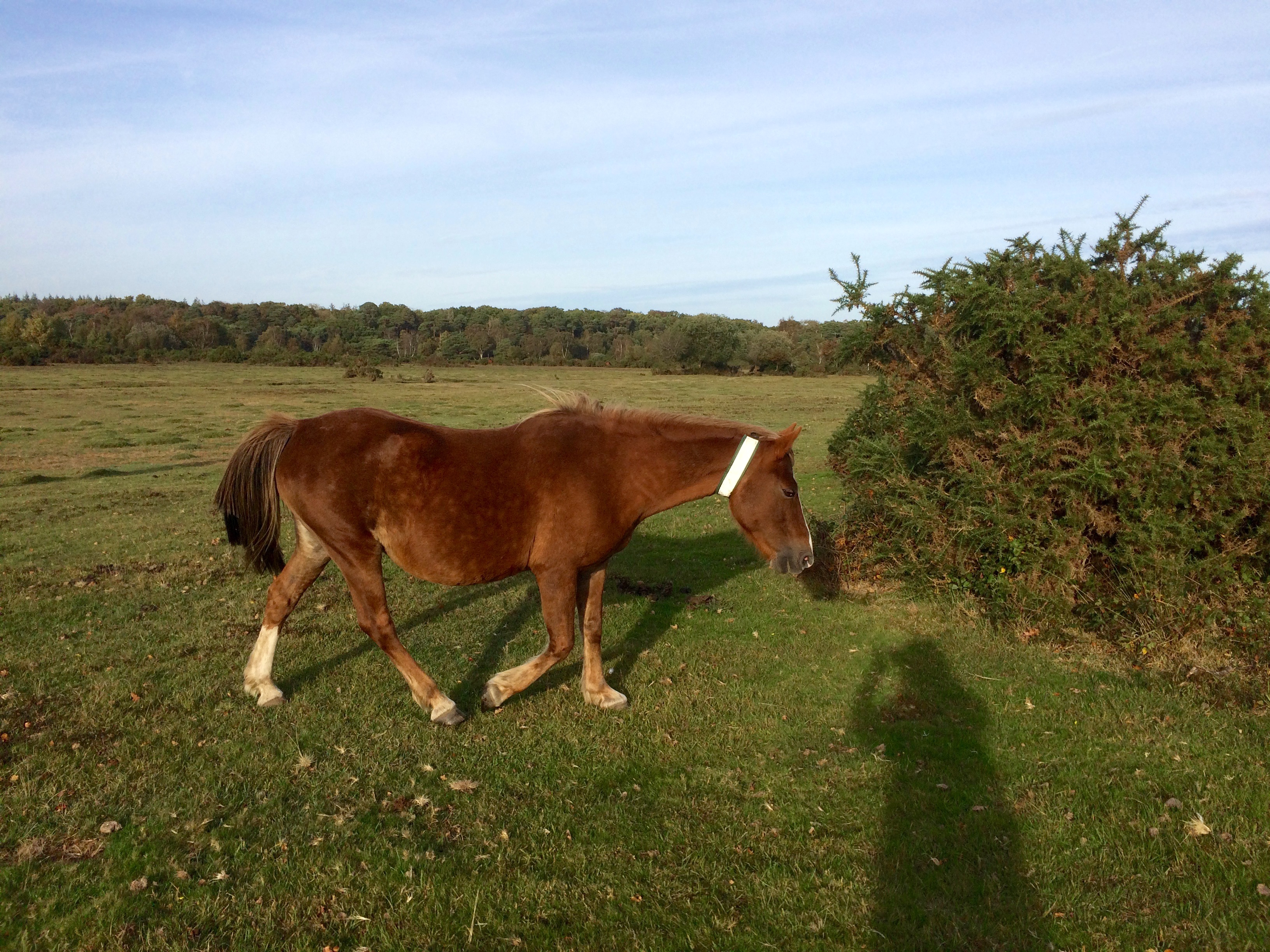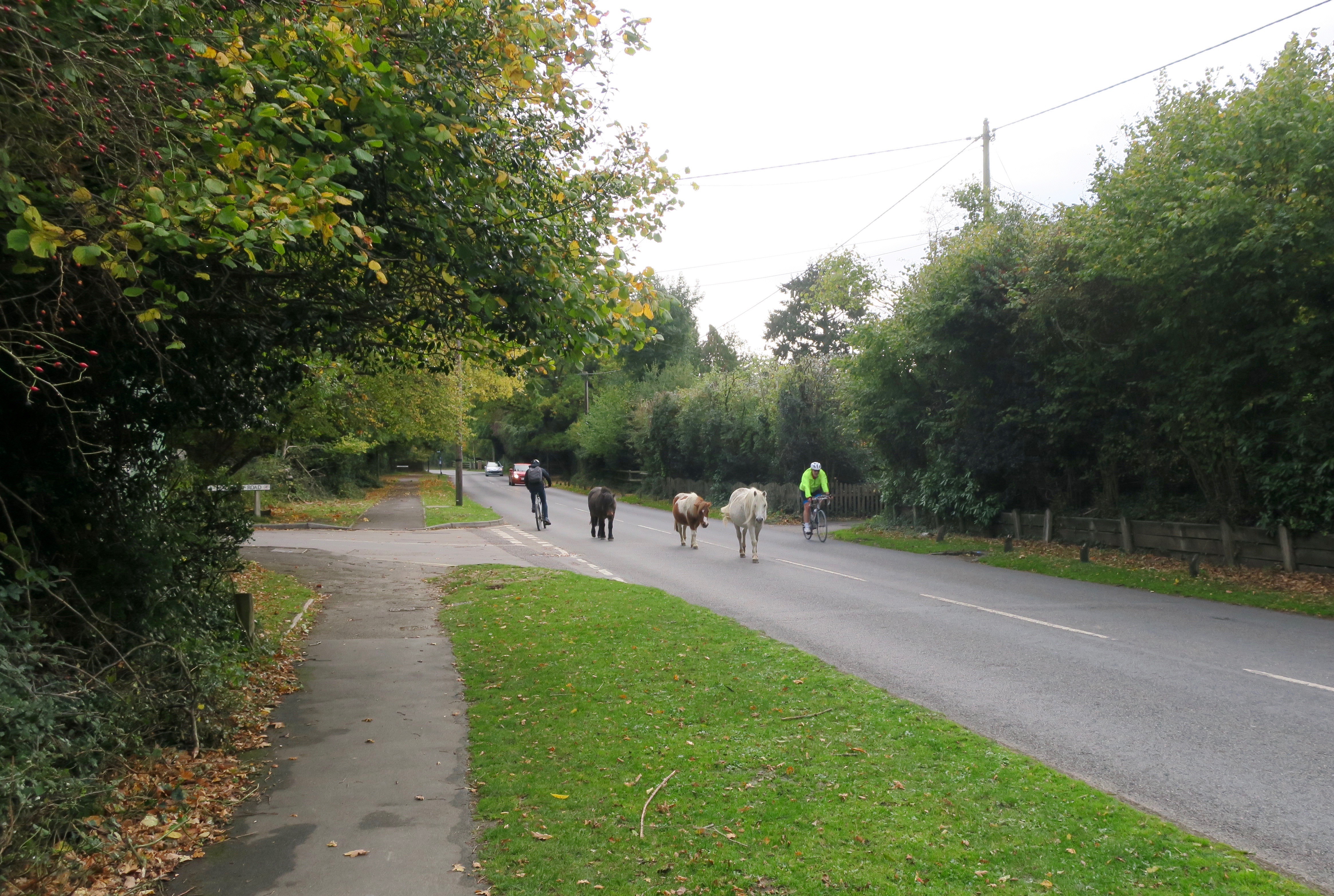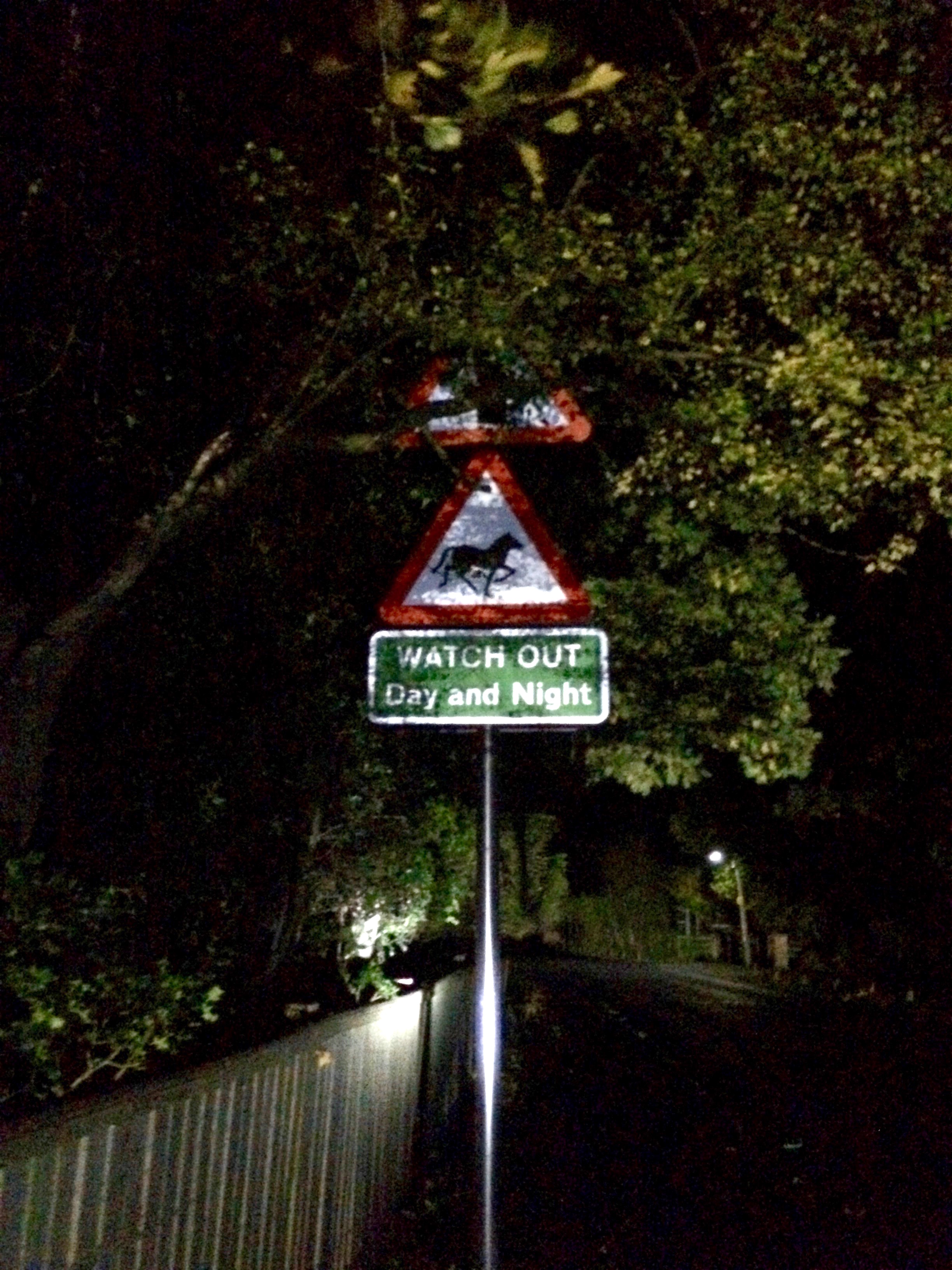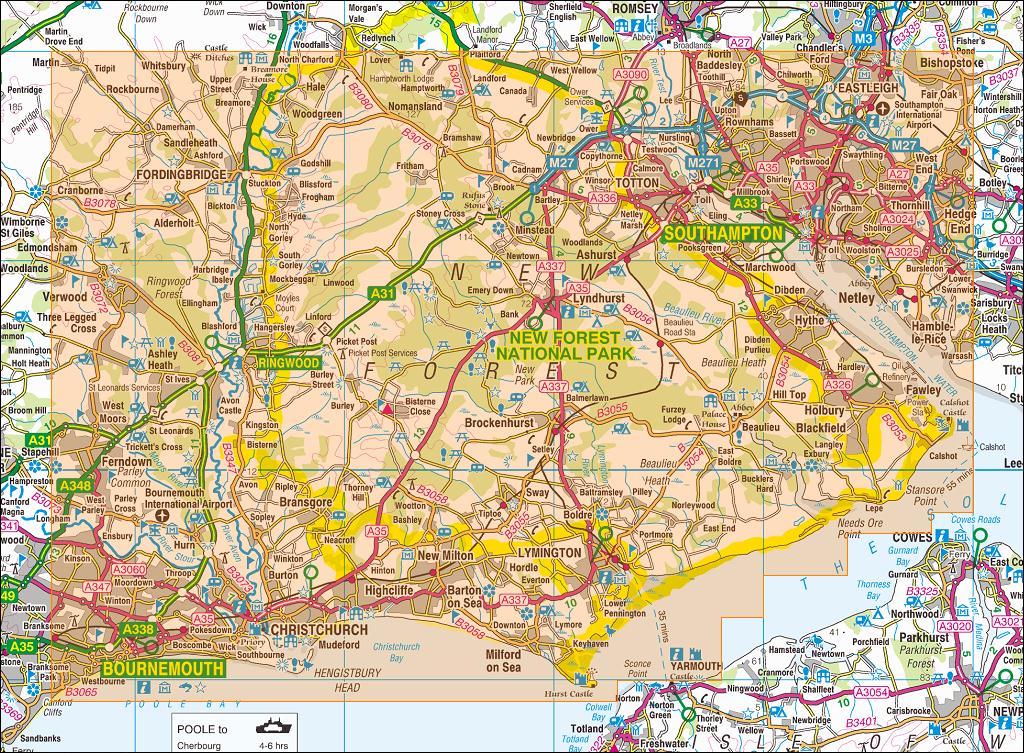The other side of this sign warns WATCH OUT Day and Night and it’s just where five donkeys came out of the darkness into our headlights as we arrived the night before. We saw the donkeys but didn’t see the sign. But that’s not why I took the photograph. I was curious about the holly, at first sight it’s a tree but then higher up it’s more like a vine reaching for the branches of the oak tree. High risk root.
We found another route through the holly to a forgotten footbridge over the railway tracks.
We were above Brockenhurst station, 92 miles from Waterloo in the middle of the New Forest.
The New Forest is one of the largest remaining tracts of unenclosed pasture land, heathland and forest in the south-east of England, covering southwest Hampshire and southeast Wiltshire.
It was proclaimed a royal forest by William the Conqueror, featuring in the Domesday Book. Pre-existing rights of common pasture are still recognised today, being enforced by official verderers. In the 18th century, The New Forest became a source of timber for the Royal Navy. It remains a habitat for many rare birds and mammals.
Like much of England, the site of the New Forest was once deciduous woodland, recolonised by birch and eventually beech and oak after the withdrawal of the ice sheets starting around 12,000 years ago. Some areas were cleared for cultivation from the Bronze Age onwards; the poor quality of the soil in the New Forest meant that the cleared areas turned into heathland “waste”, which may have been used even then as grazing land for horses.
There was still a significant amount of woodland in this part of Britain, but this was gradually reduced, particularly towards the end of the Middle Iron Age around 250–100 BC, and most importantly the 12th and 13th centuries, and of this essentially all that remains today is the New Forest.
The church of St Nicholas stands on its own down a quiet lane to the east of Brockenhurst. It is the oldest church in the forest and the only one recorded in the 1086 Domesday survey. Sadly its door was locked and a notice apologised that entrance was forbidden due to a collapsed ceiling. The huge yew tree beside the church has a girth of more than 20 feet and is known to be more than 1,000 years old.
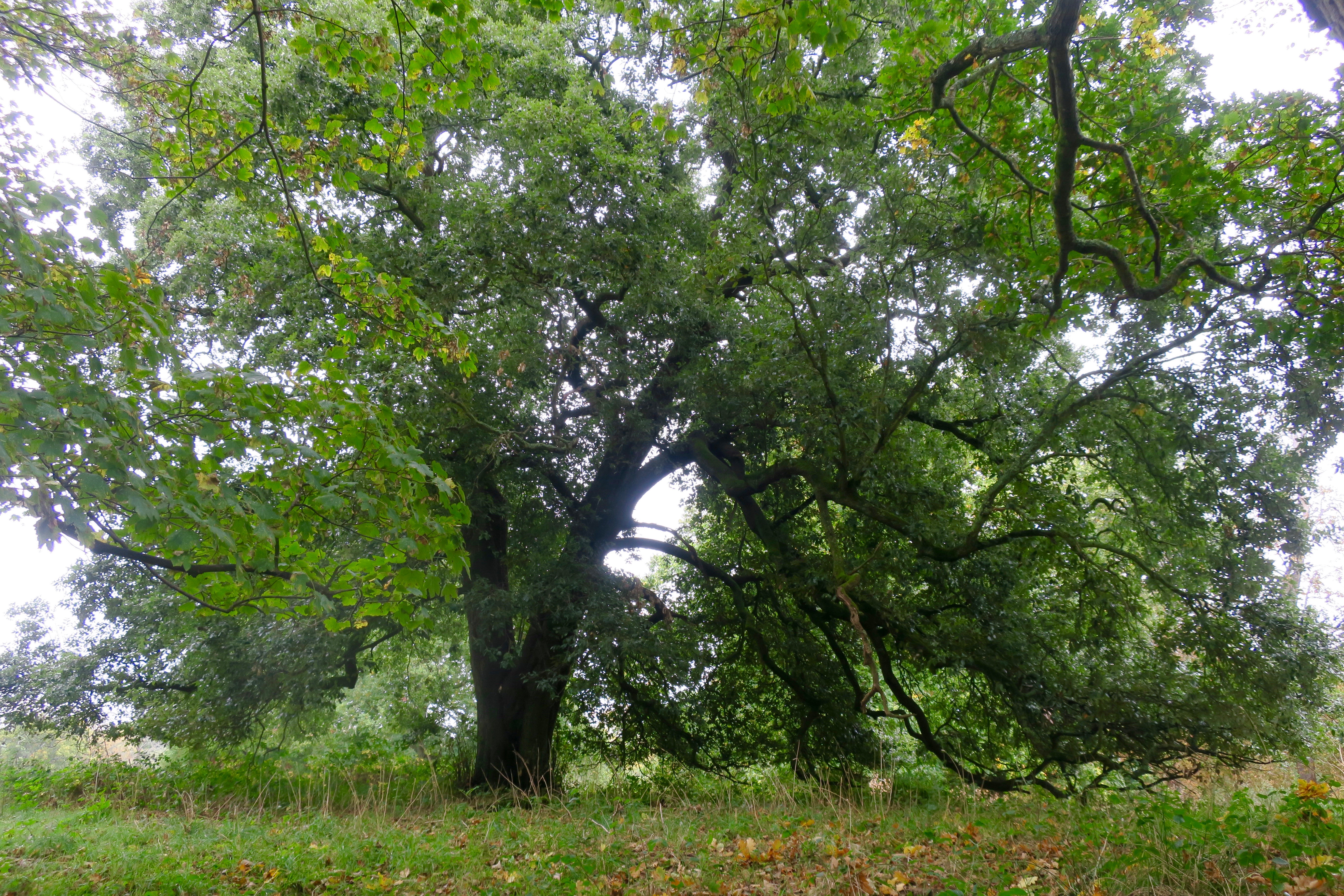
St Nicholas’s church is next to Brockenhurst Park where I’m intrigued. Is this a walnut tree? I wished I could climb the fence and get close enough to investigate. Walnuts are my favourite and they never taste so good as when they’re eaten fresh beneath the branches of the tree from which they fell.
I chase a treecreeper with my camera until suddenly it disappears.
The sky is noisy with the sounds of choughs, but more likely they’re jackdaws.
In Roydon Woods
I remembered Roger Deakin and his love of the New Forest, and when Oliver Rackham wrote about Roger’s last book, Wildwood: A Journey Through Trees, he titled his piece Child of the New Forest.
While a schoolboy Deakin had the good fortune to fall in with an enthusiastic teacher of fieldwork, Barry Goater, who introduced him to serious learning of plants and animals on camping expeditions in the New Forest. Among his fellow pupils was George Peterken, who has become the greatest living woodland ecologist. I was similarly fortunate to have been introduced to serious natural history by Ted Ellis. But who does this now? Trees and plants and animals have been relegated to the environment, to a branch of the televised entertainment that Deakin hated. They are no longer fun. Who now introduces children to see and listen to and handle real living creatures as themselves, as three-dimensional personalities, eccentric, seasonal, each pursuing its own agenda?
Child of the New Forest: Oliver Rackham
I’m looking at one of the black-and-white photographs that feature in the gallery on my study wall. My younger self is there in plimsolls, khaki shorts and elastic snake-buckle belt, standing on Campsite Track beside a donkey. I’m holding up my butterfly net like a semaphore flag, and a knapsack, probably full of collecting jars, is slung over one shoulder. Campsite Track led across the heath to our tents, sheltered and concealed within a series of hollows in a range of gorse-topped, gravel dunes above a railway cutting on the Bournemouth line.
This is where I first came to know the New Forest, returning several times to camp at Beaulieu Road during the school holidays with the Botany and Zoology sixth form and our Biology teacher Barry Goater, who was in his first teaching job, in charge of the school Biology Department. A formidable lepidopterist, ornithologist and all-round naturalist, Barry infected us all with his wild enthusiasm.
Although he would modestly deny it, Barry Goater was the instigator of an extraordinary educational experiment. In a quiet corner of the New Forest, he established a camp for the detailed study and mapping of the natural history of a stretch of the wild forest woodland, bog and heath surrounding Beaulieu Road by his Biology sixth form. The camp became something of an institution at our school in the relatively treeless Cricklewood. It was traditional for each generation of us sixth form naturalists to return there again and again and taste the intoxicating pleasure of exploration and discovery in the wild for ourselves. Each of us had a particular project, literally a field of inquiry, and the work we were doing was genuinely original. We learnt the scientific disciplines of botany, zoology and ecology, and we kept our eyes open as all-round naturalists. What we discovered was particular to the place, and, best of all, it belonged to us.
Wildwood: A Journey Through Trees: Roger Deakin
X marks the spot
Extreme Energy
But we were going the other way. GRNX. Green Exercise. All the way we went against the flow, face to face with an oncoming tide of cross-country runners. And we were glad to be happy-country walkers.
Everyone knows how to walk. One foot in front of the other, that’s the proper rhythm, the good distance to go somewhere, anywhere. And all you have to do is resume: one foot in front of the other… During long, easy walks, on well-traced routes, when all you have to do is follow an interminable set of hairpins, you hatch a thousand plans, invent a thousand tales. The body slowly advances, with measured steps, and that same tranquility gives the mind a day off. Relieved of duty by the automatic functioning of the body, it follows up its fantasies and projects itself into a labyrinth of stories. While the gentle shock-free rolling of happy legs drives the evolving narrative forward: challenges arise, their solutions are found, fresh ambushes appear. As you follow the wide, single, clearly marked route, a thousand bifurcations swarm in your mind. The heart takes one and renounces another, then chooses a third. It wanders away, comes back… In the end, from those paths bathed in the tranquility of a tired sun, the gentleness of dead leaves circling to the ground, the deep slow natural breathing, from there the civilised world, society with its fears, its tinpot grandiloquence, its electric thrills, its furies: all that, seen from down there, from behind the sweet barrier of trees, seems nothing more than one long-drawn-out disaster.
A Philosophy of Walking: Frédéric Gros
Roydon Manor
W.H. Hudson (1841-1922), writer and naturalist, wrote ‘Hampshire Days’, first published in 1903 and one of his best known books, whilst staying at Roydon. He writes in the early pages of the house that gave him shelter: ‘A small old picturesque red-brick house with high-pitched roof and tall chimneys, a great part of it overrun with ivy and creepers, the walls and tiled roof stained by time and many-coloured lichen to a richly variegated greyish red. The date of the house, cut in a stone tablet in one of the rooms, was 1692.’
Hudson went on to say: ‘…the place, originally a manor, had been turned into a farm-house’; and to recall walks beside the nearby river: ‘by the Boldre, or, as some will call it, the Lymington, a slow, tame stream in summer, invisible till you are close to it…’
The footbridge over the Lymington River, a place to slow down and dawdle and be dazzled by dappled reflections, whilst XNRG runners squeeze past on the bridge or splash determinedly through the ford.
The path rises up beyond the river through glorious illuminated beech trees.
At the top of the hill we met a cow and a calf so we stepped aside to let them pass.
Then a late brimstone butterfly danced in the sunlight. Here it’s become a bramble leaf.
And here, look closely, it’s chased by a surprised pheasant flushed from its cover.
A green bottle top caught like navel fluff.
Yet it strikes me now, as I write in October, that we only think about the forest when it is dying, when its leaves turn into beacons of their own burning beauty. For a few short weeks we come to pay our respects, recalling our collective childhoods, remembering, perhaps uneasily, our vexed adult relationship with the natural world. As Richard Mabey notes in his ‘Cabaret of Plants’, we often only take notice of nature when it suits us, to feed our human needs; we seldom see it for its own sake. Trees, like other plants, have become commodities; an index of capital, rather than celebrated merely for being themselves.
The New Forest. The ‘New’ Forest. Caught between Bournemouth’s resort to the west and the industrial spires of the refinery to the east, backed by middle England and looking out to what was the ancient River Solent and the chalk-white Isle of Wight (where, recently, new petrified trees were found), ‘the Forest’ (just as the Island is ‘the Island’) straddles 144 square miles of heath and woodland. It is an hour and a half from London by car or train, and although one may still get lost in its depths, it is hard to see it as a primeval or even threatening place. Rather, it has become a playground where foragers gather supplies for distant deluxe restaurants, and where middle-aged men in Lycra ride five-abreast along lanes occasionally strewn with tacks by locals protesting at this appropriation of their land. ‘Wilderness’ would appear to be the wrong word; ‘bewilderment’ might be better applied to the long-running battle over its meaning and function. And how much better to be be-wildered?
This forest, which is not a forest (first-time visitors stand wonderingly at its blasted heaths and their lack of trees), has attracted many utopians and dreamers, ritual acts and mysterious narratives over its thousand year history. But it was in the long nineteenth century – which began with most people living in the country, and ended with most people living in the towns – that the Forest became an antidote and an alternative to the gravitational pull of the city and the age of mechanical reproduction.
We follow the path between barbed wire fences alongside fields of forgotten farm machinery, down into the valley and over a stream, skirting the edge of a field of ponies. And suddenly we stop, caught in our tracks by the sight of a piglet running down the path towards us. (Sorry, it’s not a great photo!)
True commons have their roots in the medieval system of land tenure, when the lord of the manor, who owned all the land, bagged the best bits for his exclusive use and the poorer people, the commoners, secured specific rights on the rest. They could graze animals, gather wood, bracken and turf. If they were lucky they could catch fish. There were six specific rights of common, including estover, the right to take wood from a common (important if you were a hurdle maker, or needed to repair a pigsty), turbary, the right to cut turf for fuel, and pannage, the right to graze animals on beech mast and acorns. This right is still exerted in the New Forest (run under its own rules), where each season herds of pannaging pigs happily stampede through autumn picnics. But many commons have lost their old, economic purpose and gradually acquired new ones, more to do with access, recreation and the conservation of wildlife than the survival of poverty-stricken labourers.
These pigs are not, strictly speaking, pannaging but maybe they’re free range specialists.
We came by a ramshackle collection of farm buildings and old overgrown Nissen huts, through a yard of loudly lamenting cows and ponies quietly circling under the trees, downhill past pools of fallen apples and the outstretched branches of oak trees directing us to the confluence of two forest streams.
Beech framed by beech, seen through the roots of a fallen tree.
X marks the spot
The New Forest is the largest area of unploughed, unsown lowland in Britain, and in consequence it has extensive areas of diverse habitats which have disappeared from elsewhere: 36,000 acres of old deciduous woodland; 29,000 acres of heath and grassland; and another precious 8,200 acres of wet heathland and bog. These are all broken into small patches like mosaic tessera. There are also over 20,000 acres of plantation trees, some from the eighteenth and nineteenth centuries, but mainly planted since the 1920s. There is, in addition, a 26-mile coastal strip looking out over the Solent towards the Isle of Wight.
This splendid variety has led to the survival of a rich diversity of life forms, too: plants, birds, insects, reptiles and mammals, some found nowhere else in southern England, hang on in the New Forest. For complicated historical reasons, it has been continuously used for common grazing – by cows and pigs, and particularly the ponies, which are now a notable tourist feature and more than earn their daily hay. As I have already suggested, woodland does best when it is properly used by humans – coppicing and pollarding extend the life of individual trees, and also expand biodiversity by breaking up the canopy and creating sunlit spaces within the trees. Well-managed stock-grazing has a similar positive effect – the open, diverse terrain of the New Forest has been enhanced and developed by the free ranging of domestic animals, as well as by the presence of its own native fauna.
The New Forest combines all these natural advantages with being easily accessible from other areas of the country, criss-crossed by roads and dotted with villages. Although one of the elements that preserved the New Forest was its low fertility, making its land less valuable, this has changed and Hampshire has high property prices, a rich population and therefore fewer pressures to develop high-density housing or industrial areas. The New Forest is highly protected – a large part of it is designated as a National Park, and there are various Sites of Special Scientific Interest (SSSIs) and conservation zones. The consequences, of course, are car parks, bicycle routes, well-constructed walkways and an inordinate number of ‘tourist attractions’ and their accompanying signage: the price of preserving the wild places can be managing the wild places so heavily that they cease to be wild at all.
Oddly enough, this has been part of the history of the New Forest. It has been a ‘made’ forest, an amenity forest, for nearly a thousand years. Indeed, the whole area is more wooded now than it was at the end of the first millennium.
Gossip from the Forest: Sara Maitland
The zigzag path through the woods, sometimes broad and well-defined, other times narrow and difficult to follow, eventually brought us, through hollows and scrapes and dives, back to the river.
Hollow log
Lichen frond
Bird nest
Hen-of-the-wood
Toadstool
Fanfare of the Golden Bough
Revelation of the Rope Swing at the Heart of the Forest
Hanging on the Mainline
Down by the Riverside
The way back was down Mill Lane and then along a permissive path through Brockenhurst Park beside the main road. But permission was withdrawn. The path was still there, clearly visible over the hedge but now out of bounds, and we were forced to walk in the road facing the oncoming traffic.
Lost Path
We came back into Brockenhurst along Brookley Road into the centre of the village, past stoic, intransigent ponies, standing like statues in the middle of the High Street, through The Watersplash and along the footpath beside The Weir to the ford at Butts Lawn then back around the allotments.
New Forest Ponies
Wild horses were described in the area of the New Forest long before King William created his hunting lands after 1066. Surviving over the centuries, the current breed was much modified, to its detriment, at the end of the nineteenth century. The ponies are owned by commoners and still roam the sandy land, grazing the forest lawns and roadsides among heather and woodland. They are of strong constitution and show little shyness to people and vehicles, the forest being well inhabited and criss-crossed by roads – the ponies always have right of way. They tend to be gentle and sure-footed and are mainly brown or bay (although most colours are accepted, except black and white, cream or brown and white).
The New Forest pony is part of the ecology of the forest; it has evolved to do well with little. This fact has often been misunderstood. In 1765 and 1852 Arab stallions were offered to ‘improve’ the stock for the benefit of the commoners. Generally it was about satisfying aesthetic prejudices and it served to soften the palates of the ponies, which no longer browsed on gorse, a real staple in times of drought.
Ponies learn to stay in a particular area, called their ‘haunt’. ‘Drifts’ take place from August to October, when the feral ponies are rounded up and driven into pounds, where they are tail-marked to show the area of the forest they graze, branded, wormed, and catalogued. Foals are parted from their mothers.
The annual breed and stallion show is held at the end of August near Brockenhurst, where a special sale yard at Beaulieu Road was rebuilt in 2002 with local timber fences, earth-floor holding pens and chopped heather to line the show ring. It deals with one thousand ponies in a year. The aspiration is to raise better animals in greater sympathy with their surroundings, building their reputation through a new regime of focused management and fewer, younger stallions.
For visitors to the New Forest there is an ancient frisson when one encounters ponies in deep woodland, on a sunlit lawn or asserting their right to languidly amble across road and along street.
England in Particular: Sue Clifford & Angela King
※


